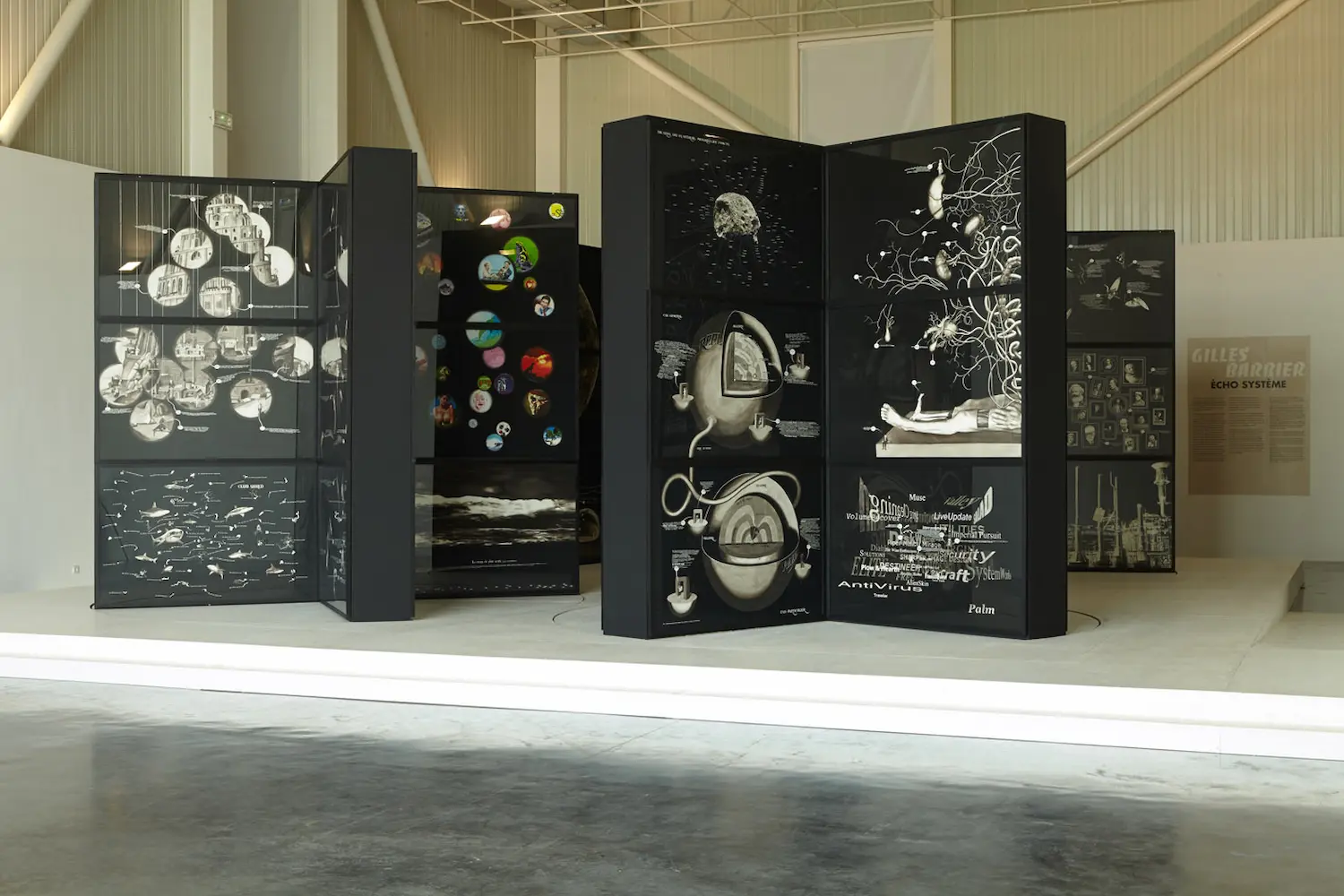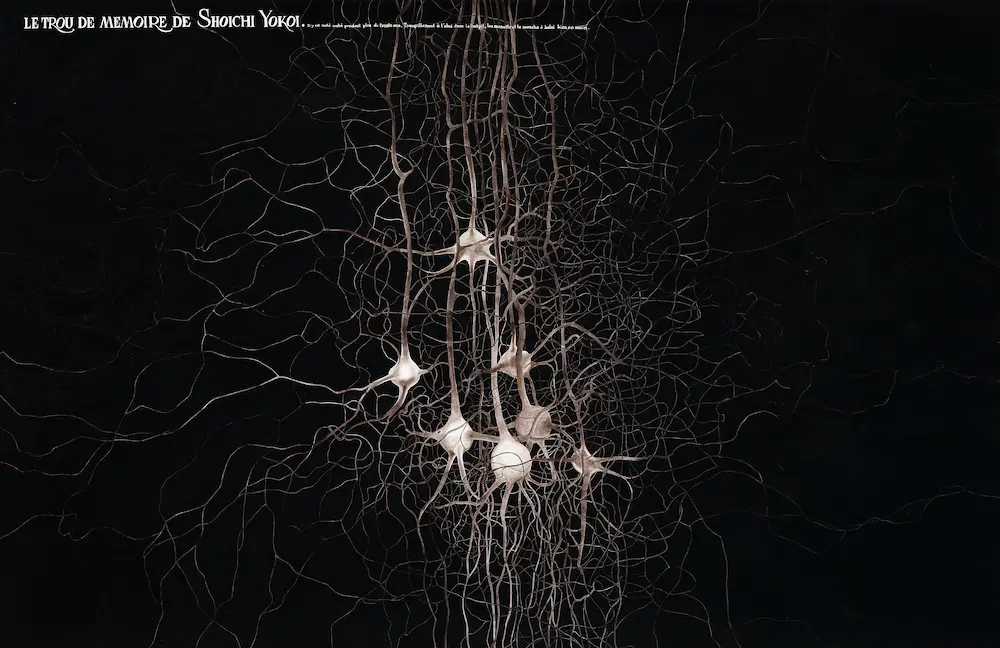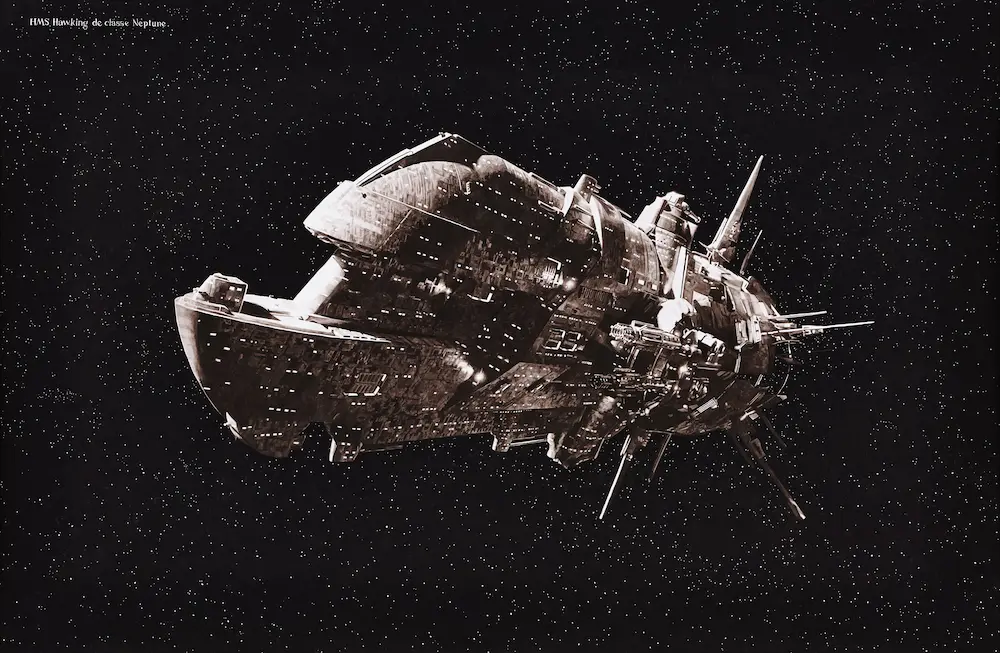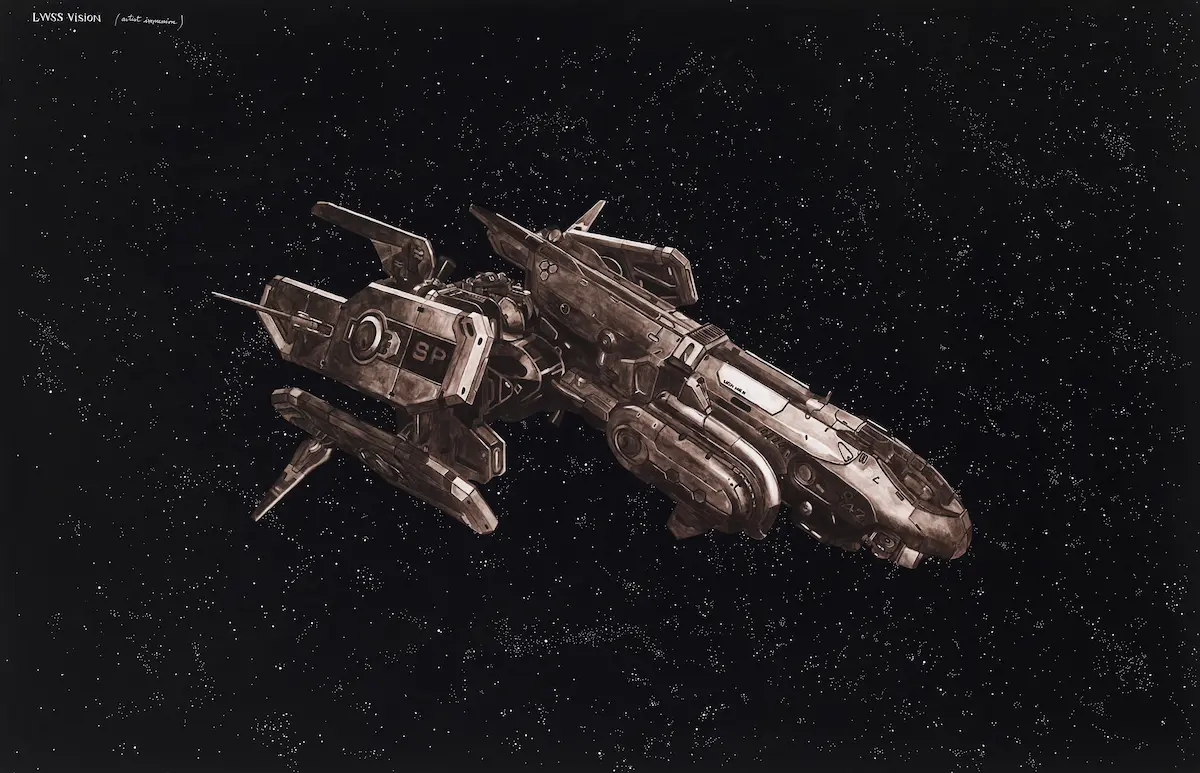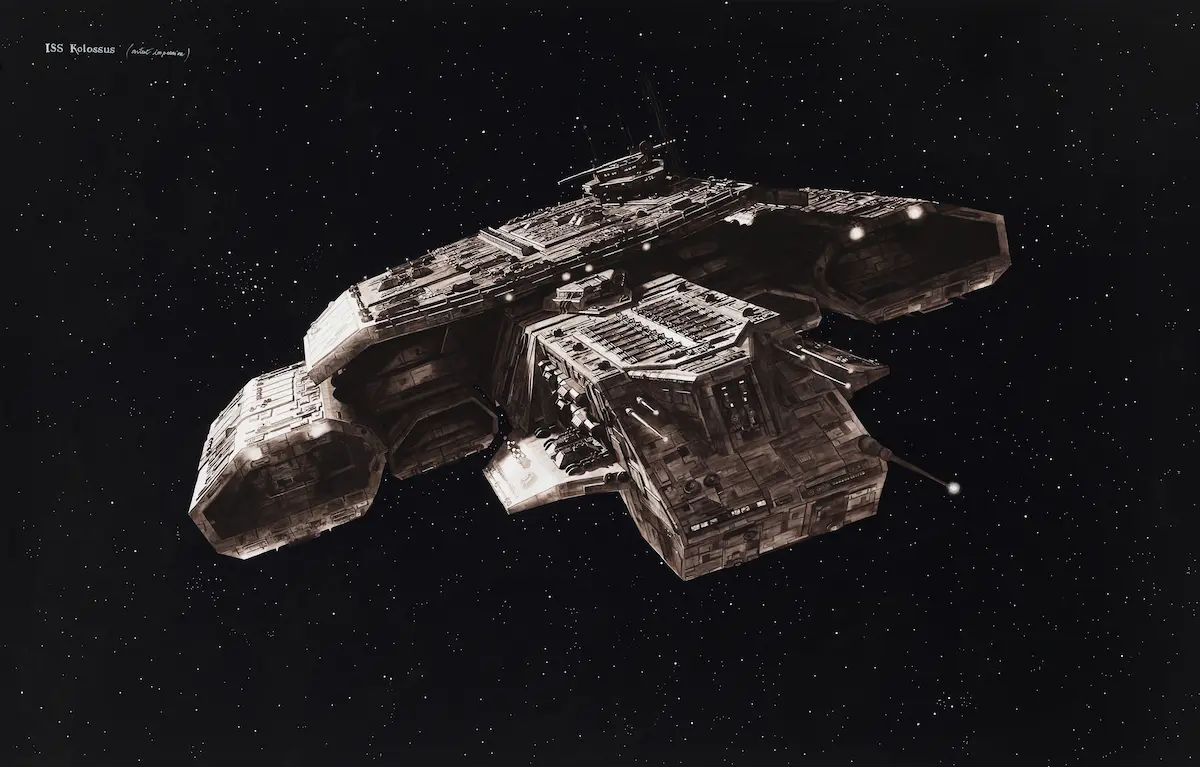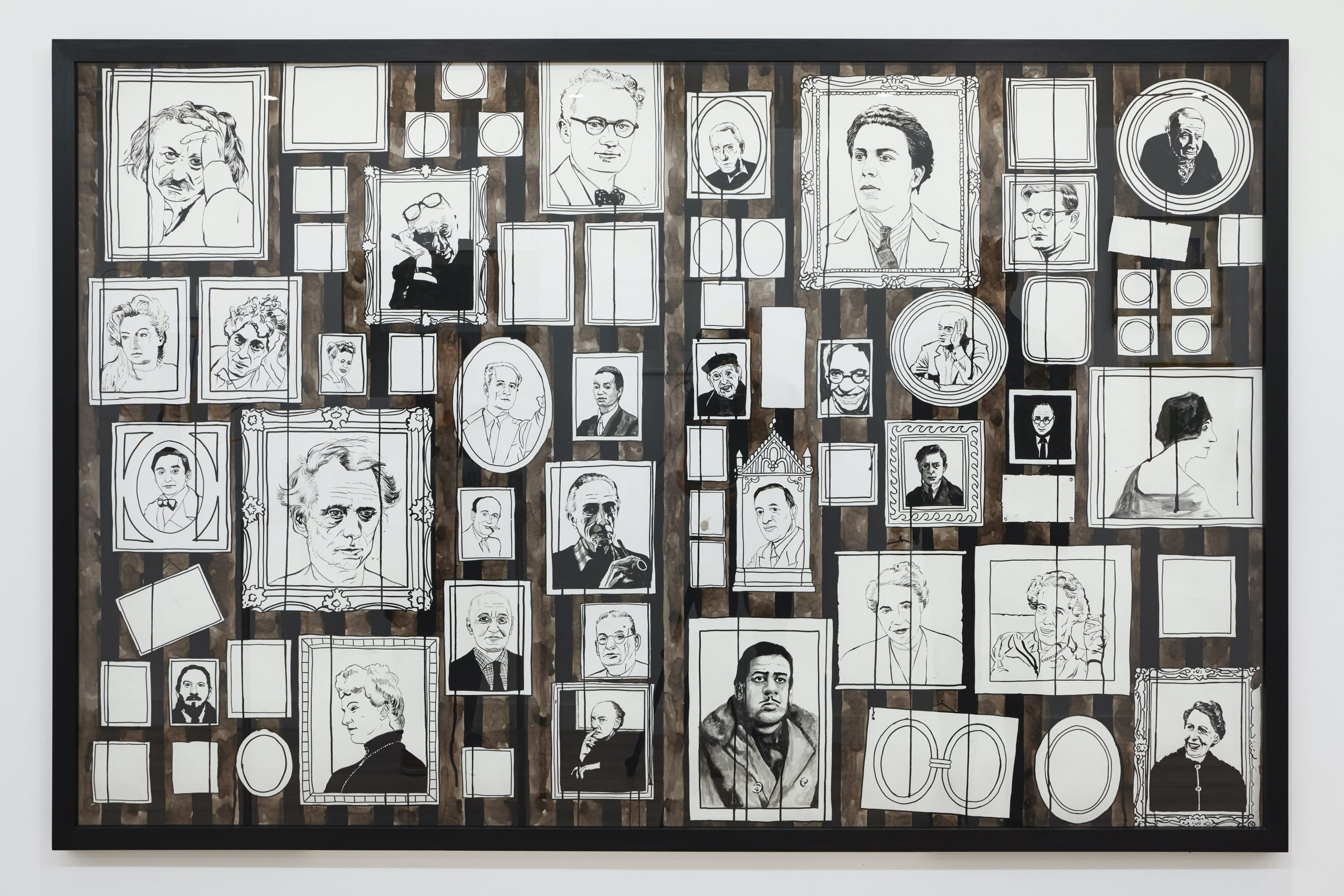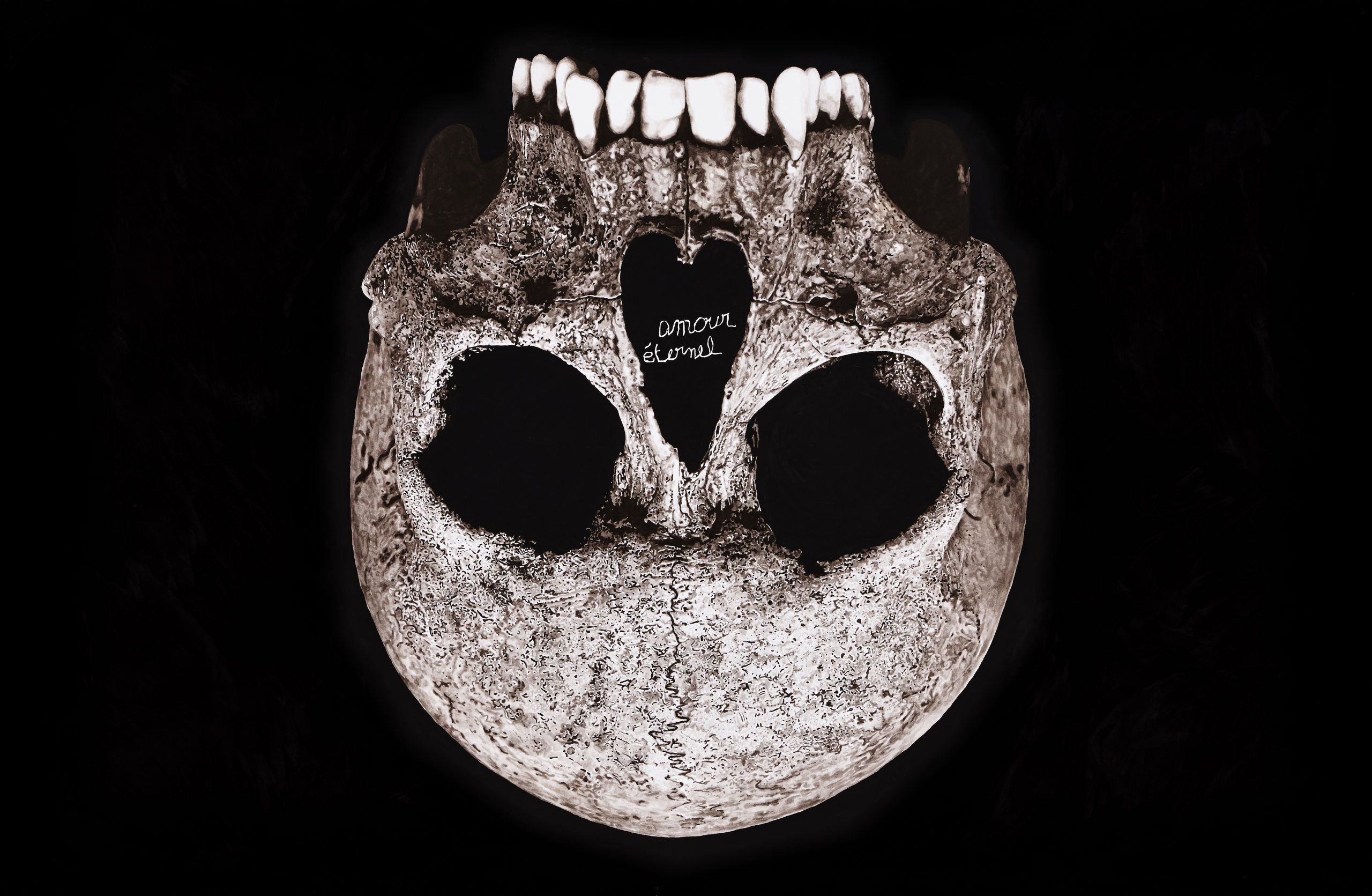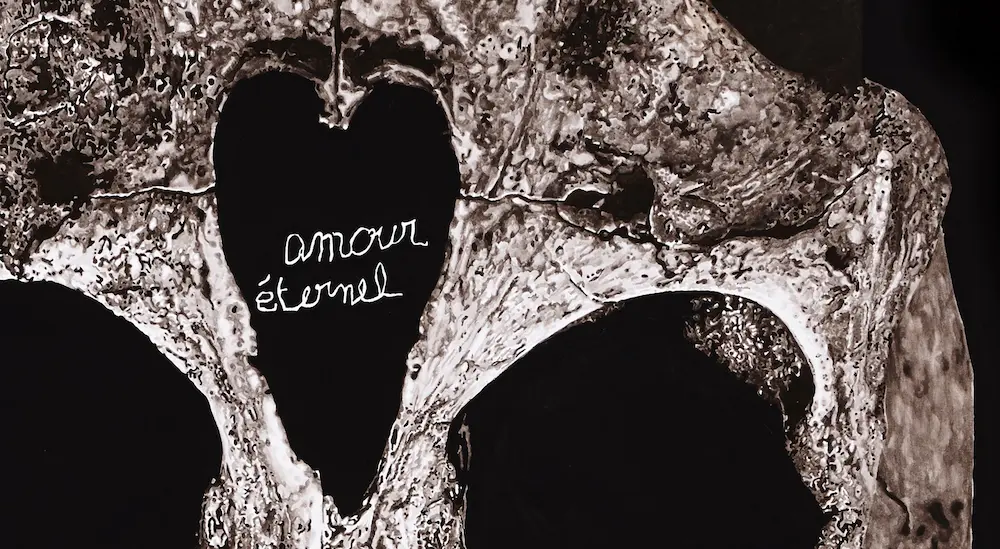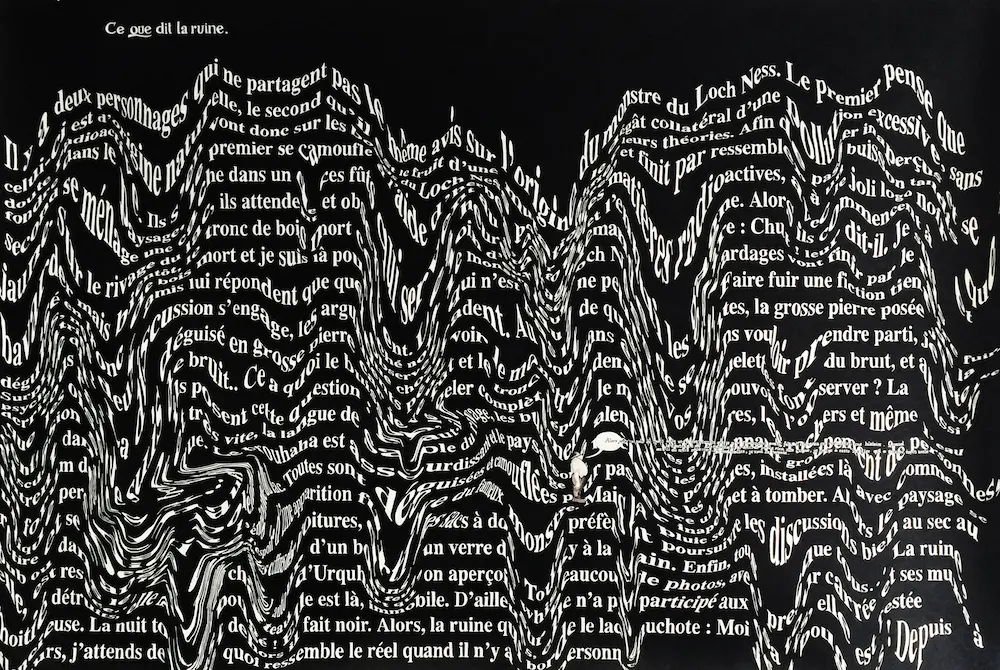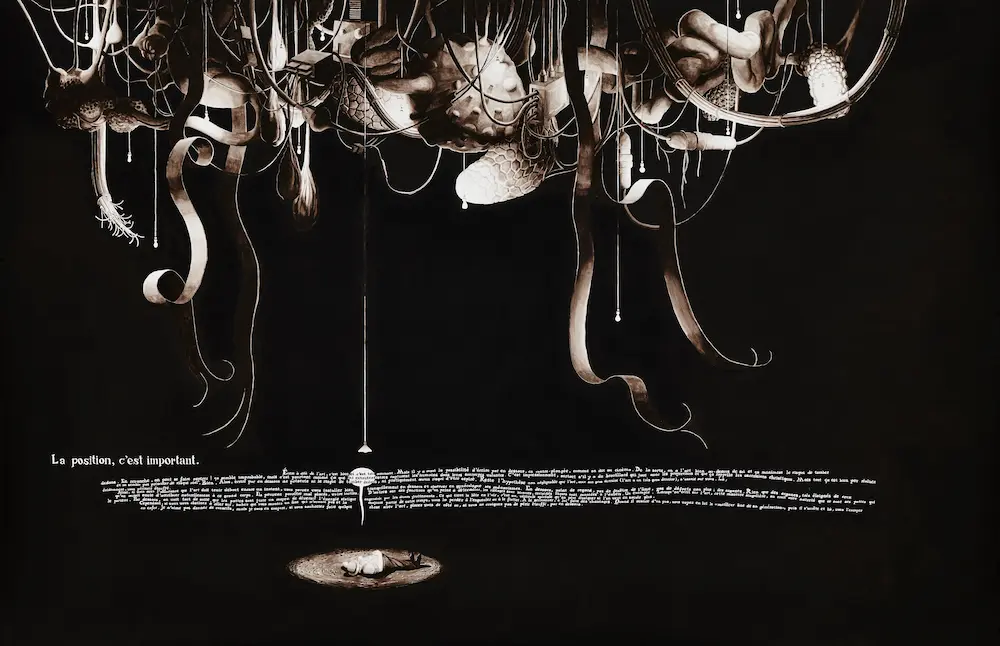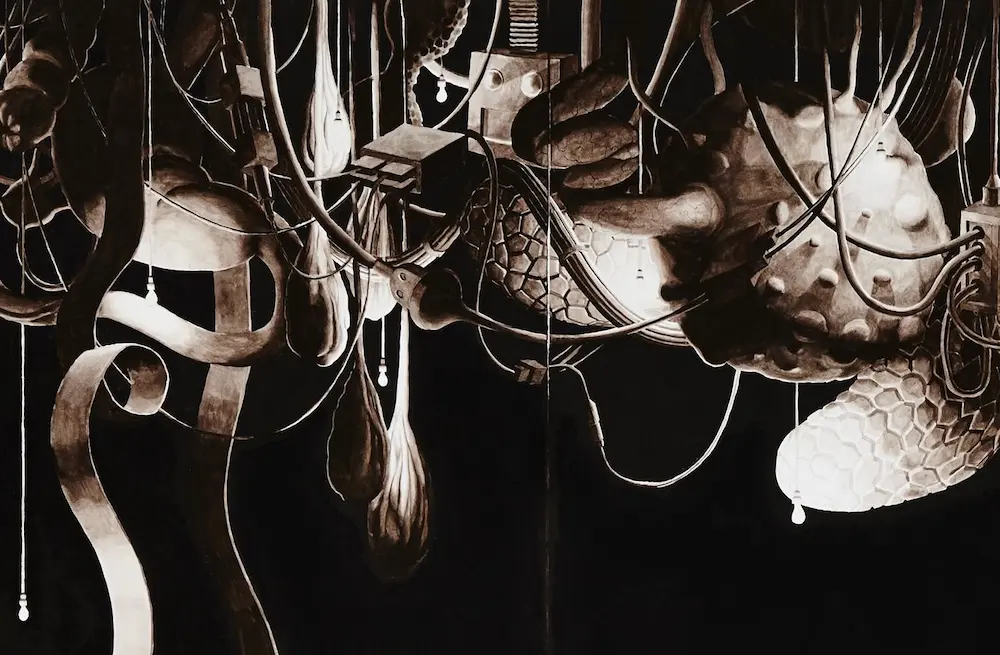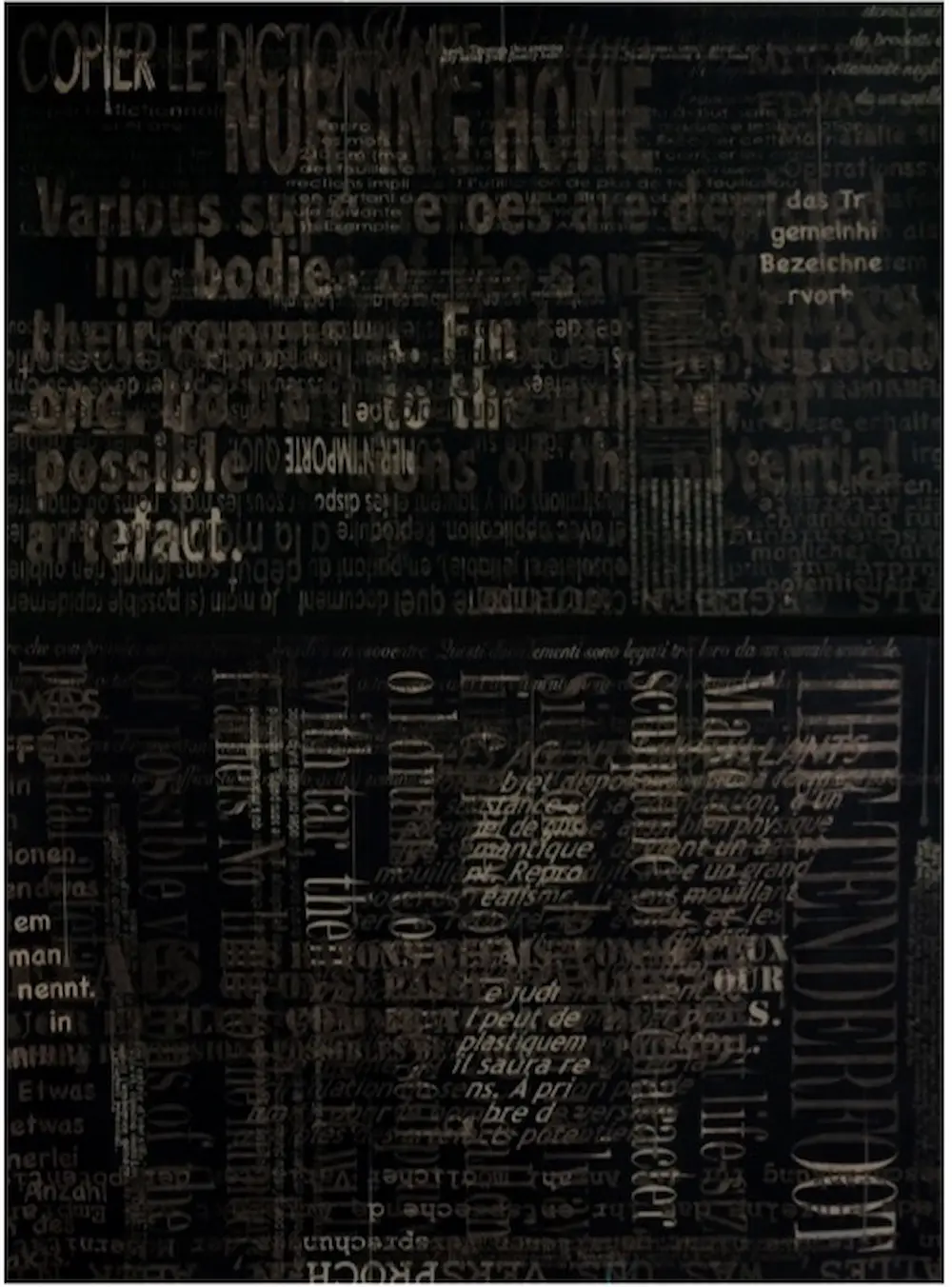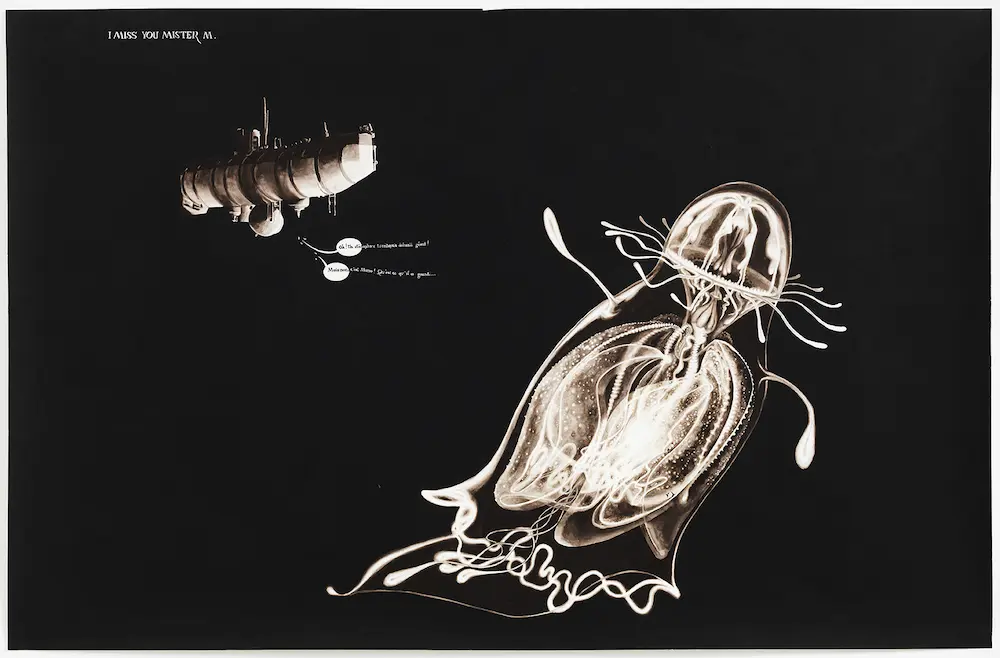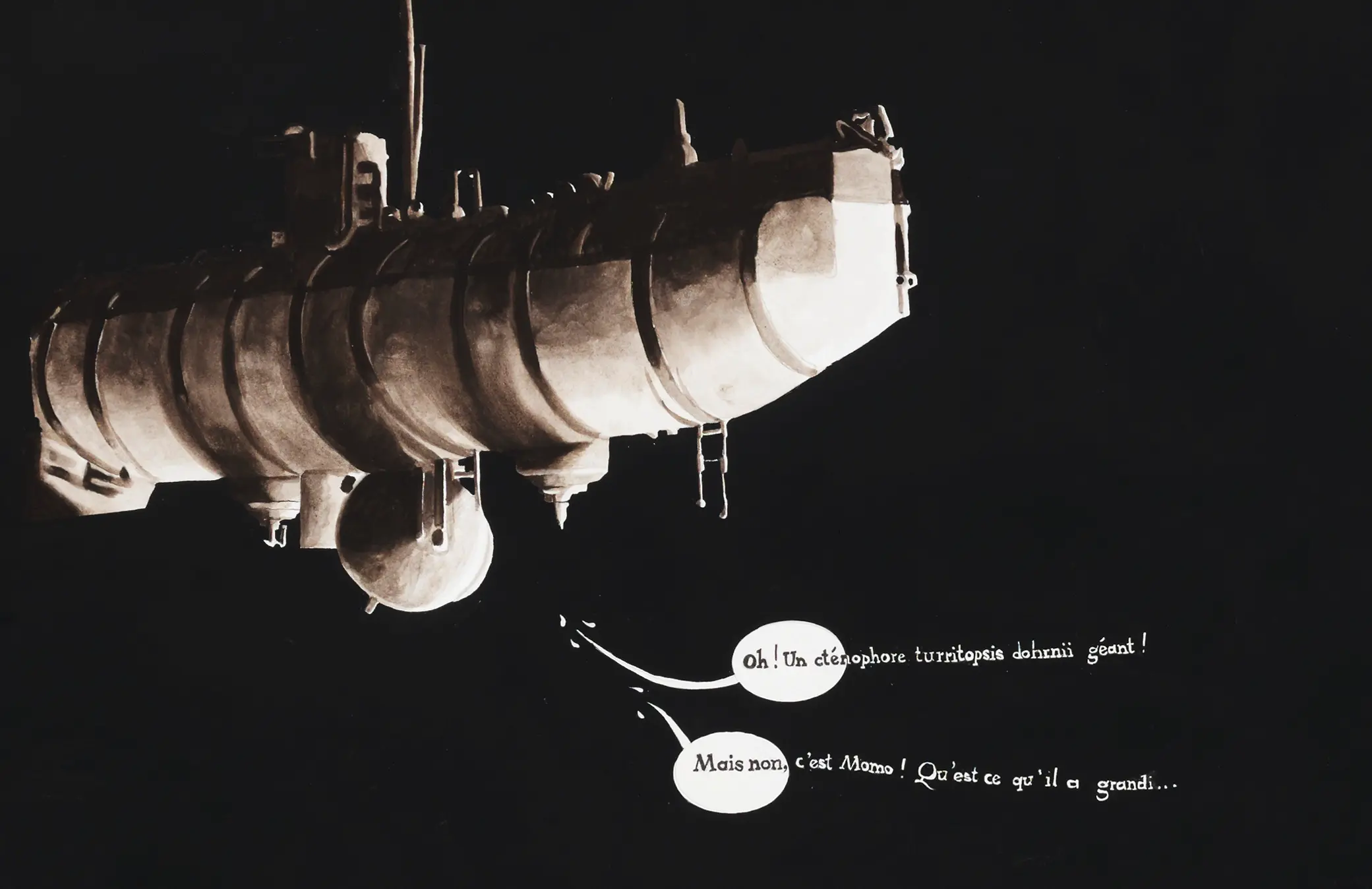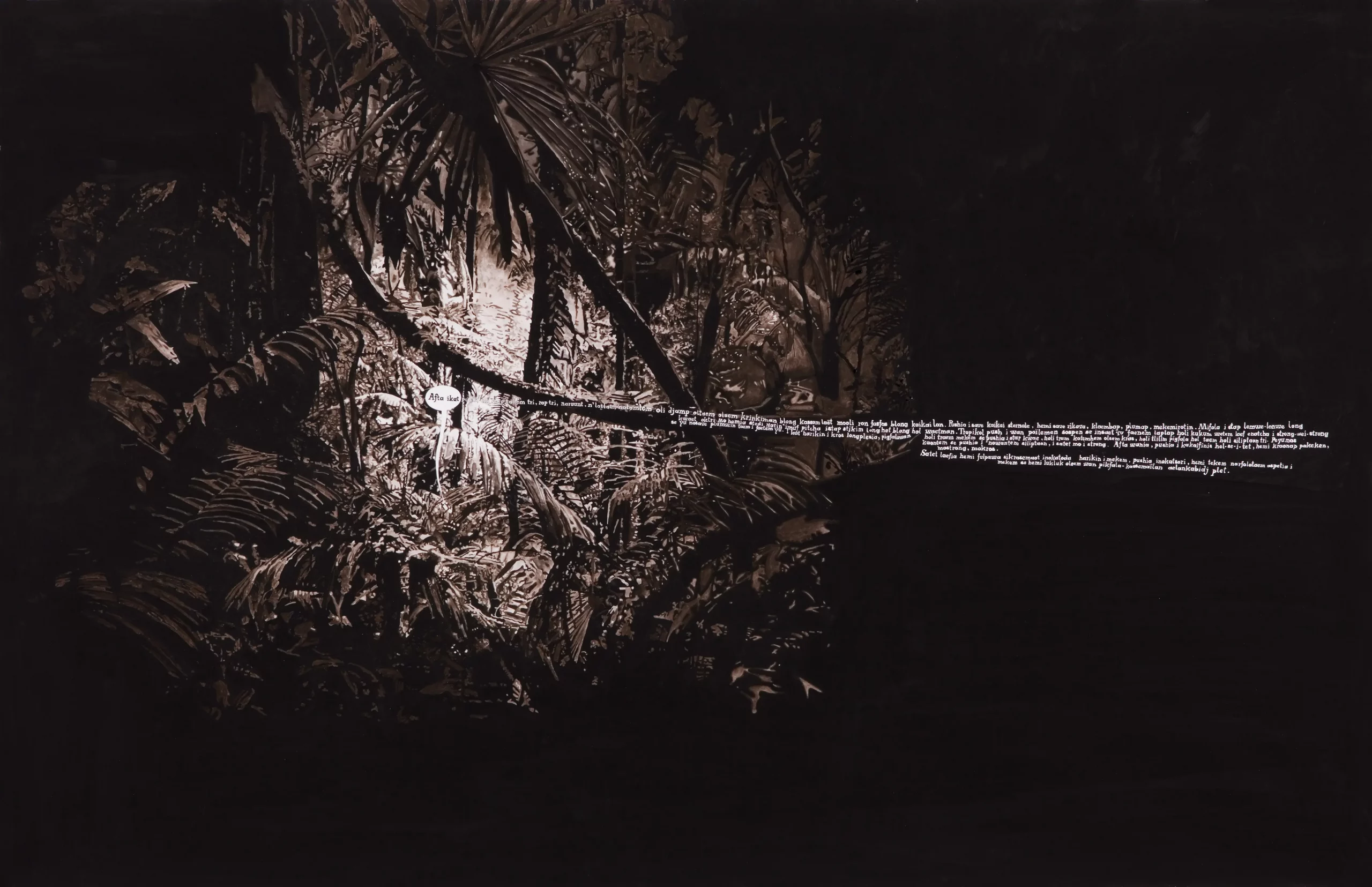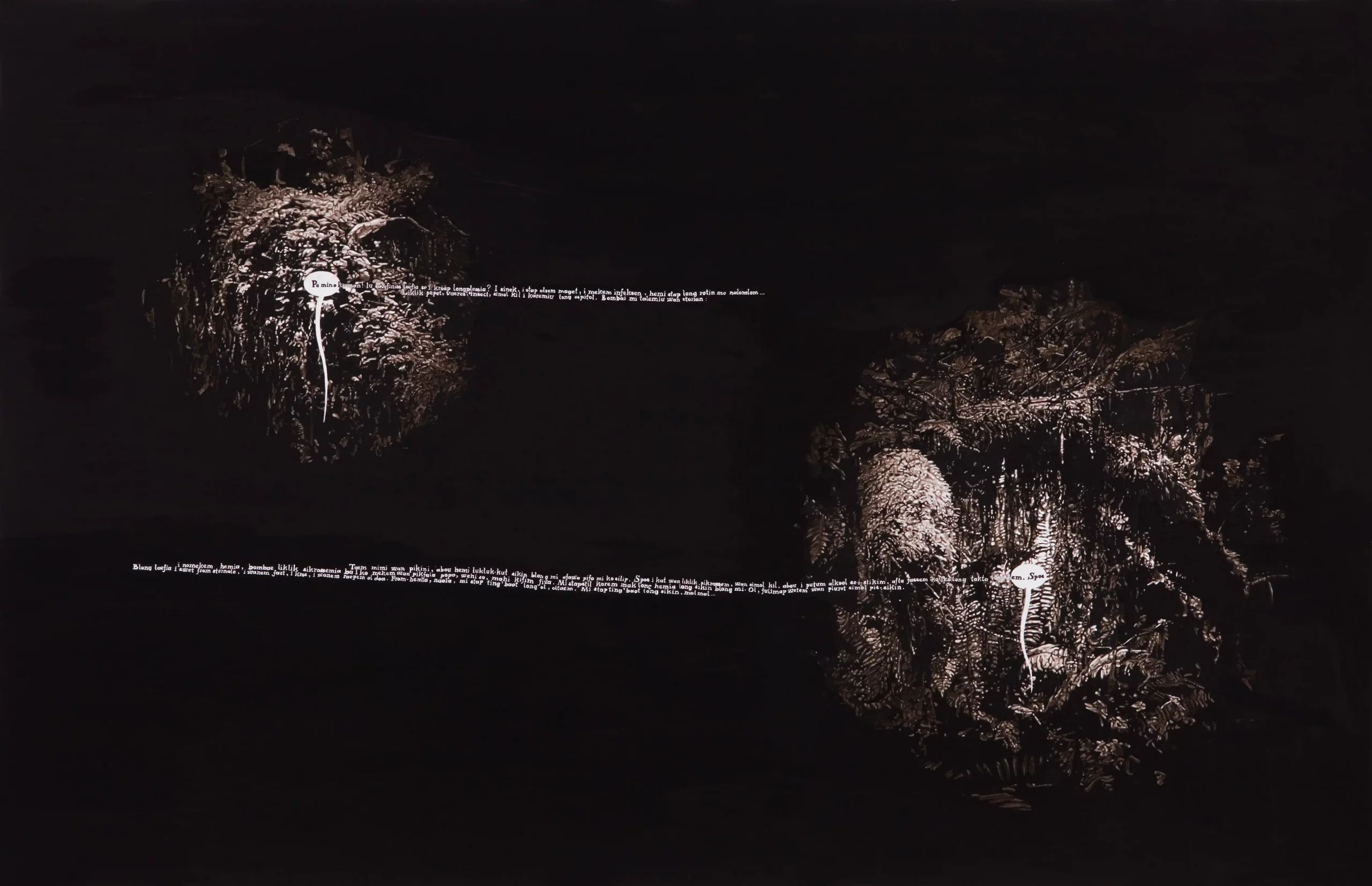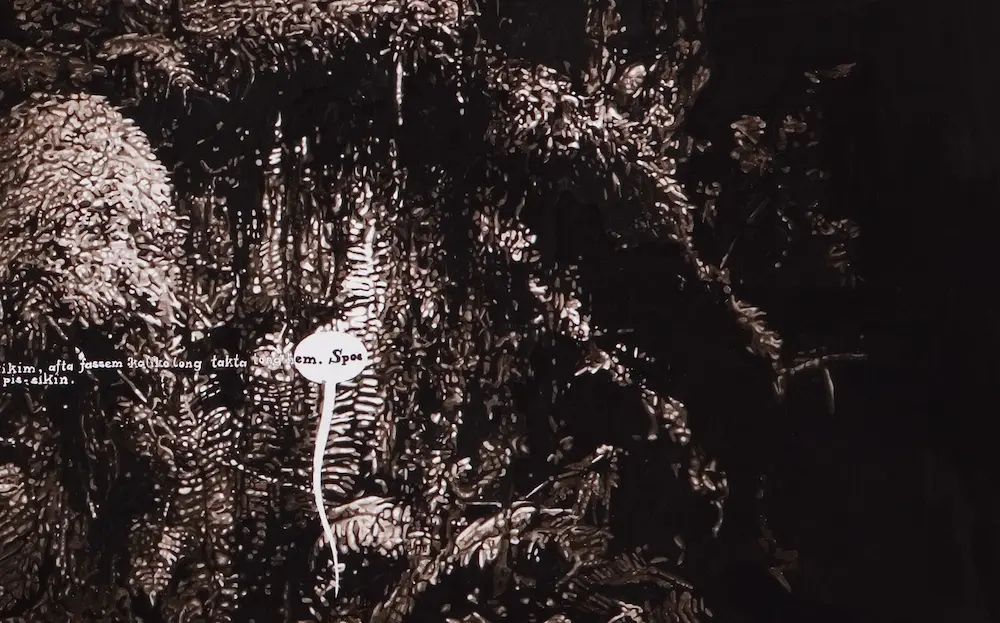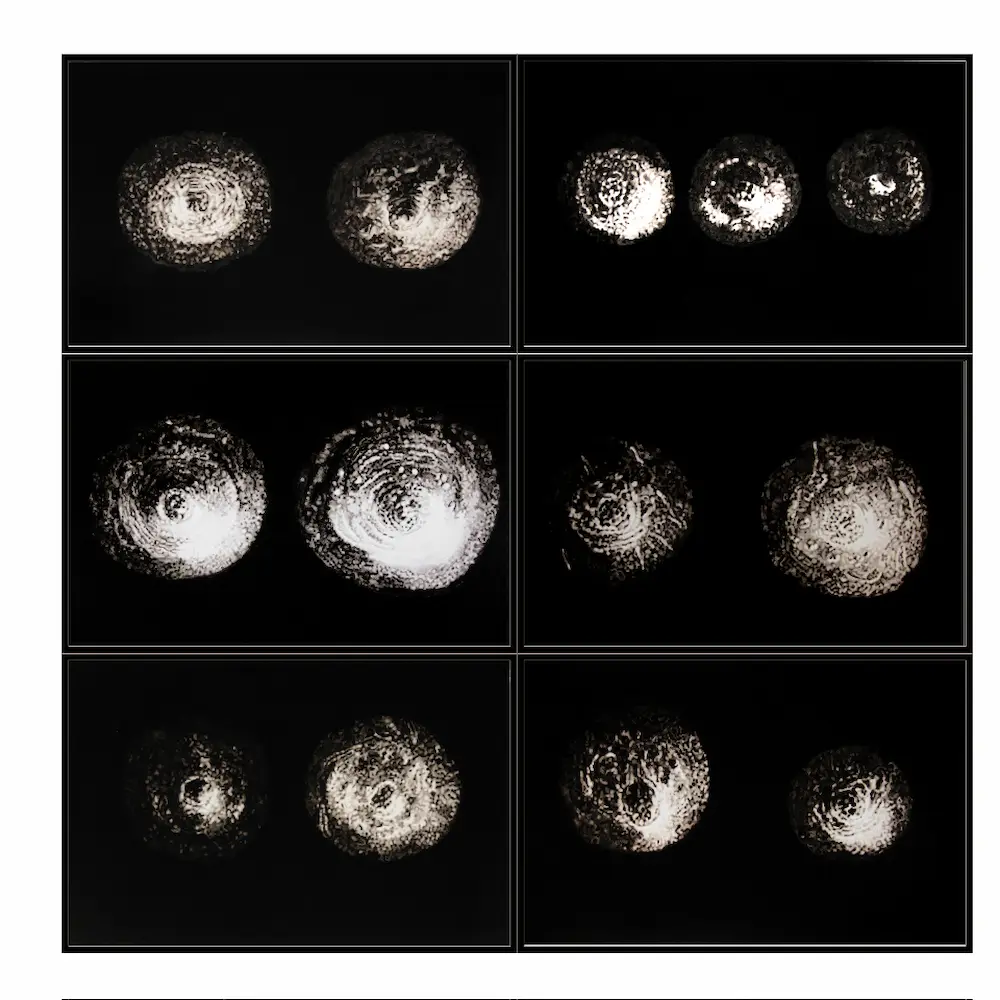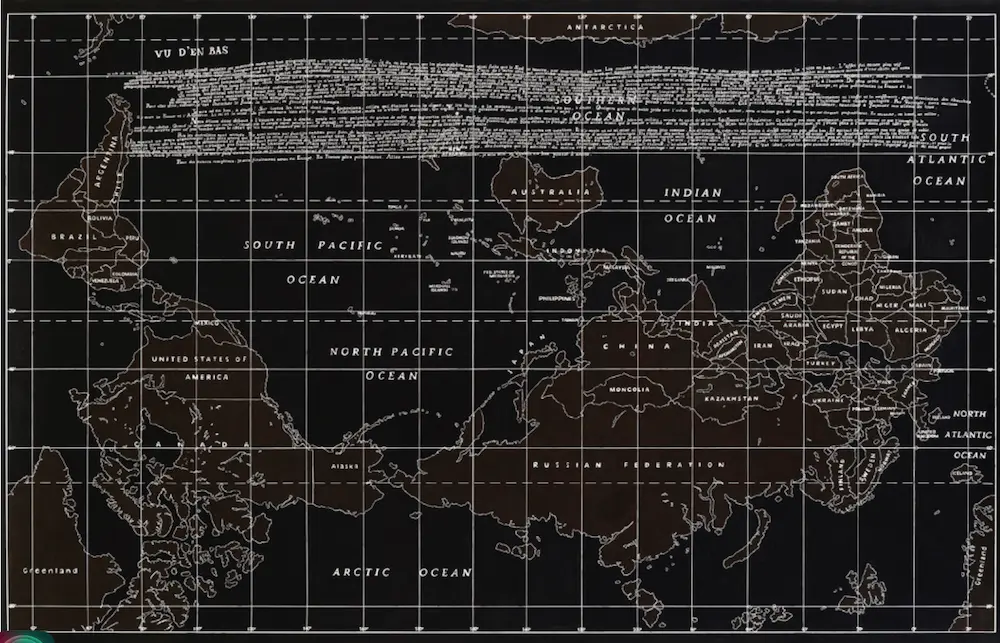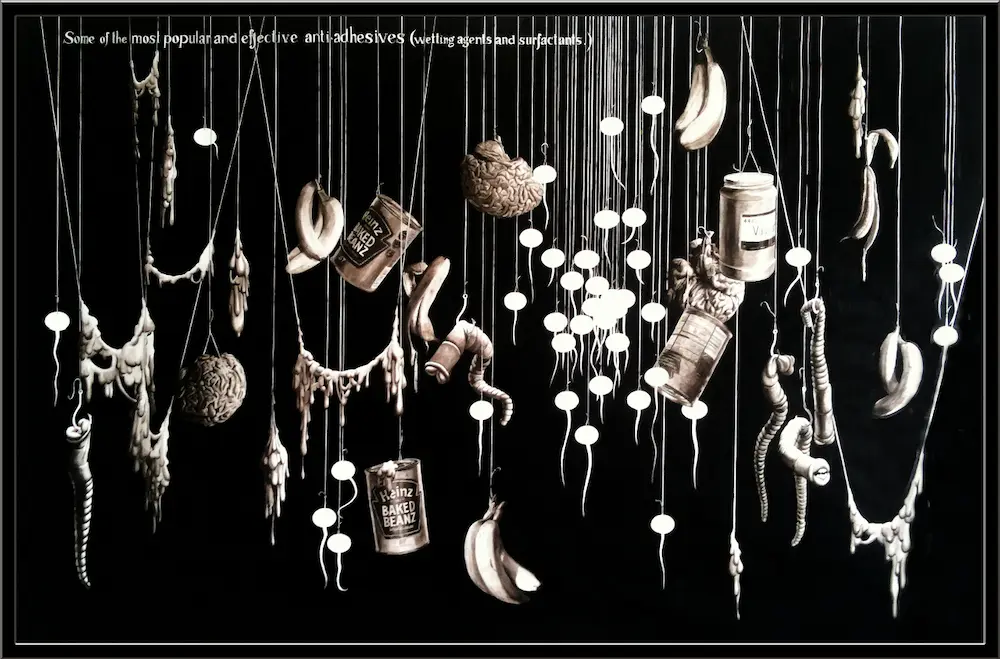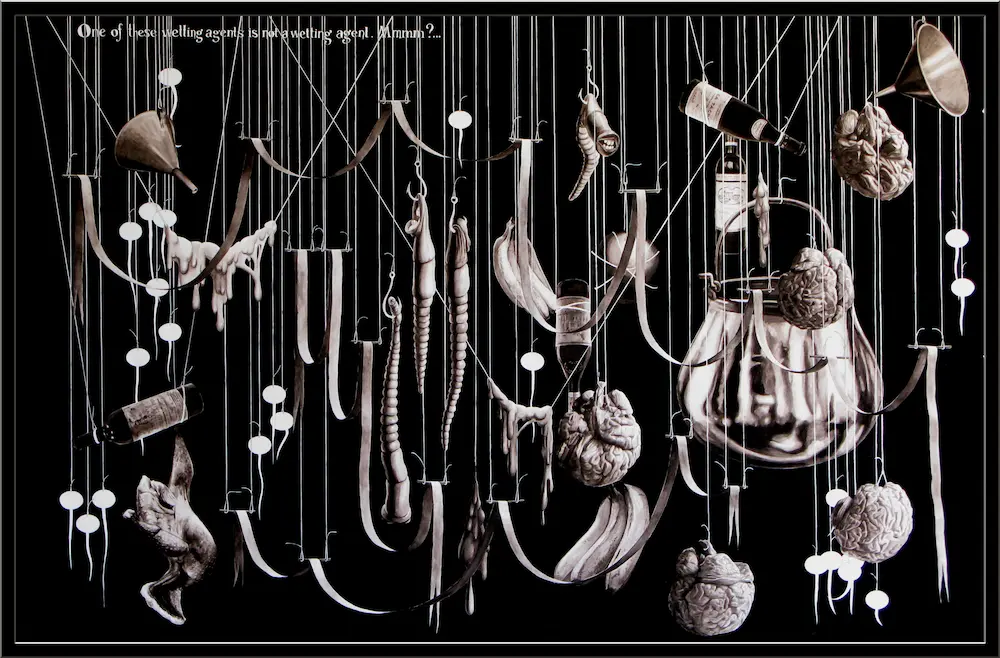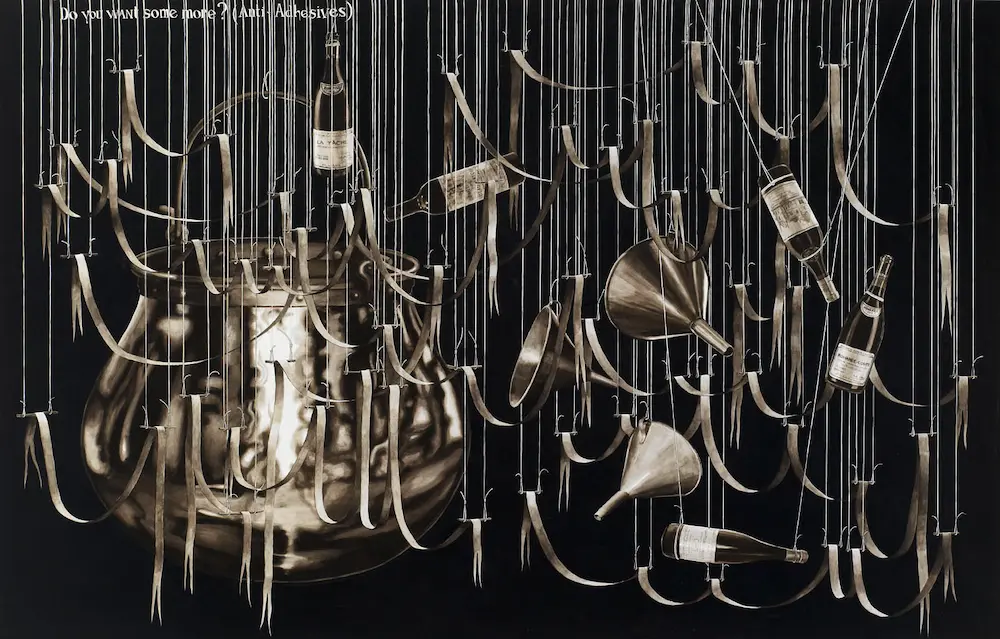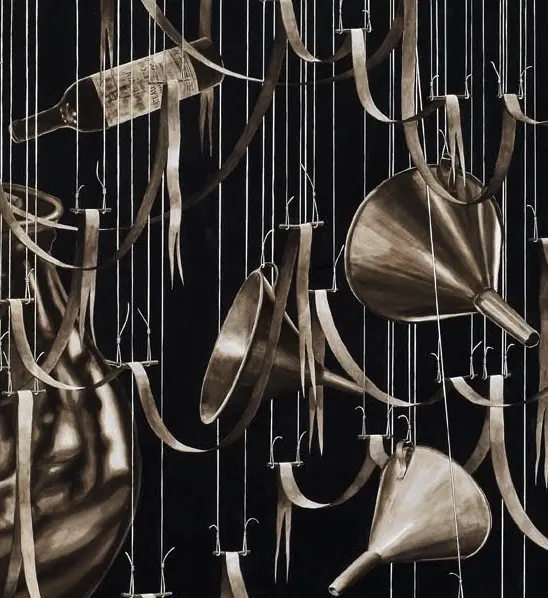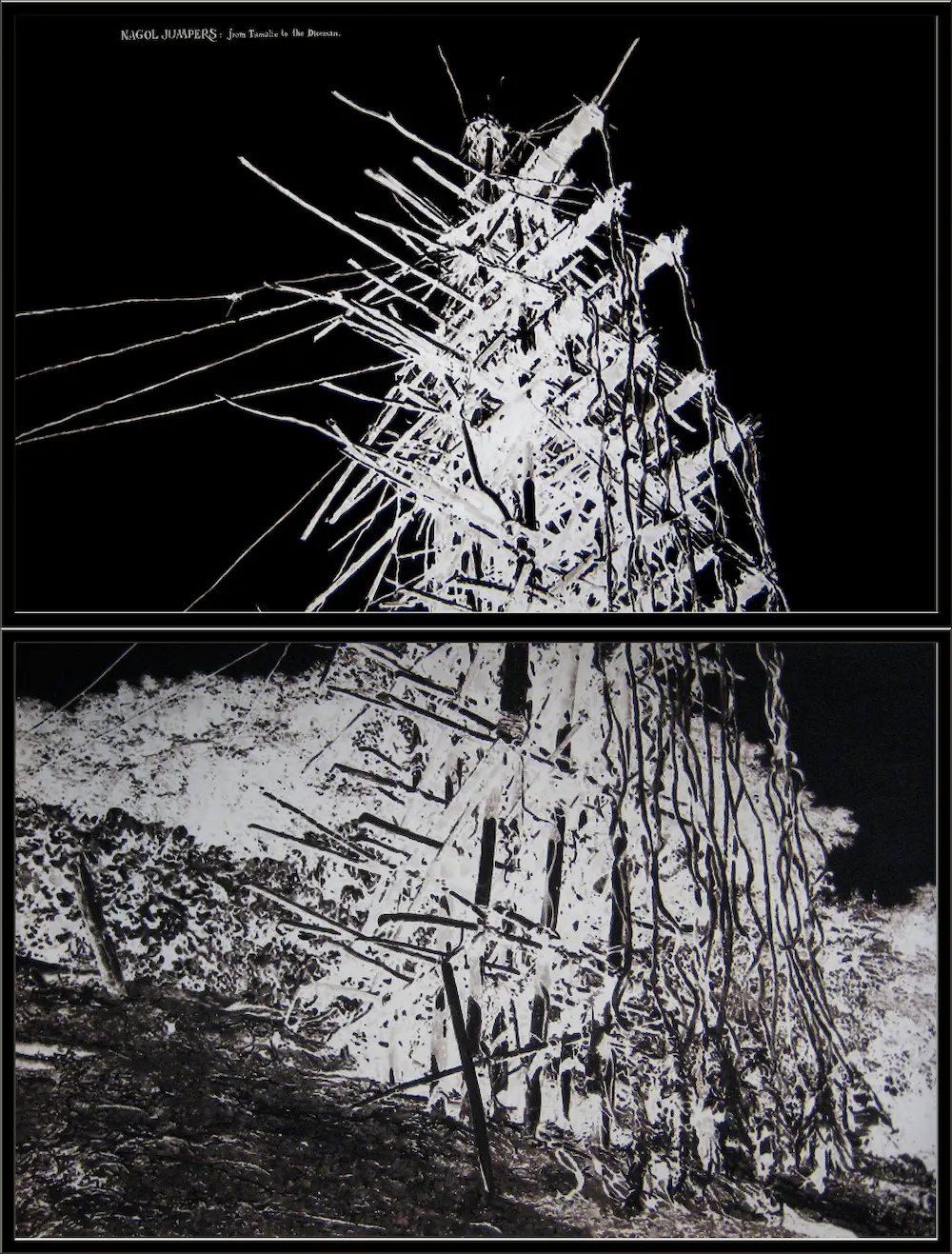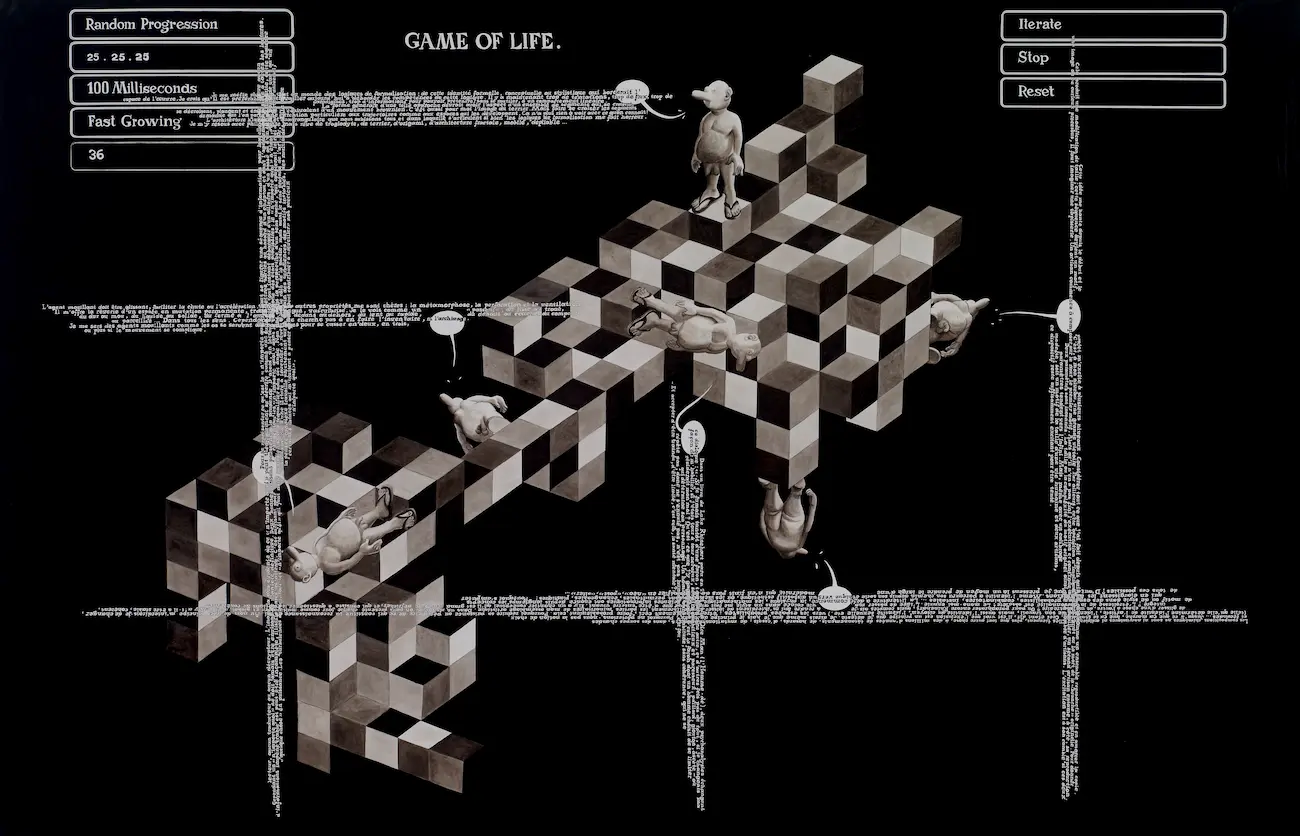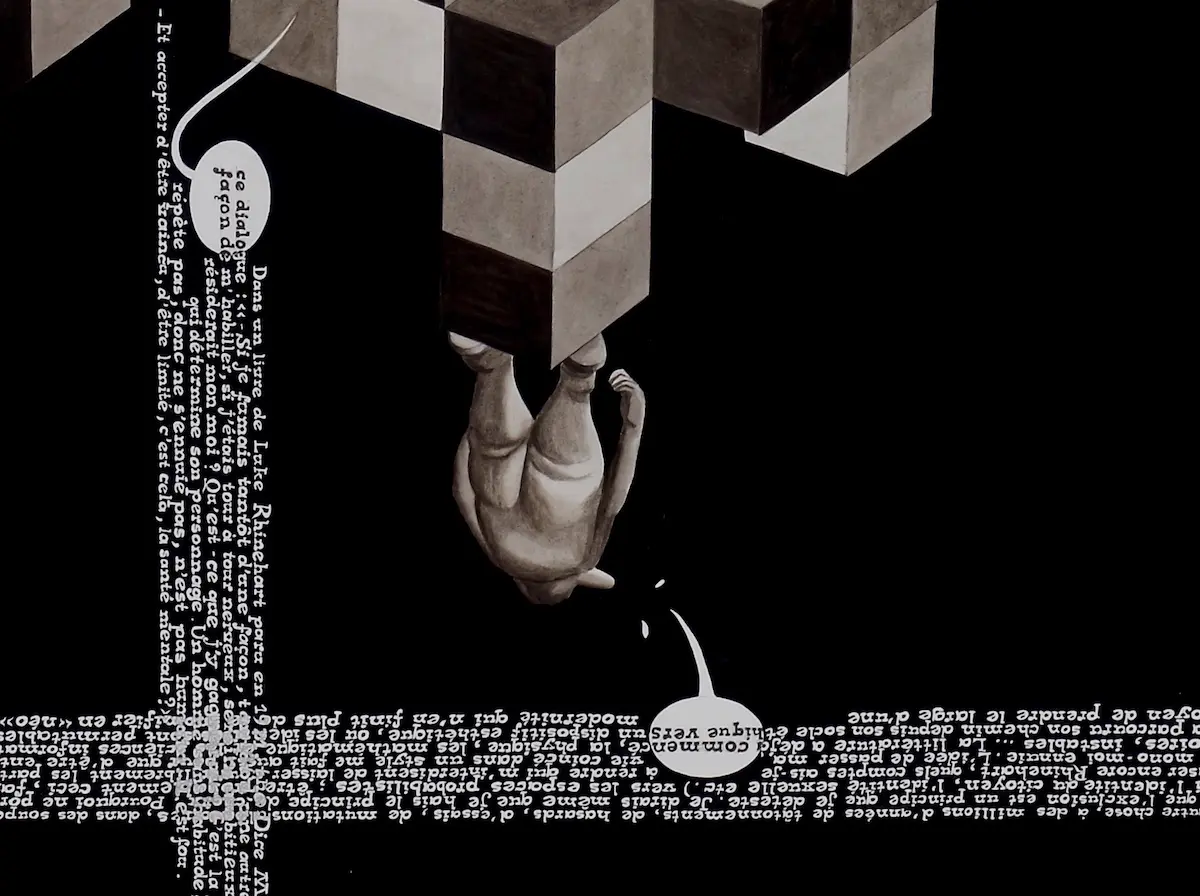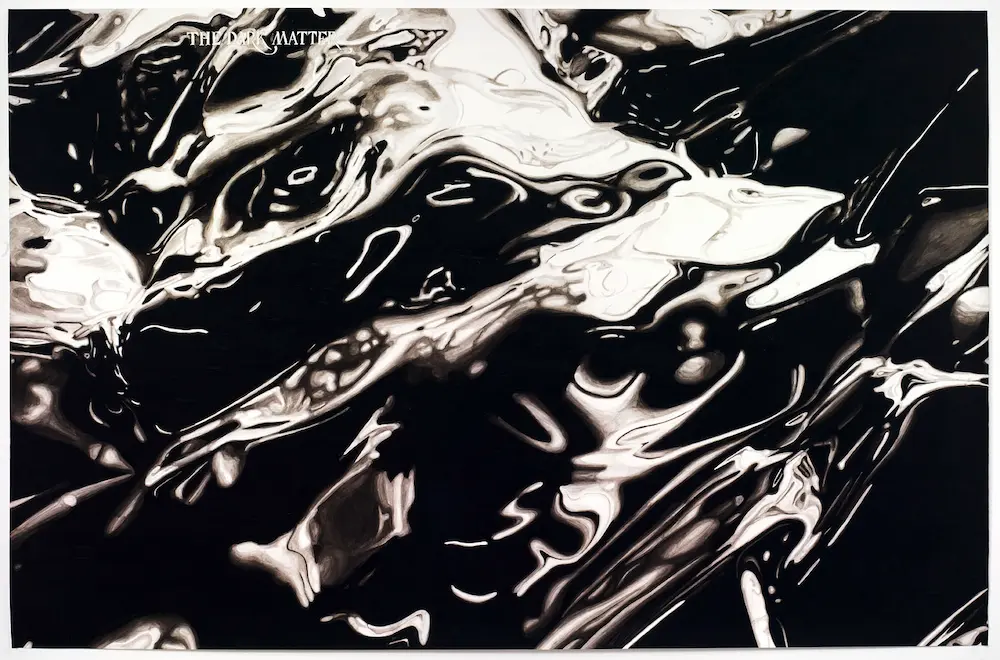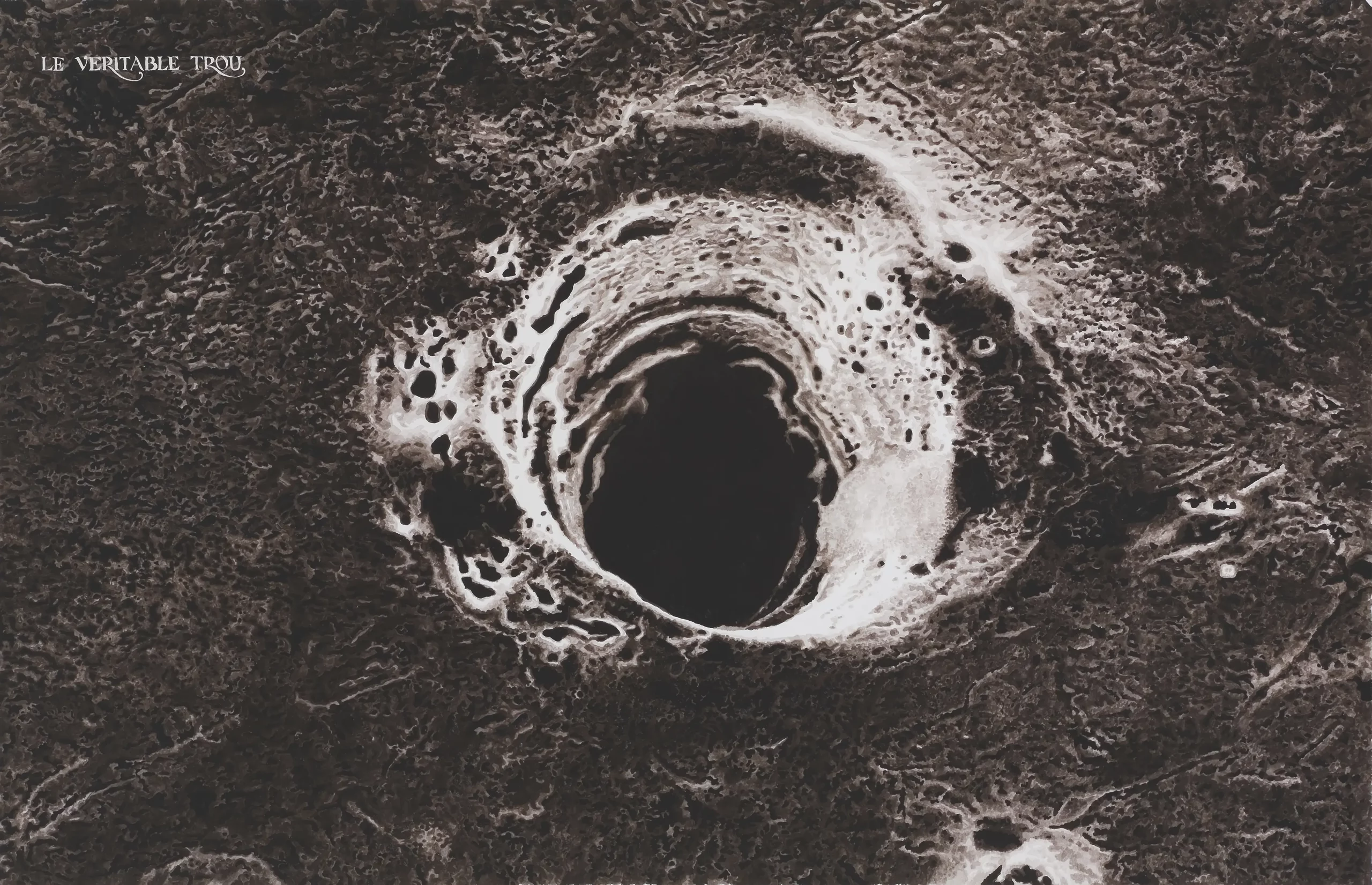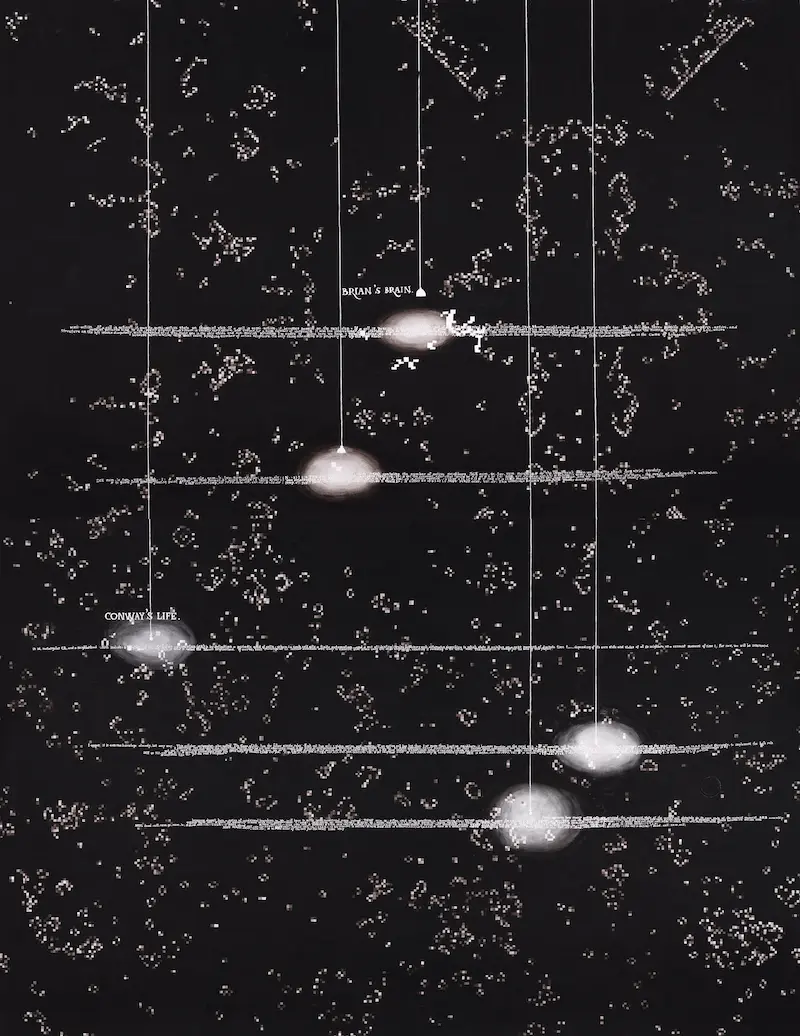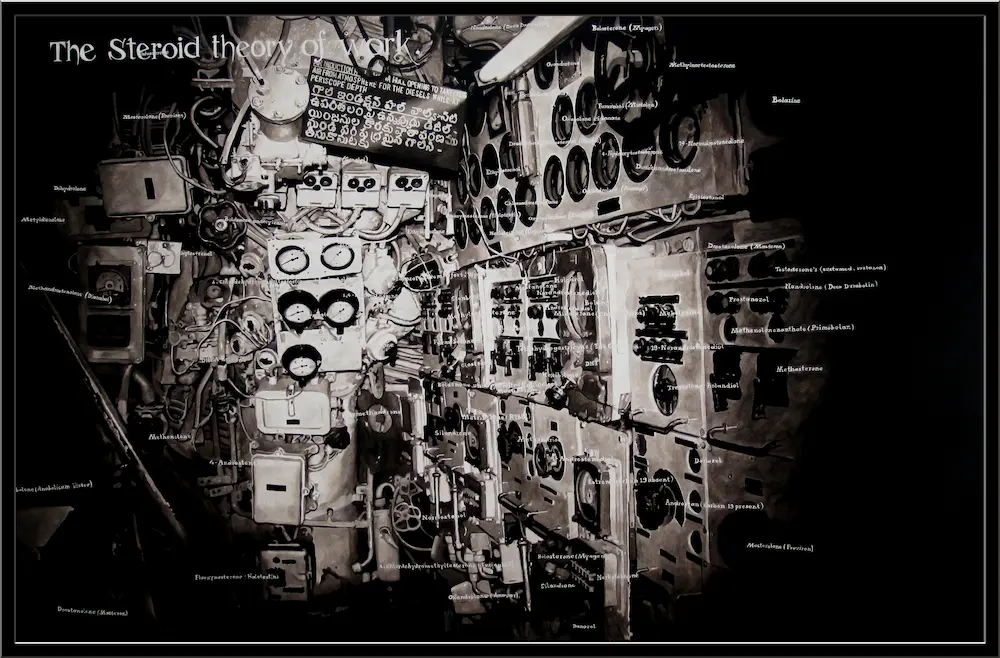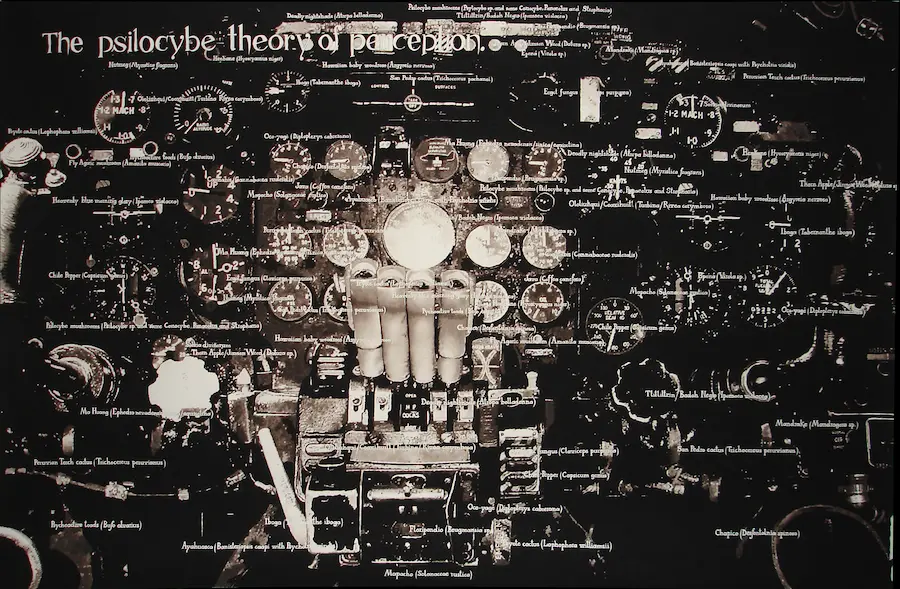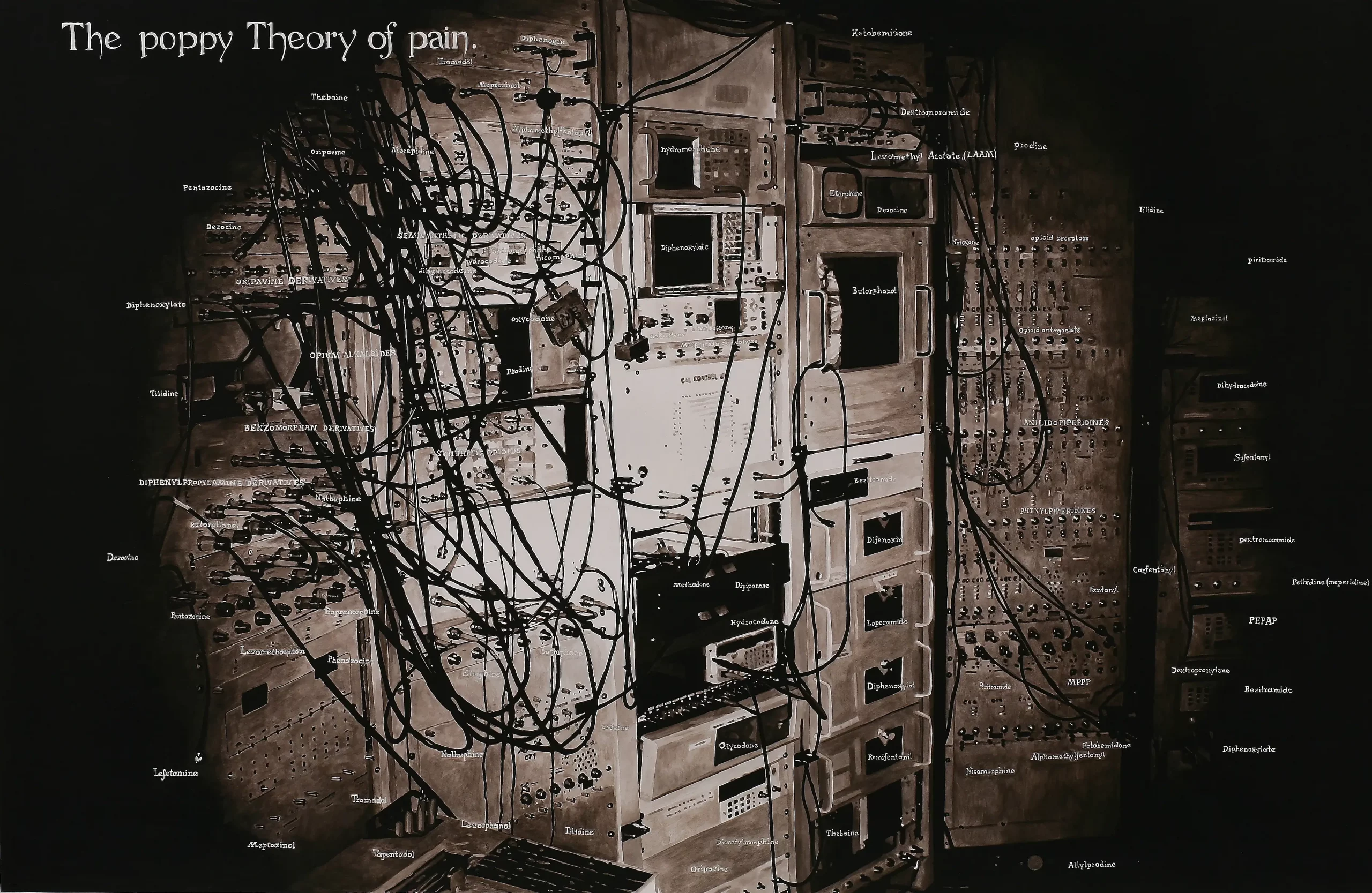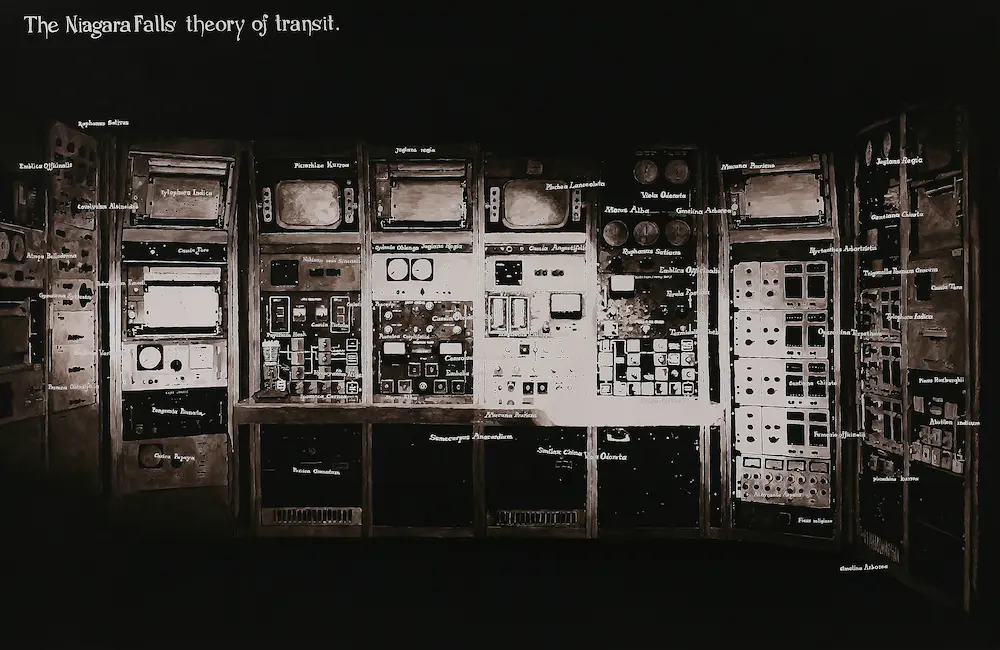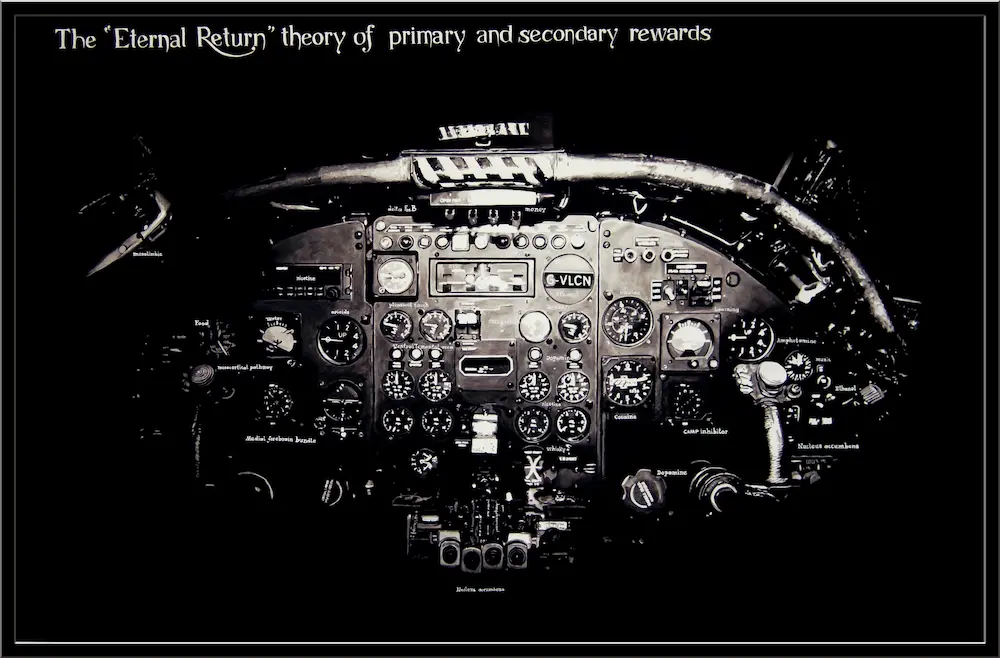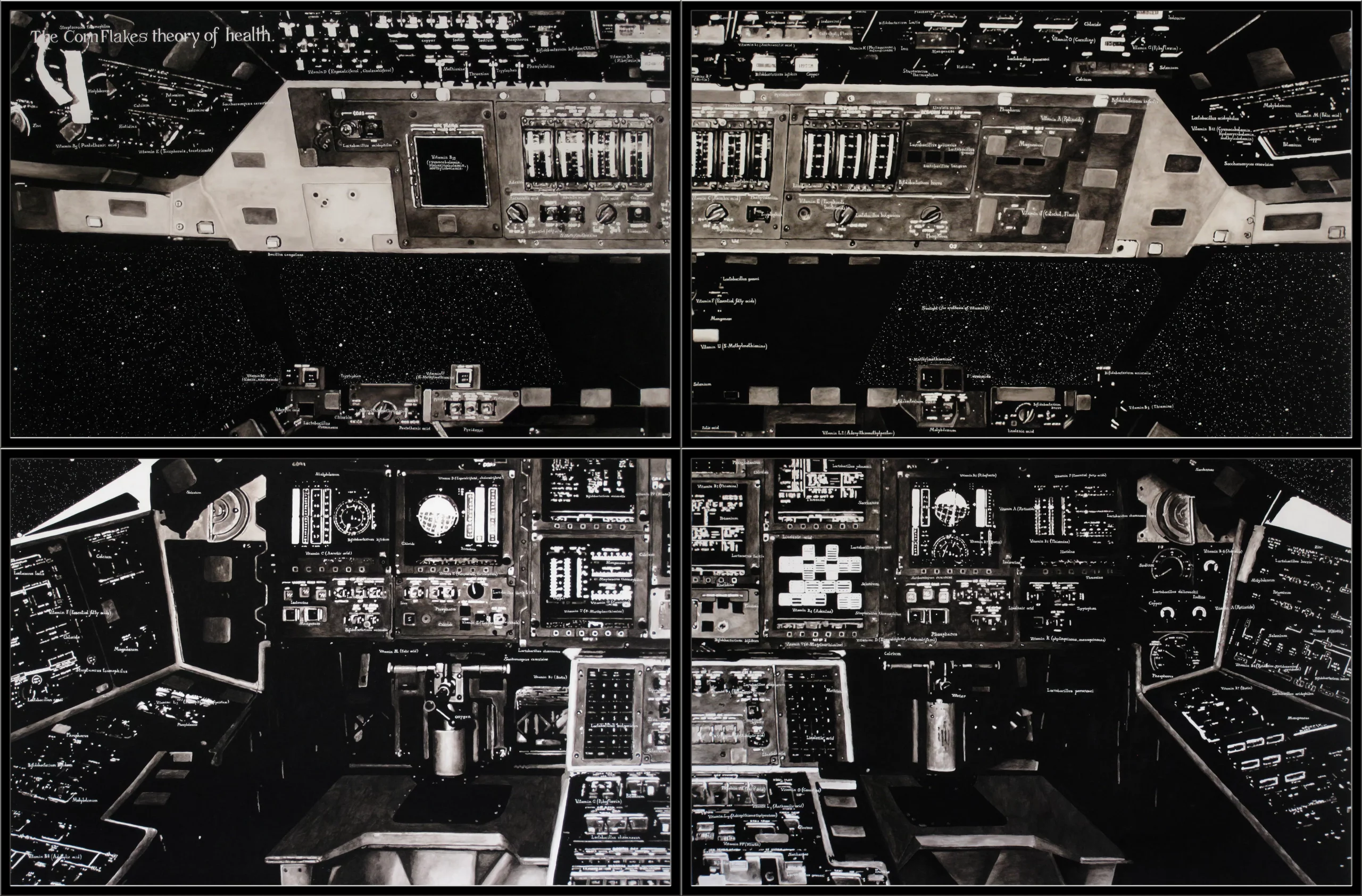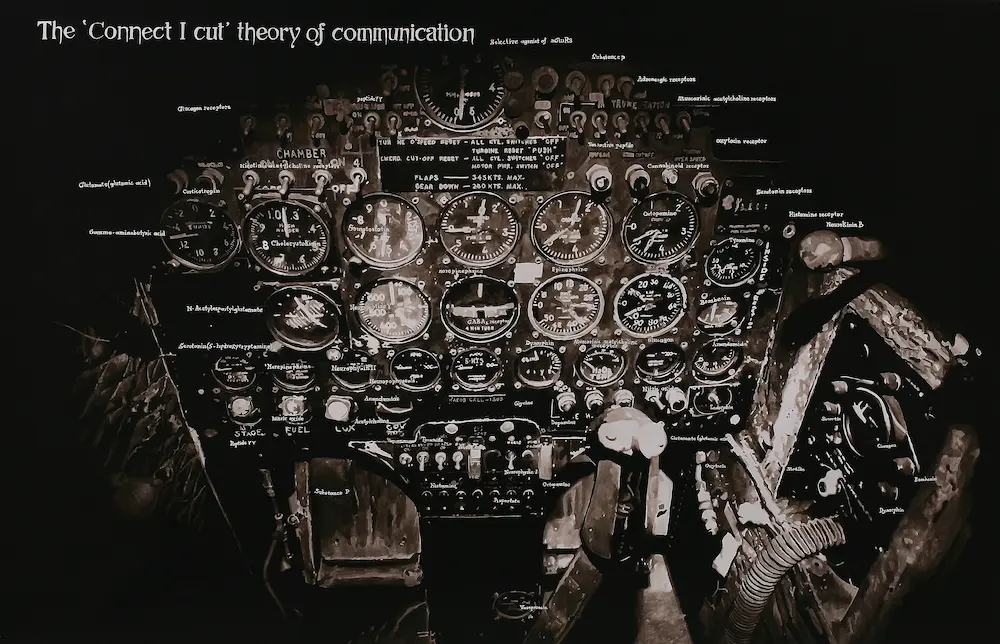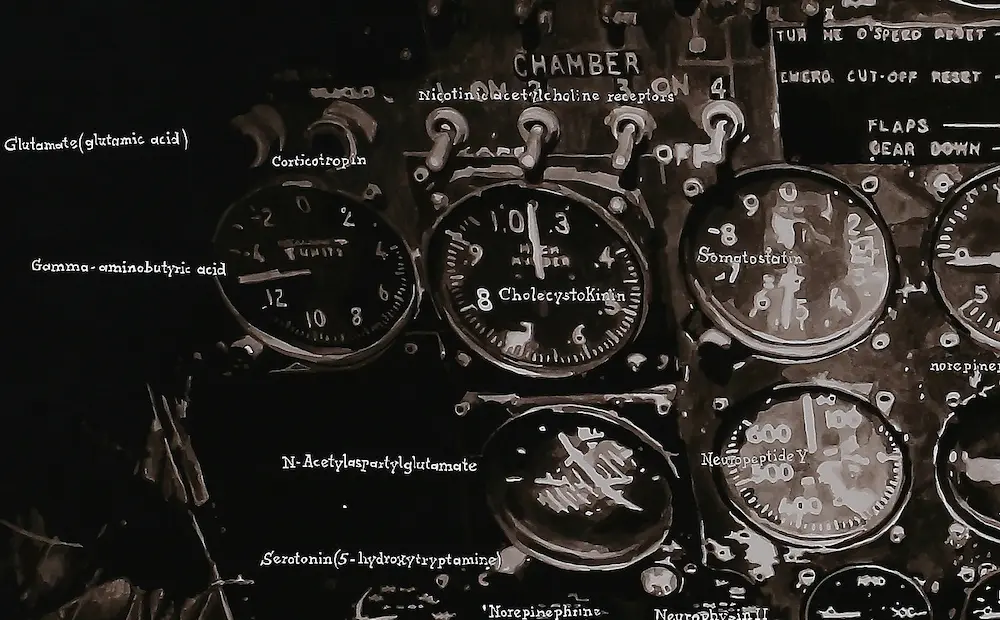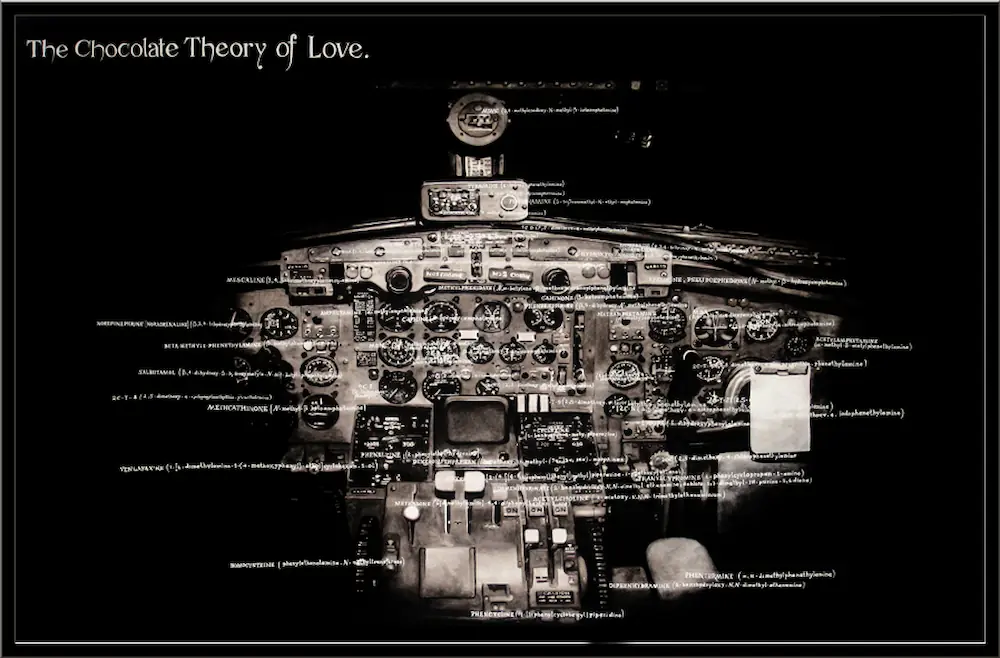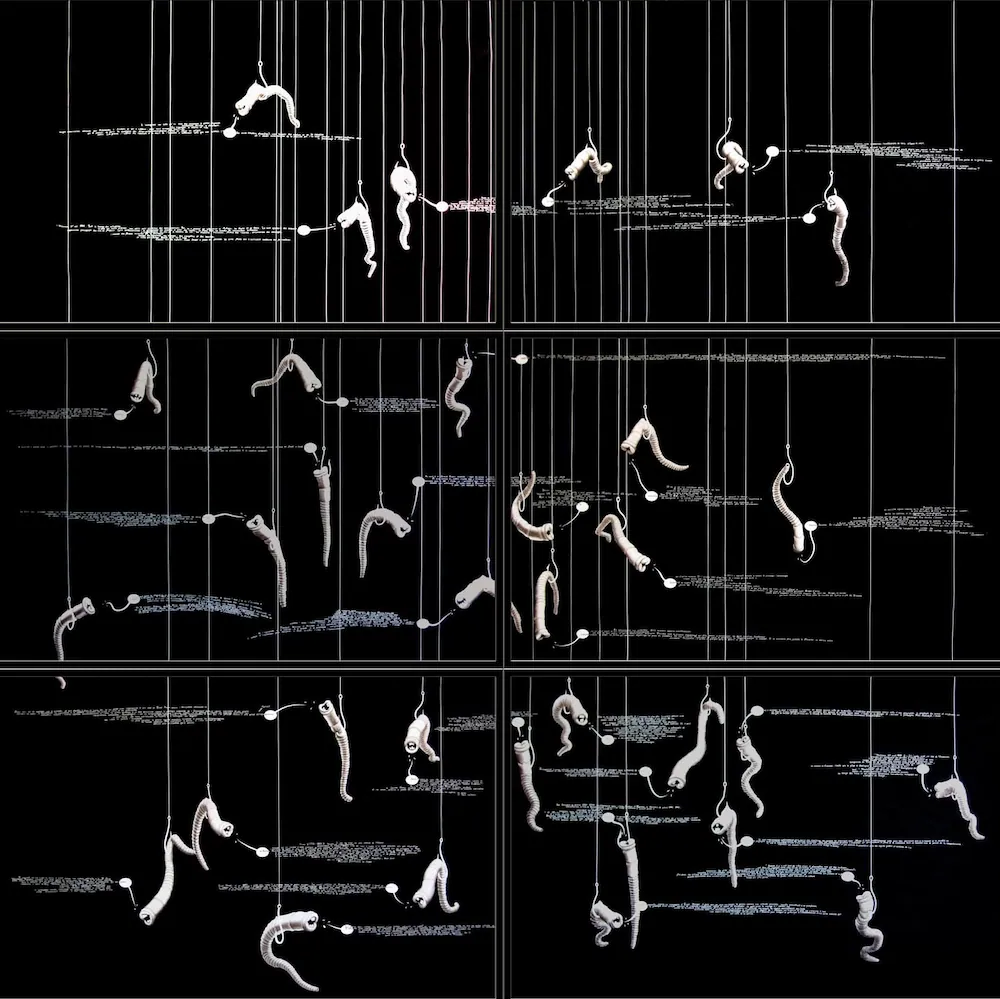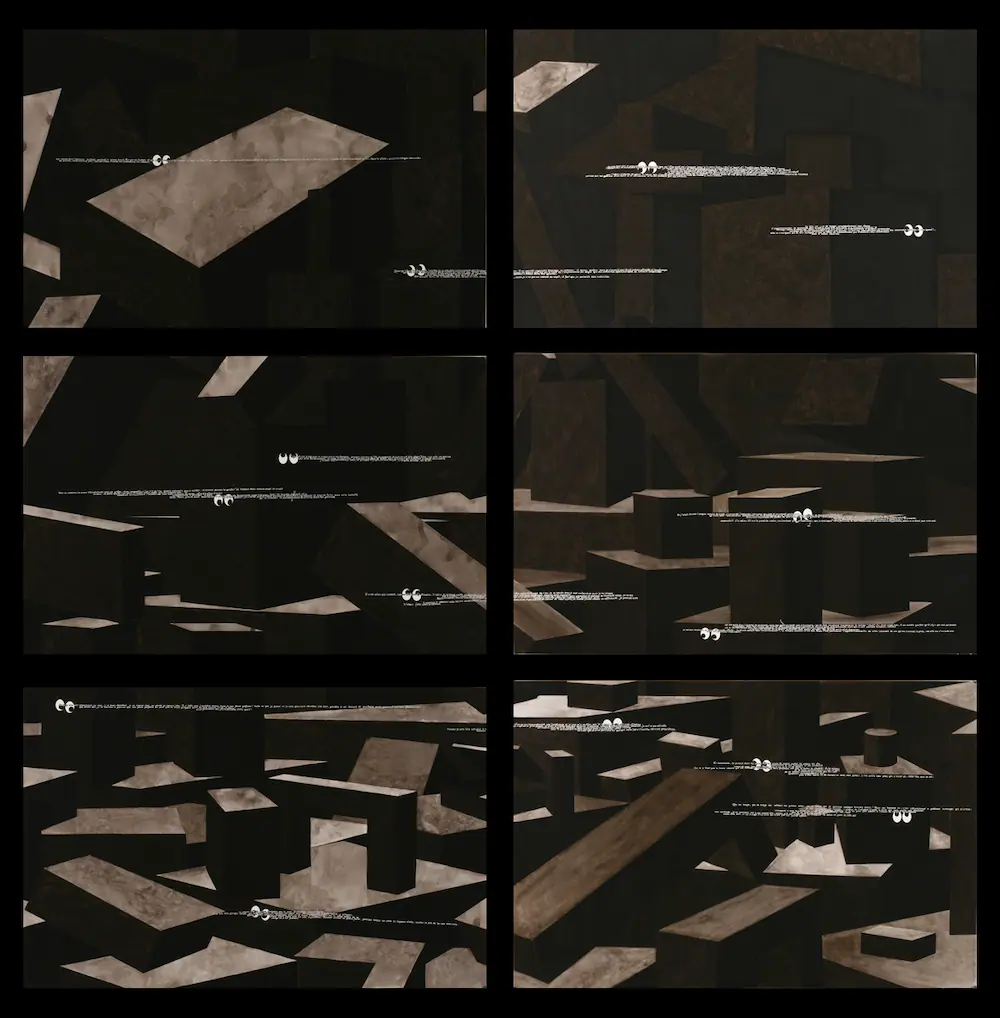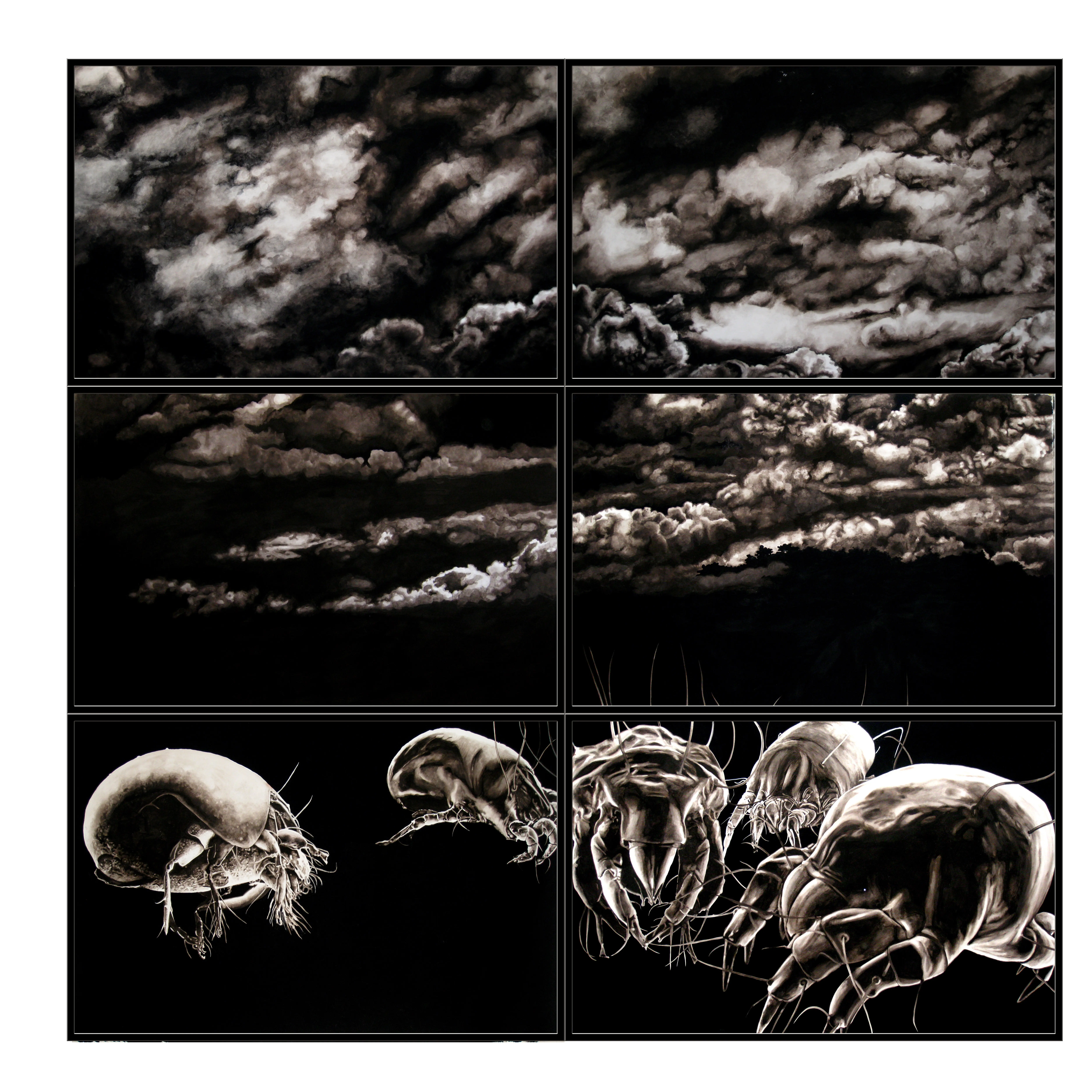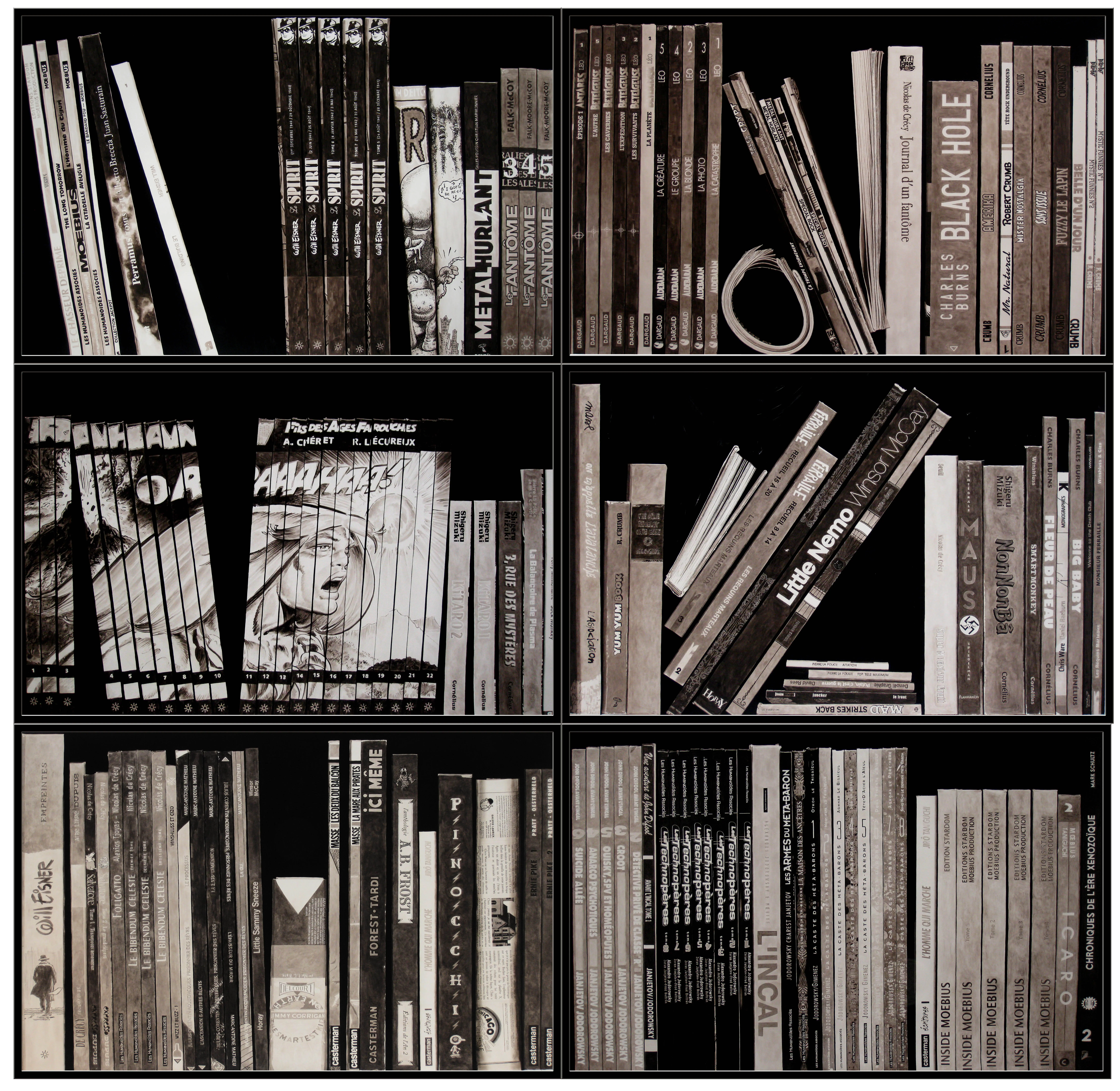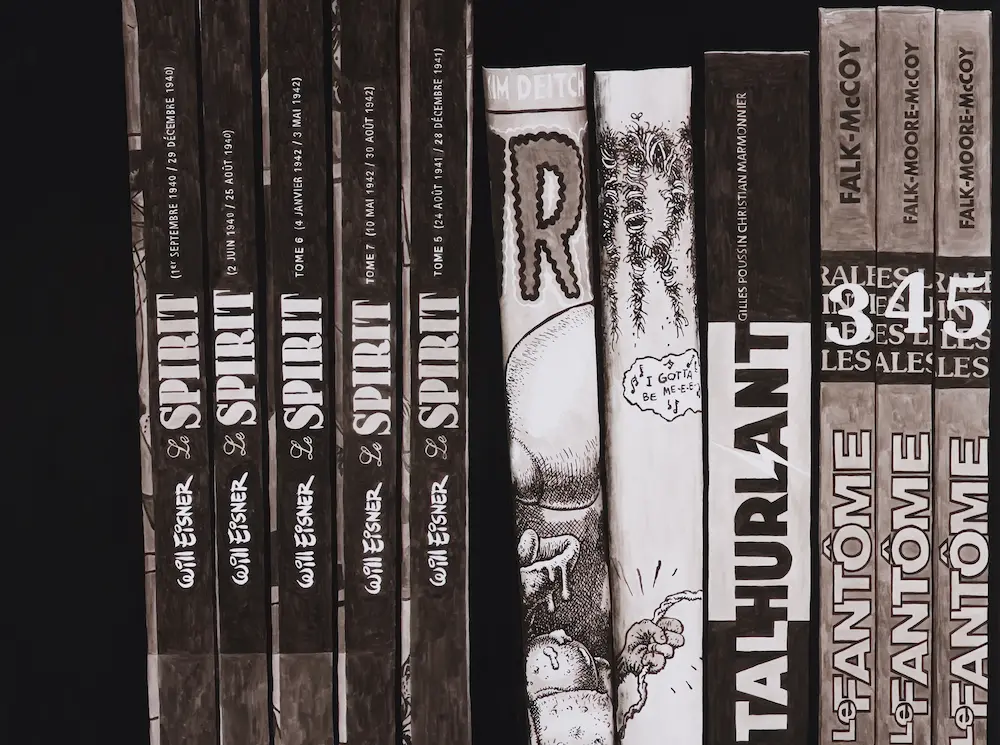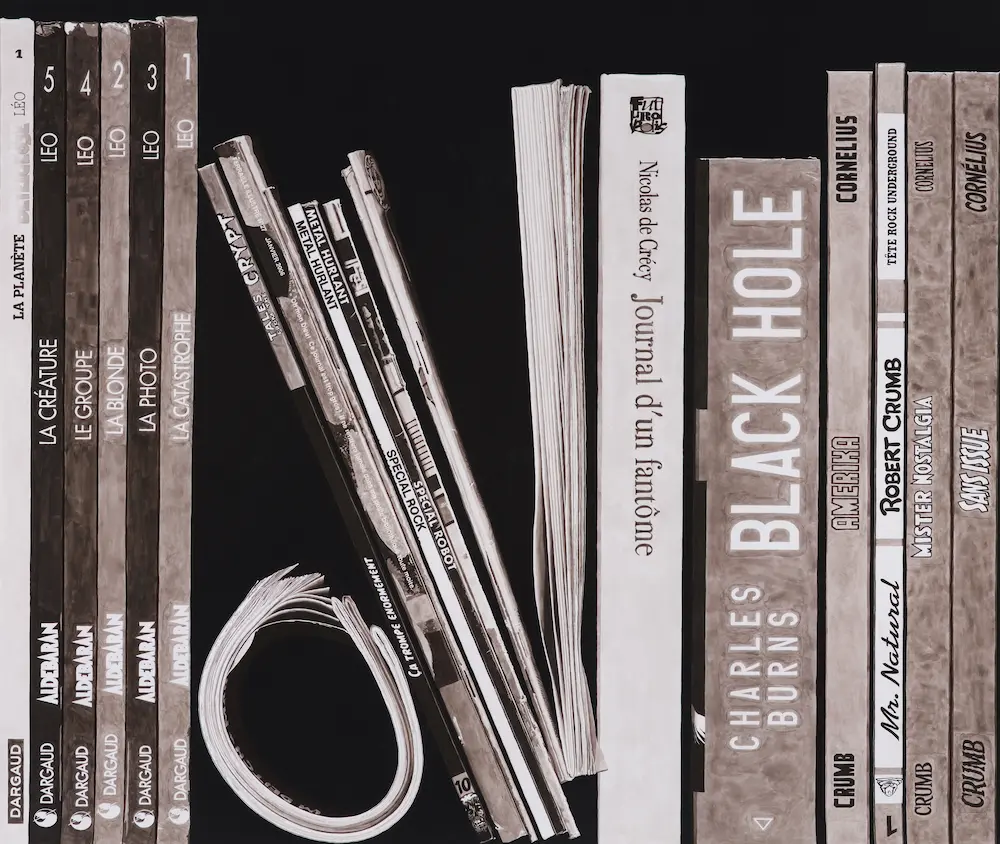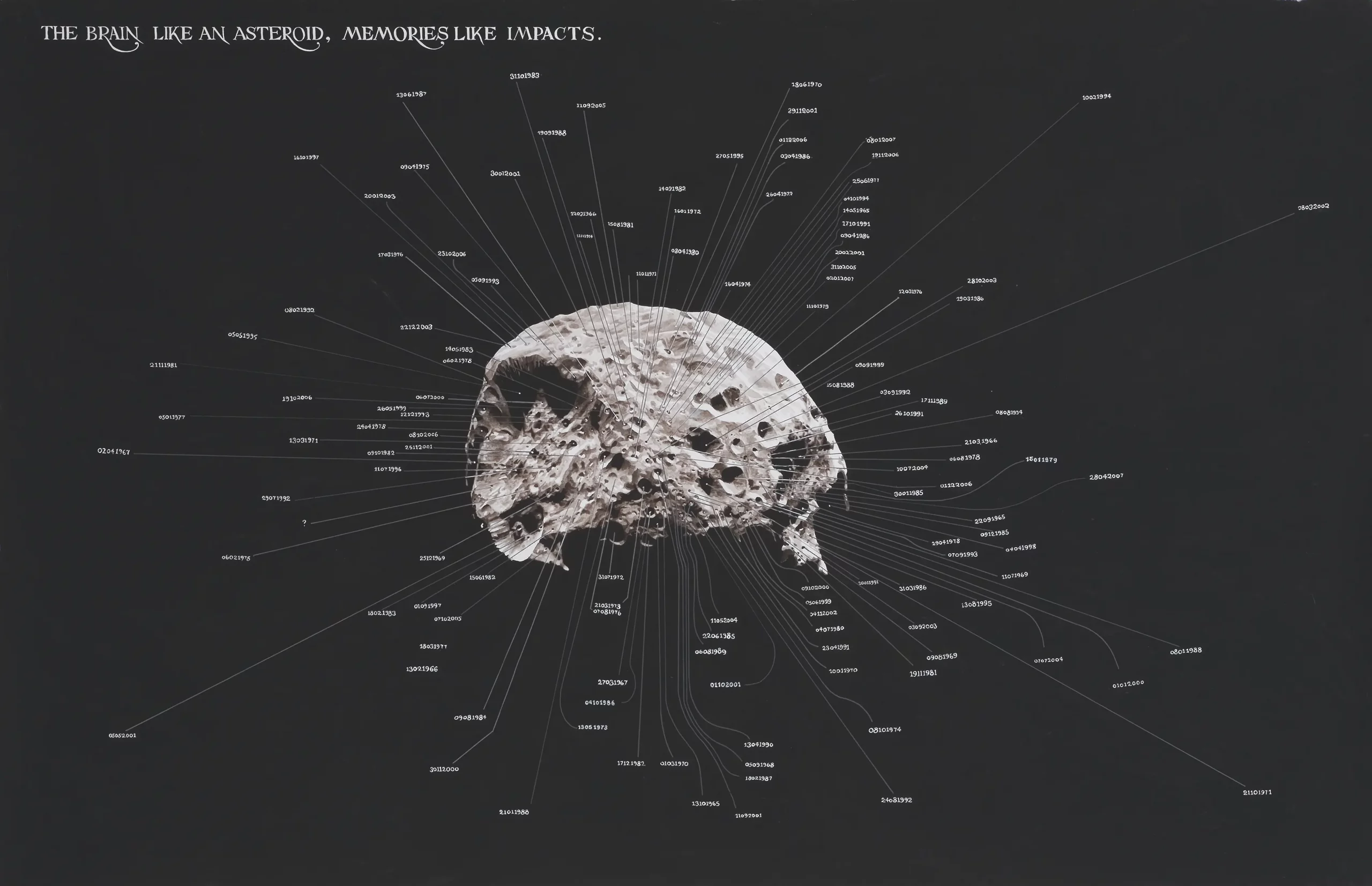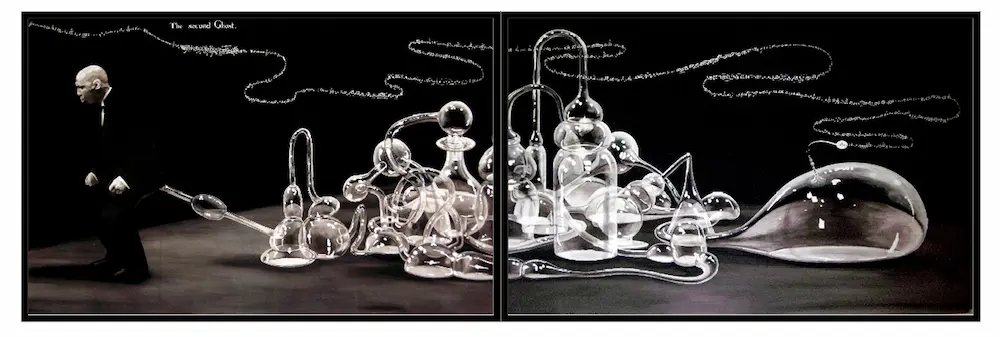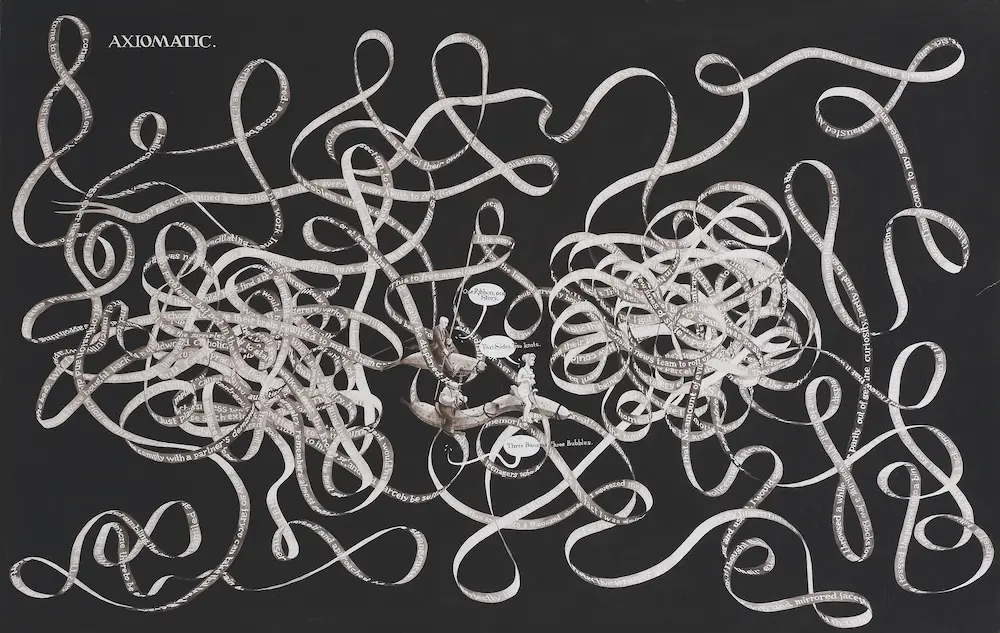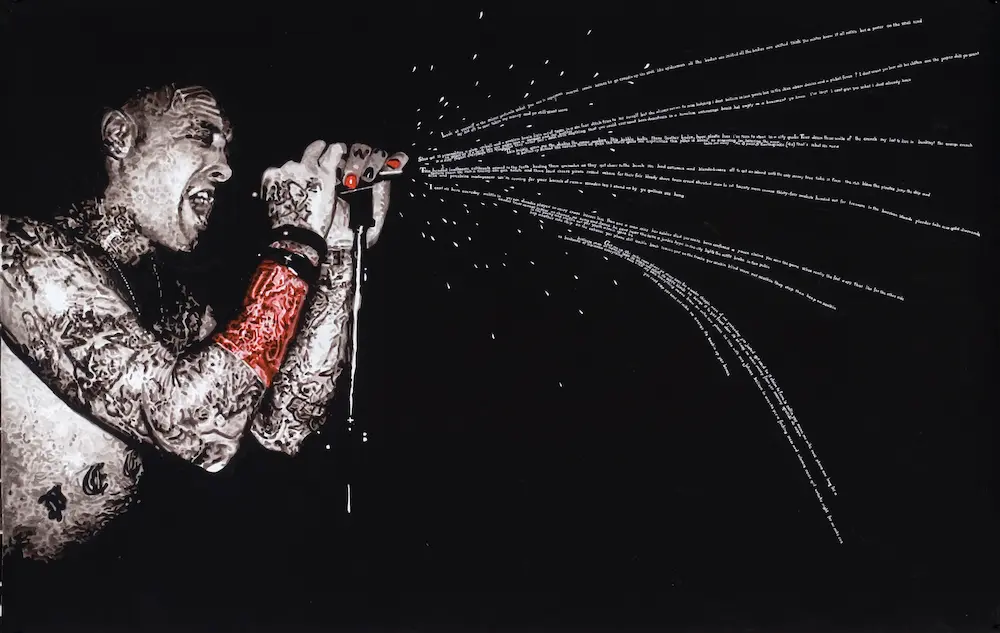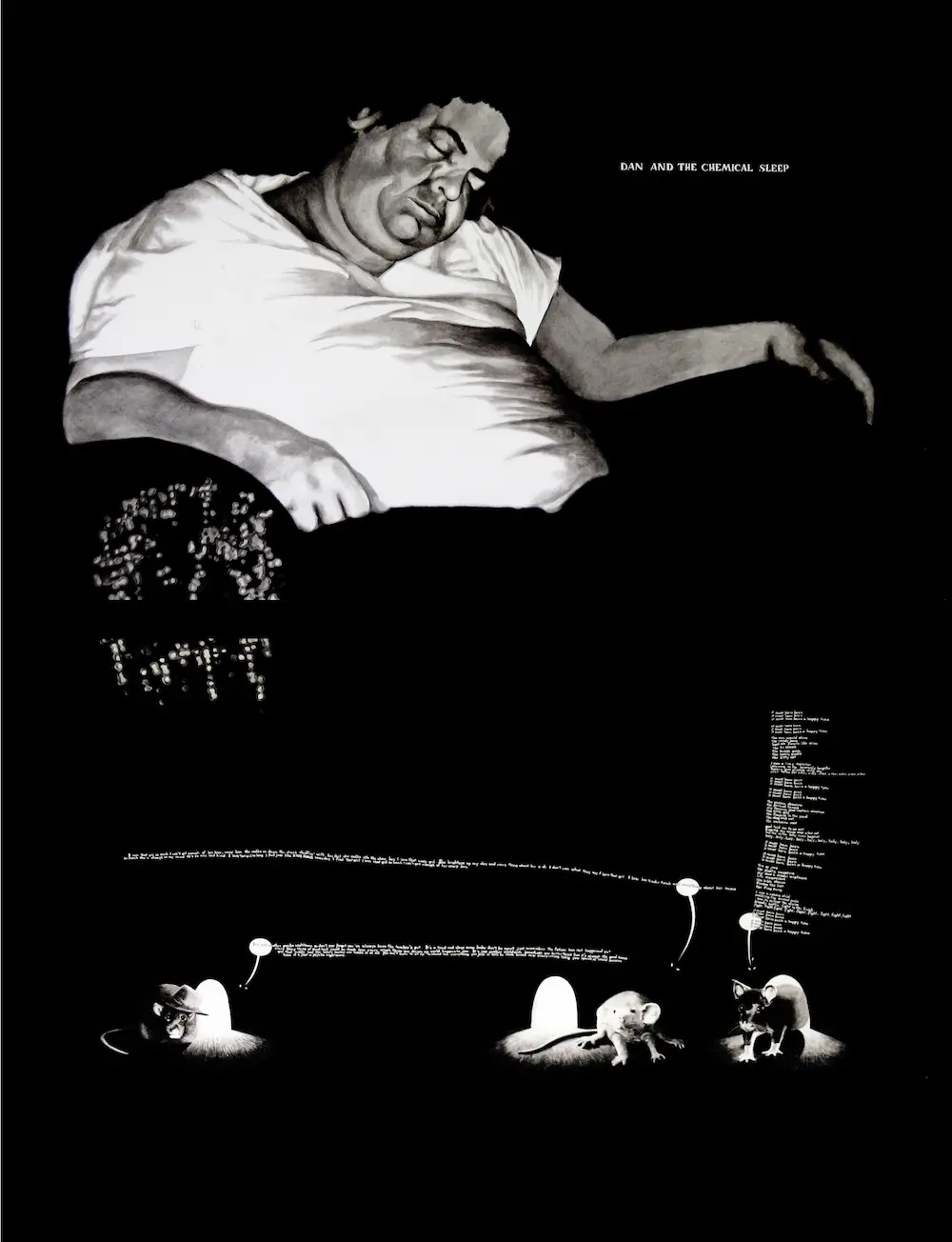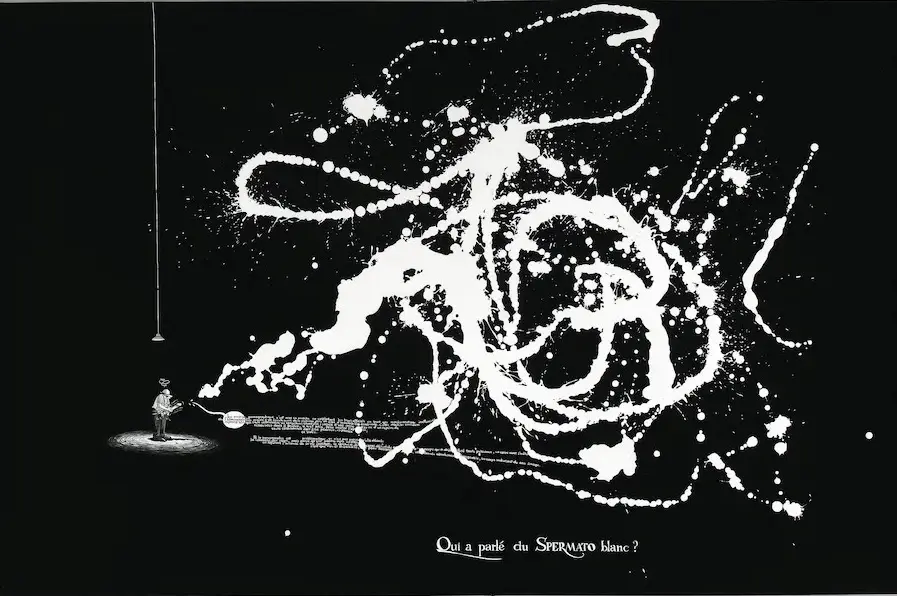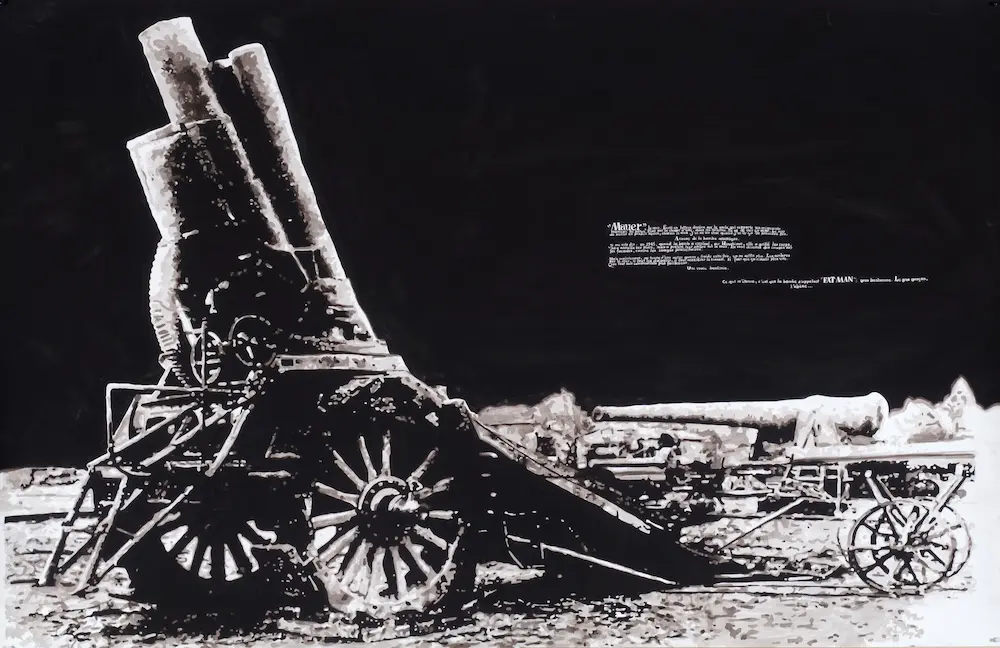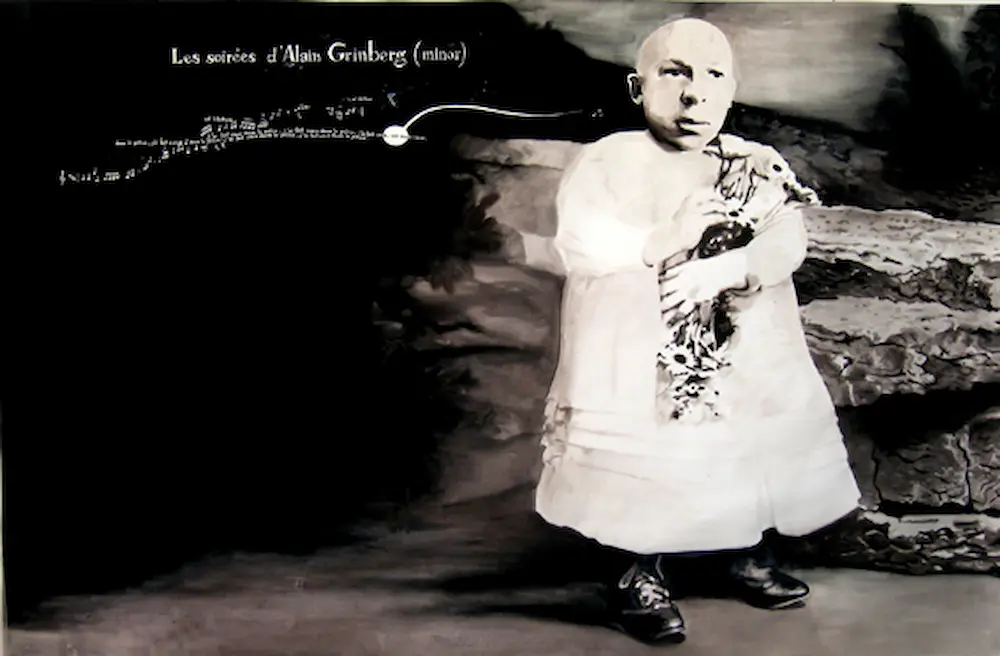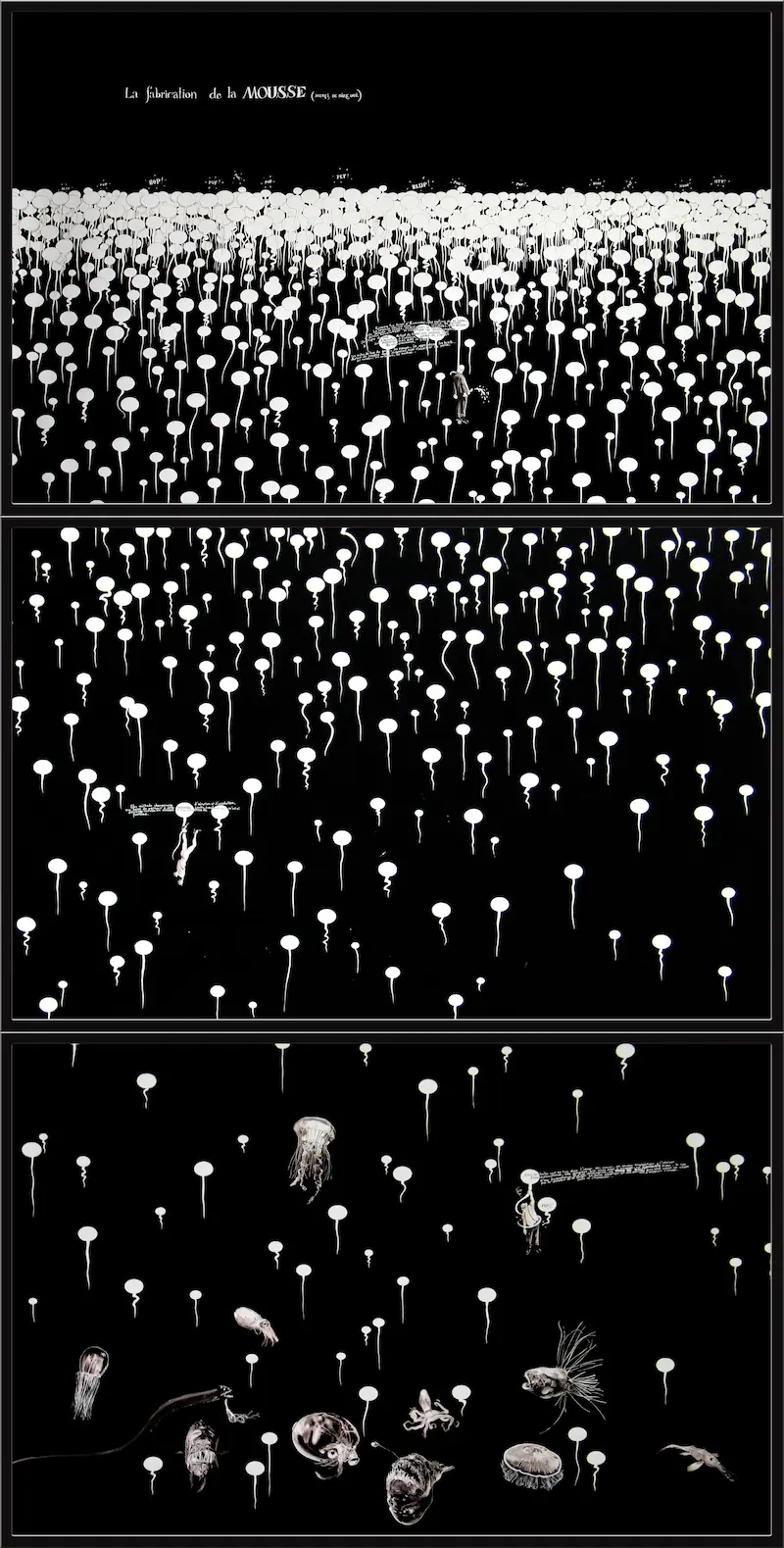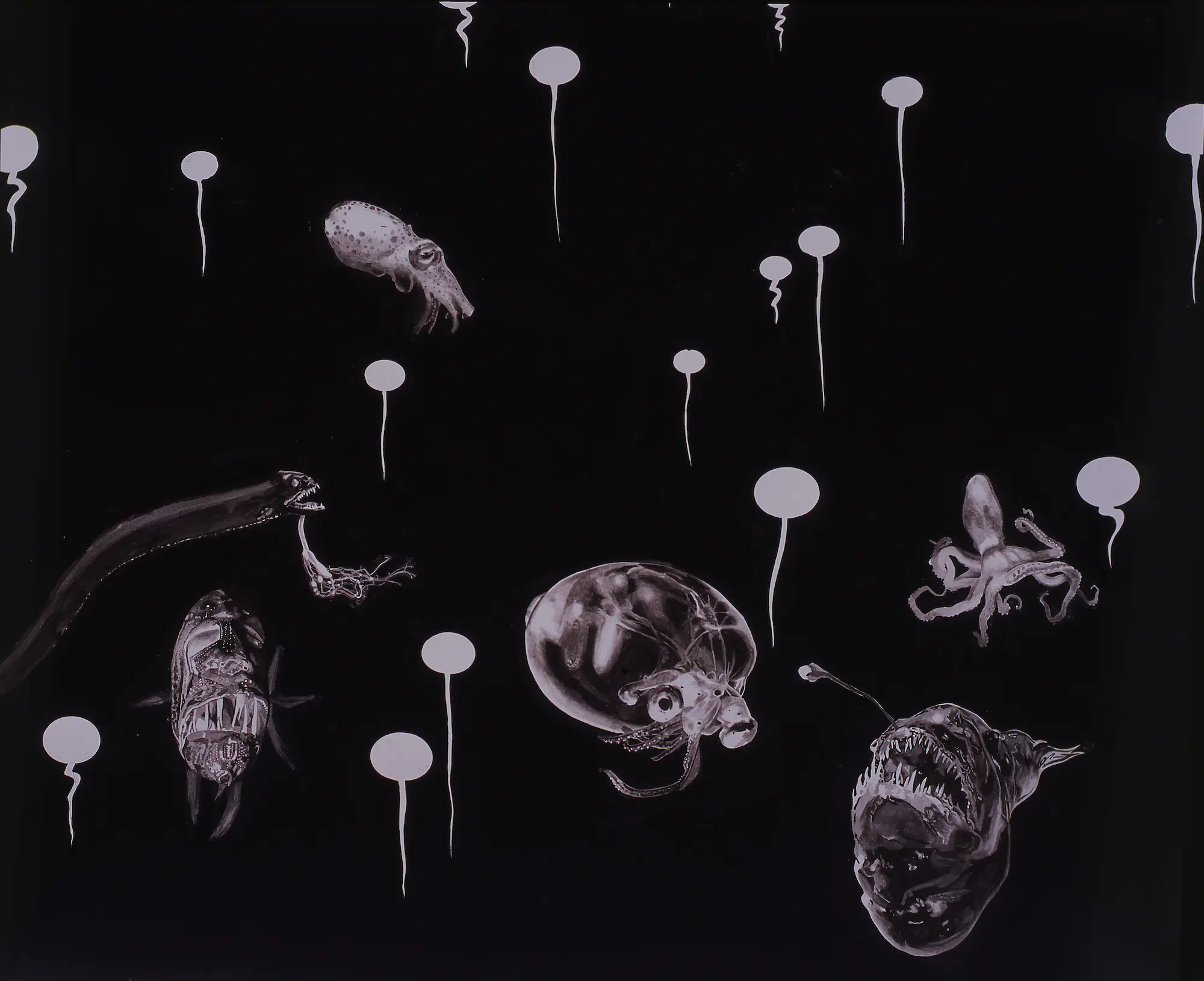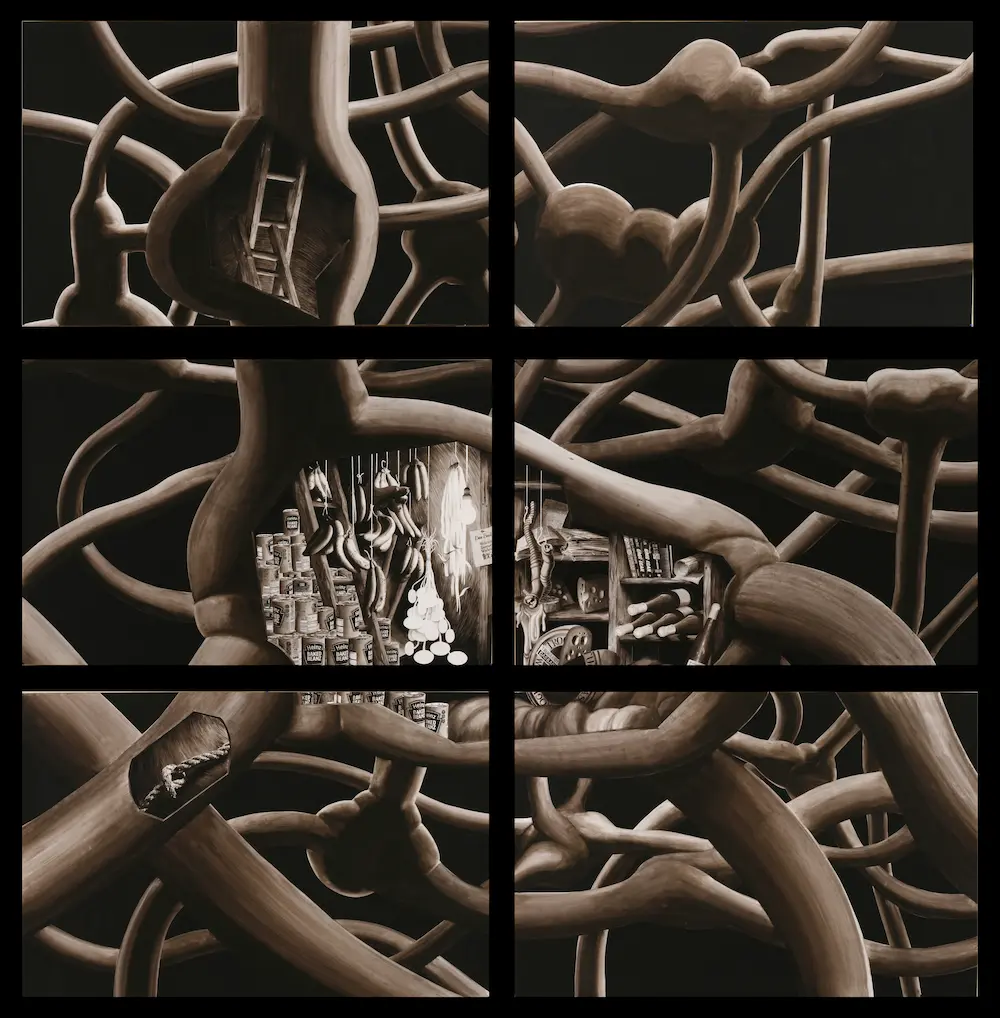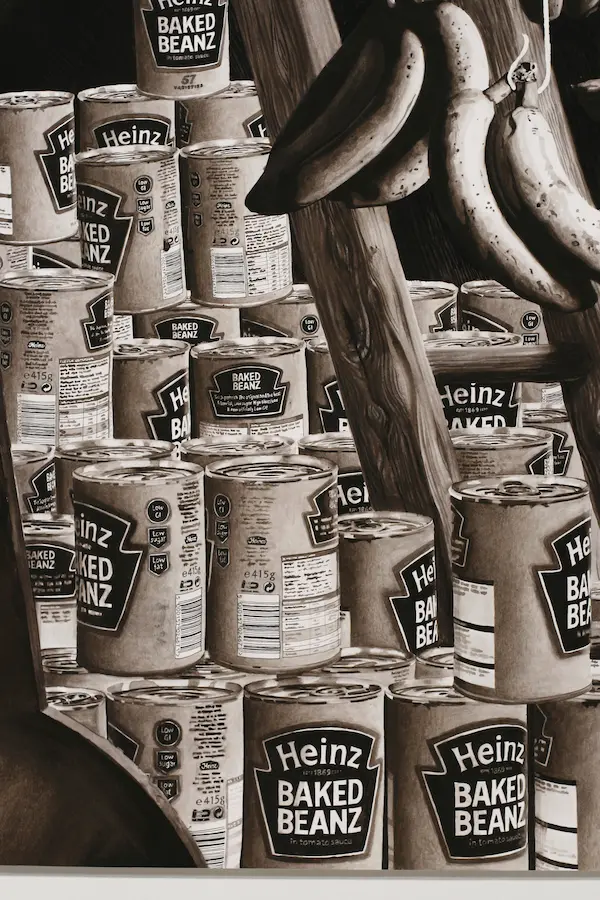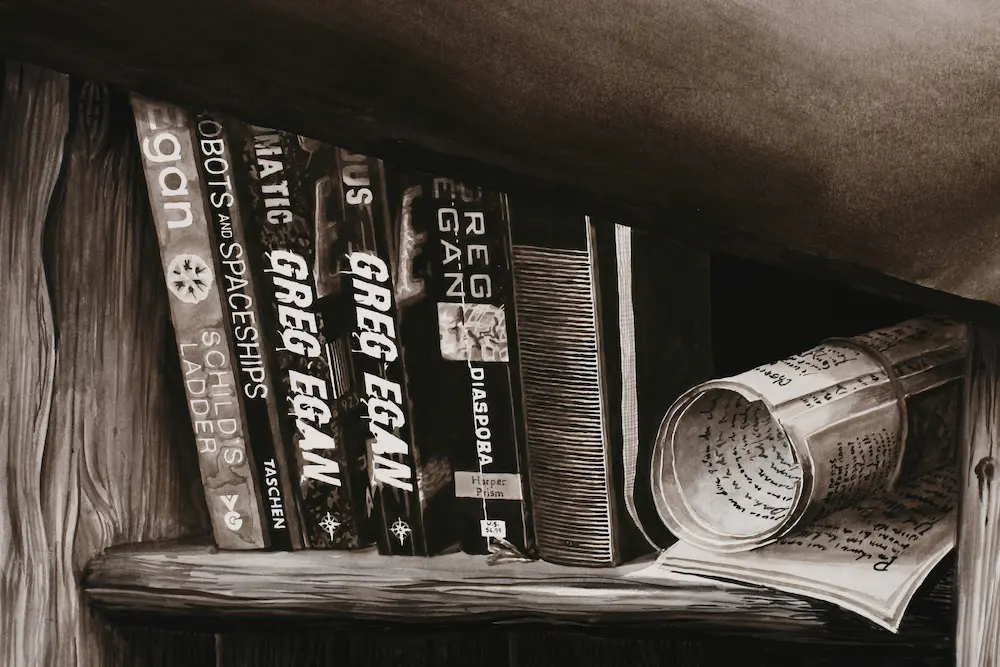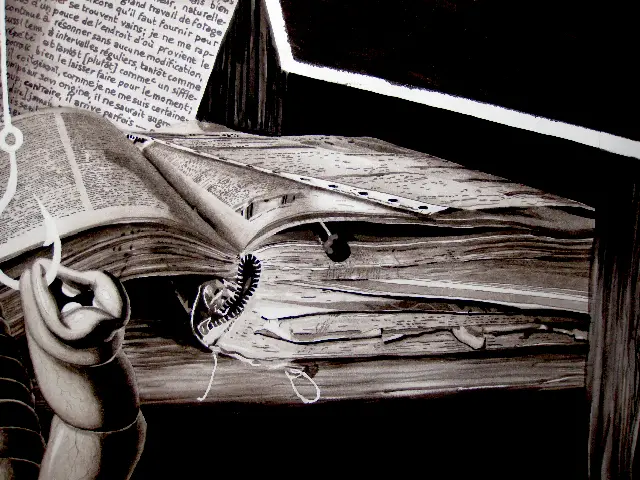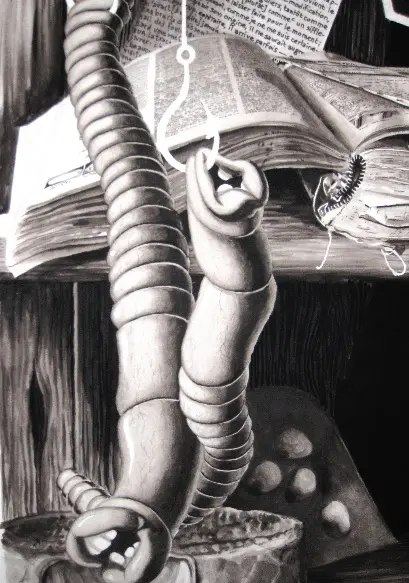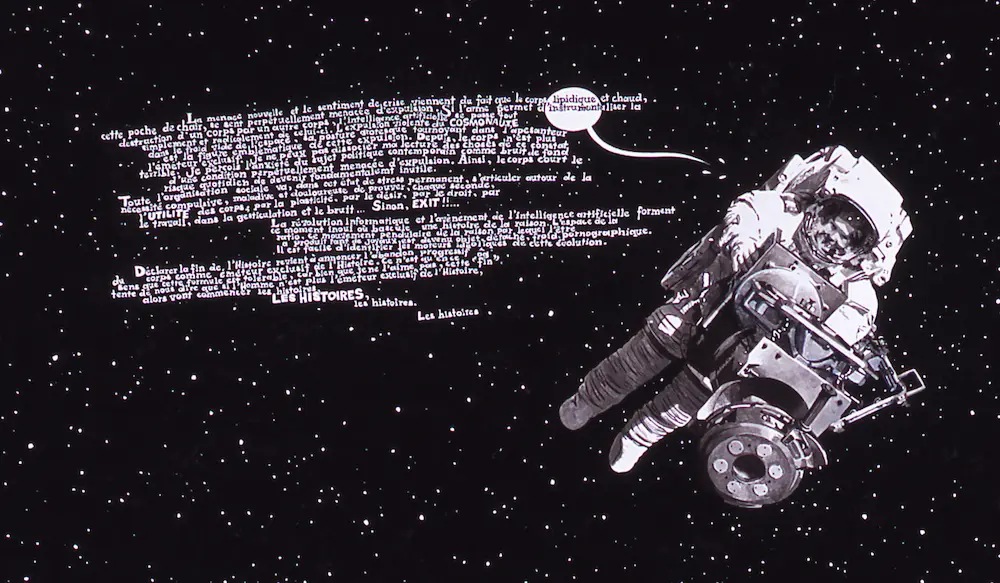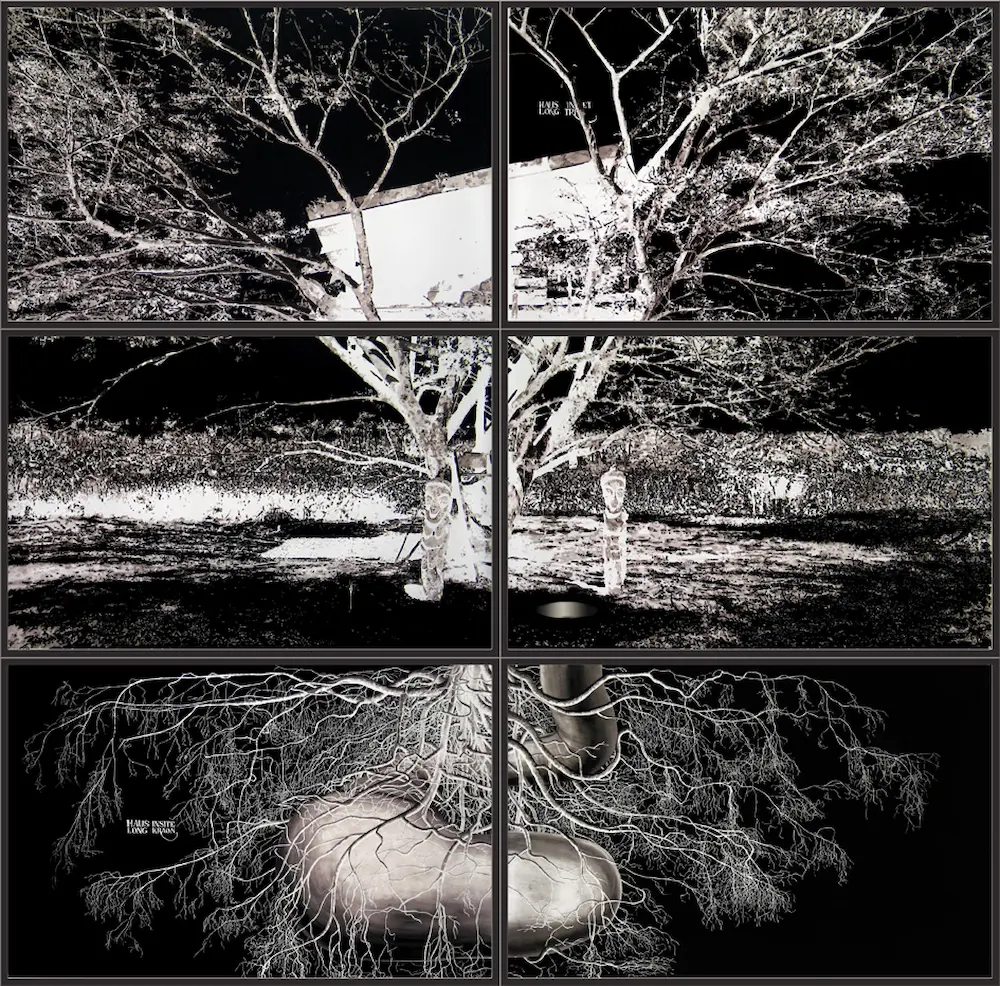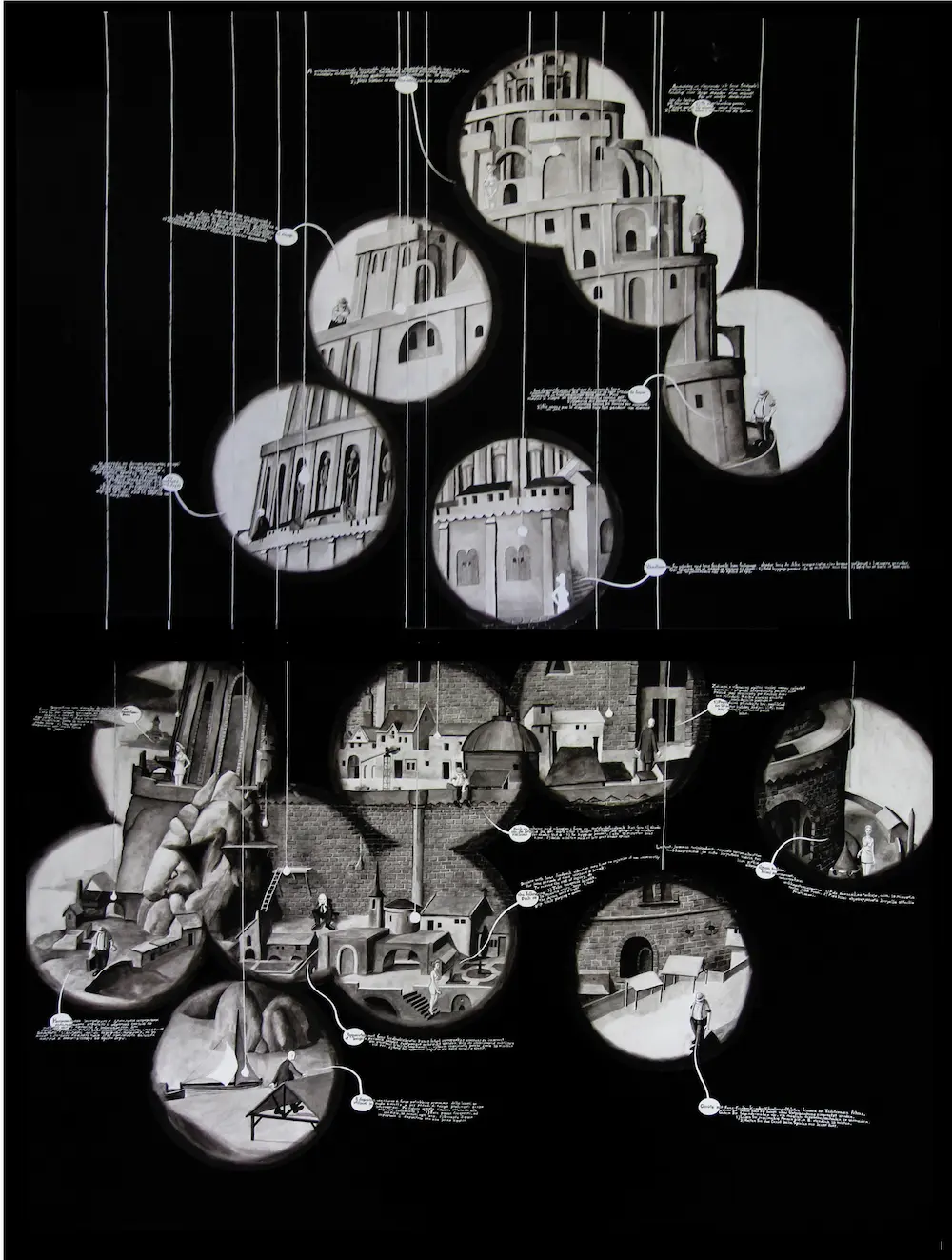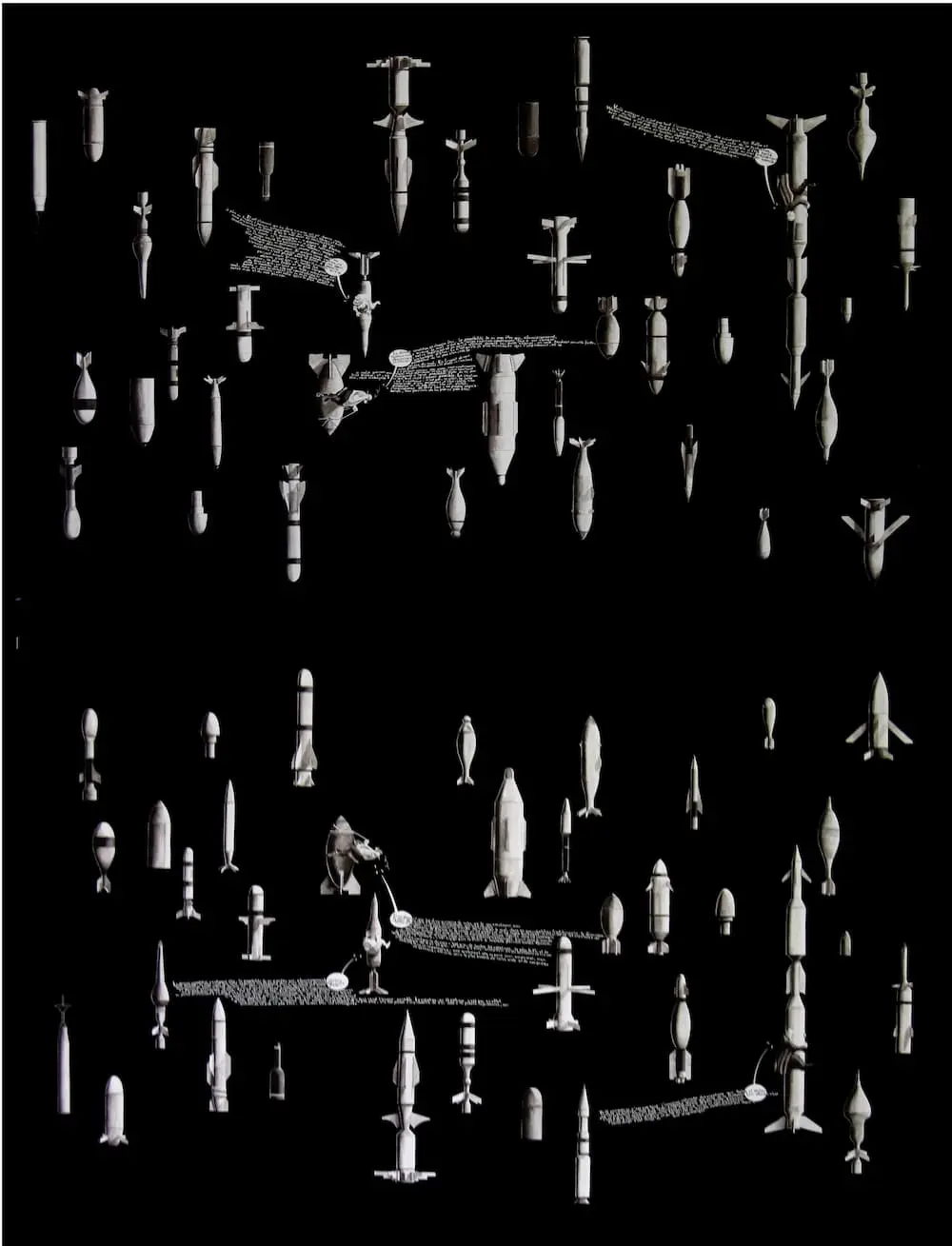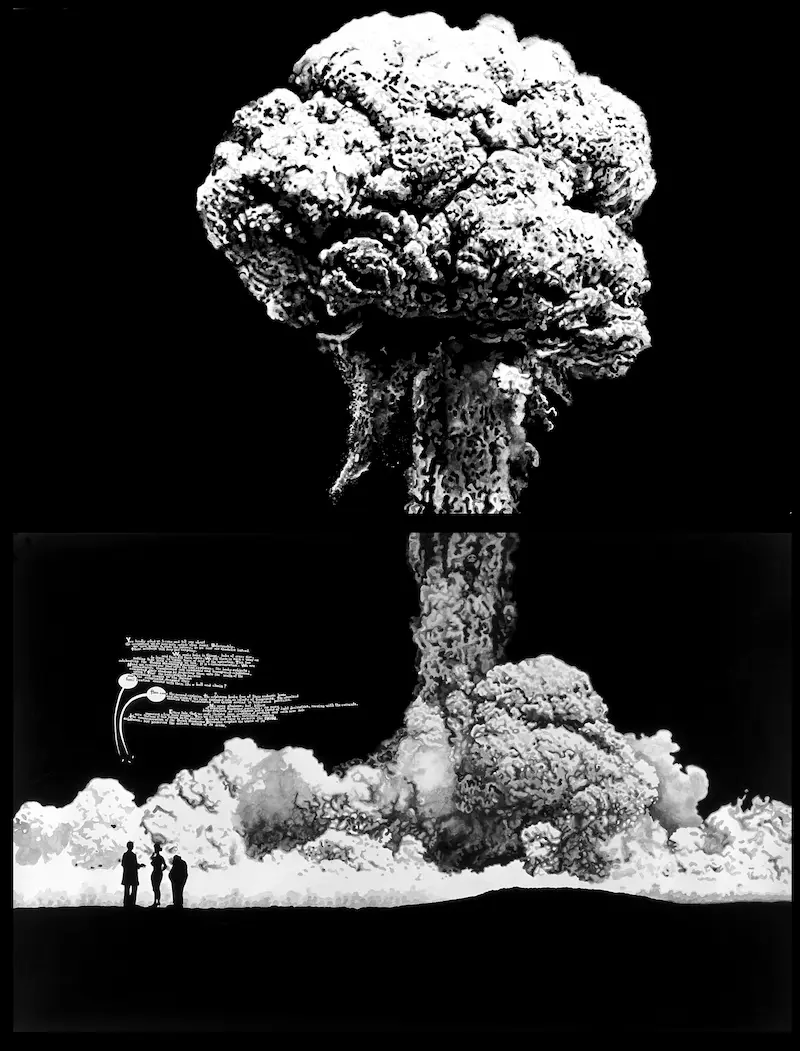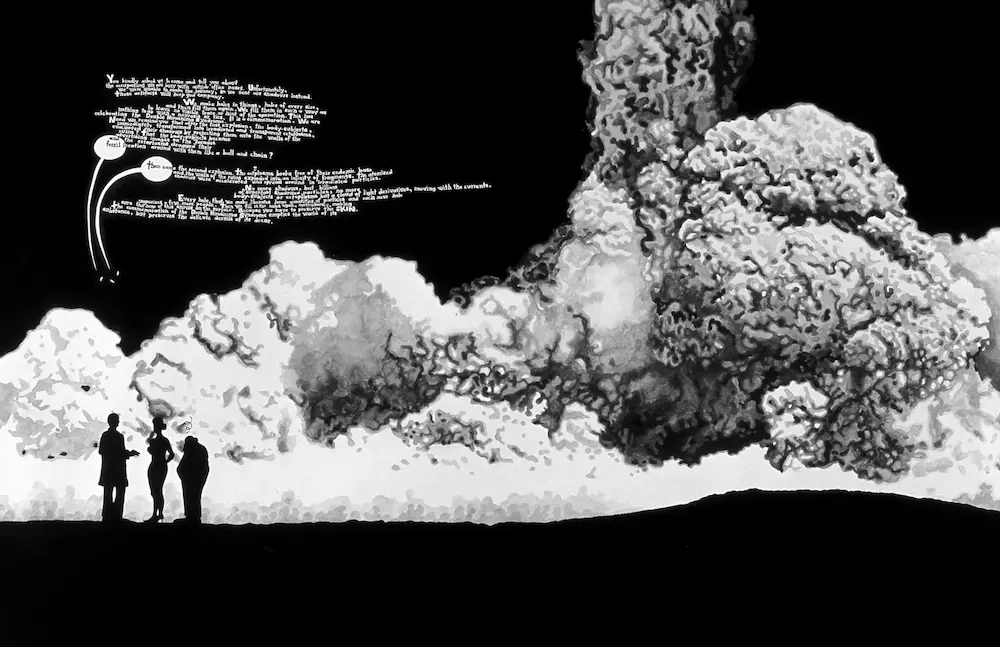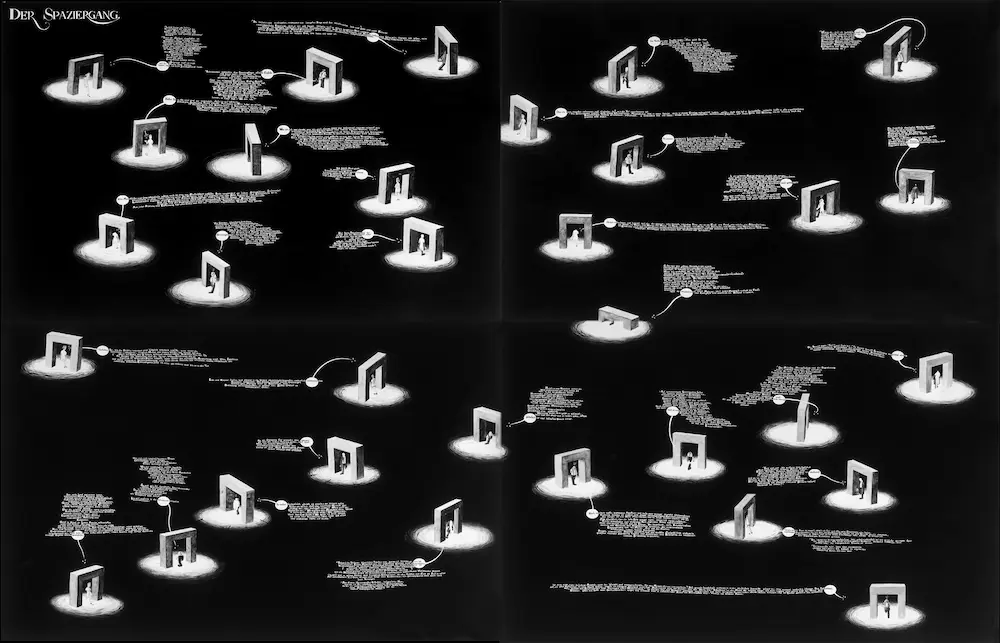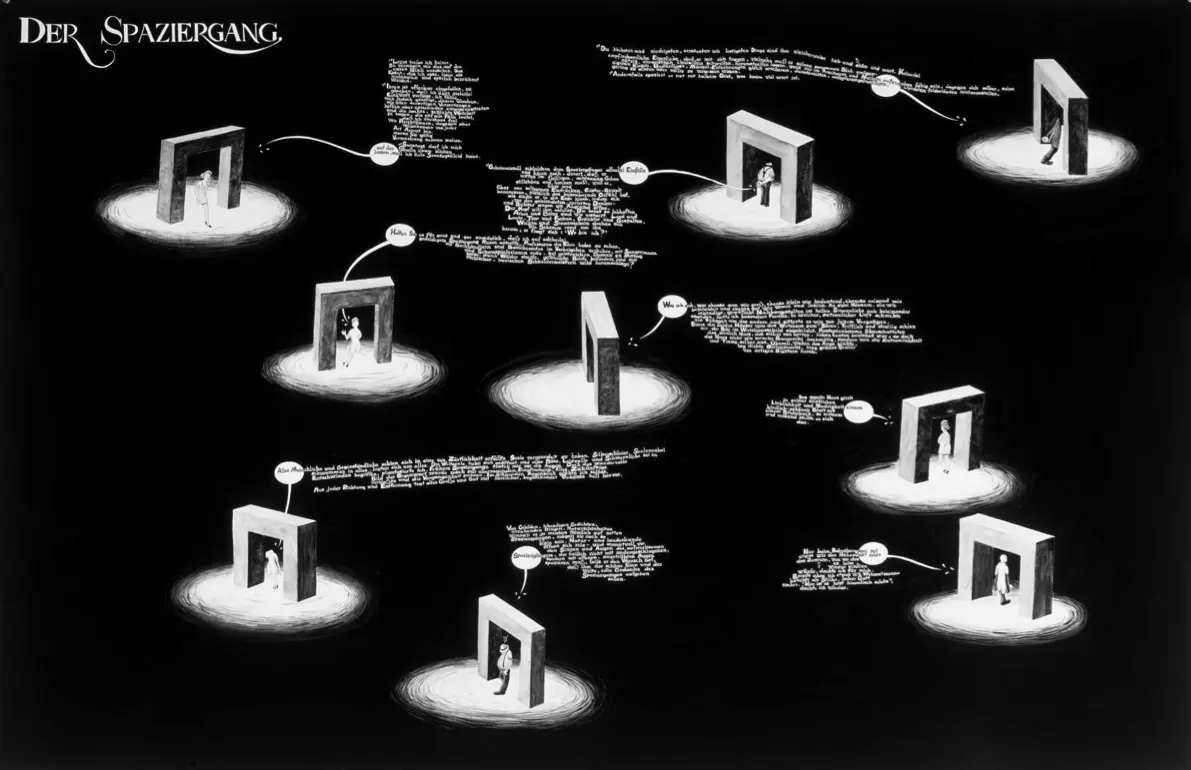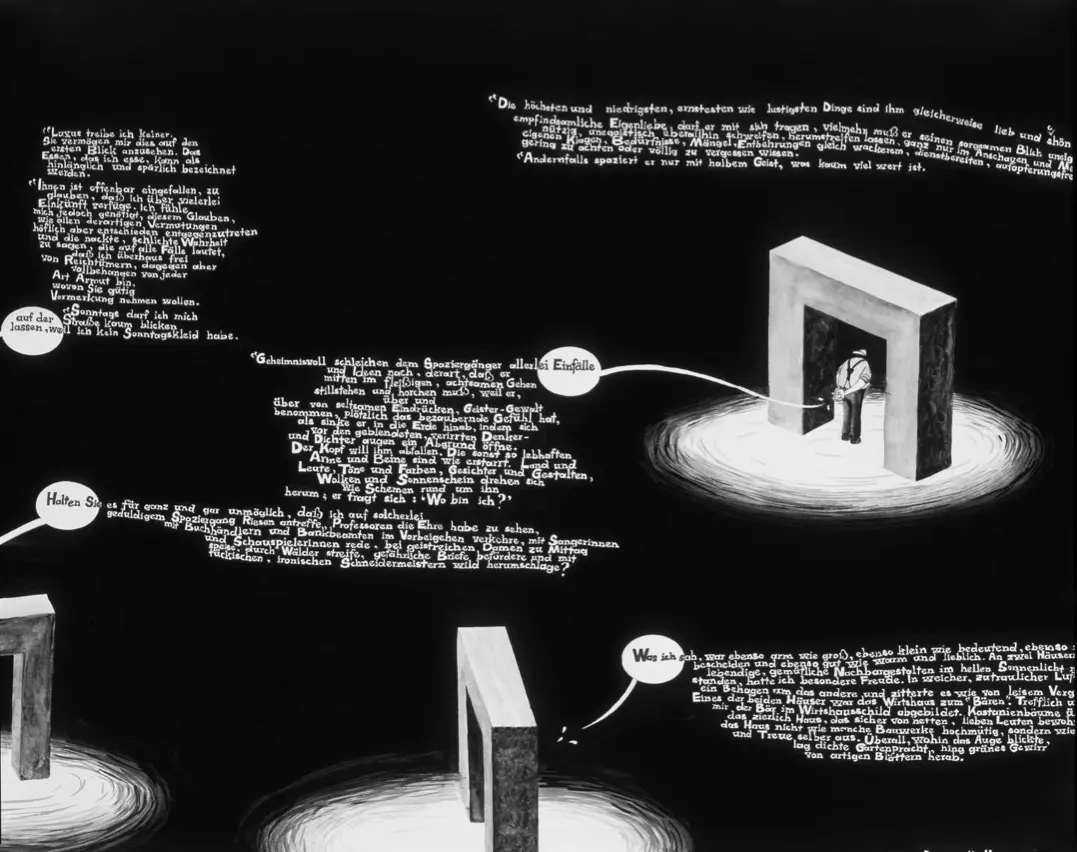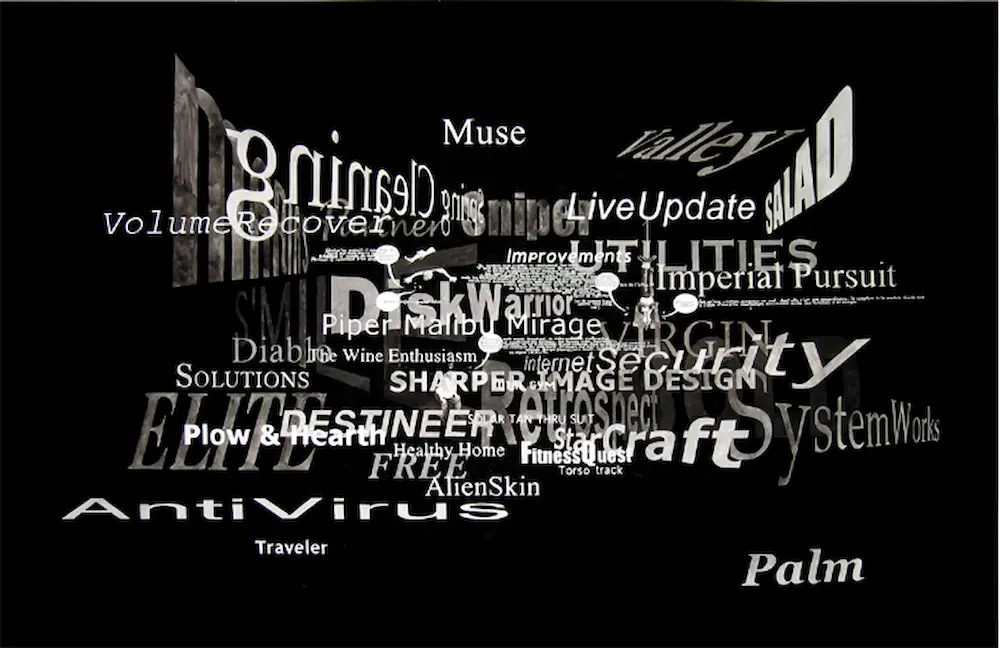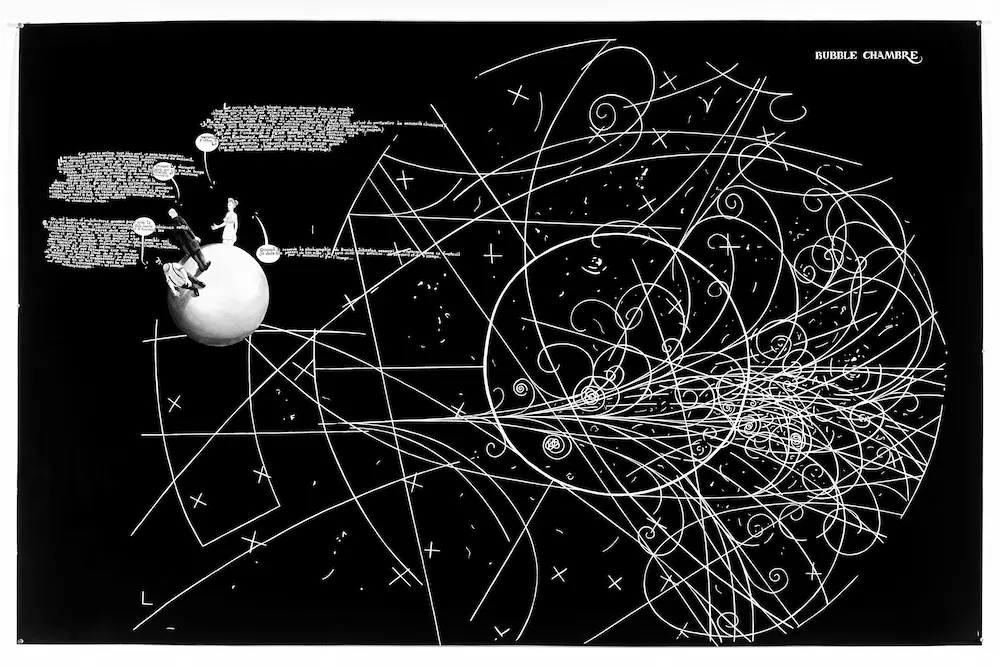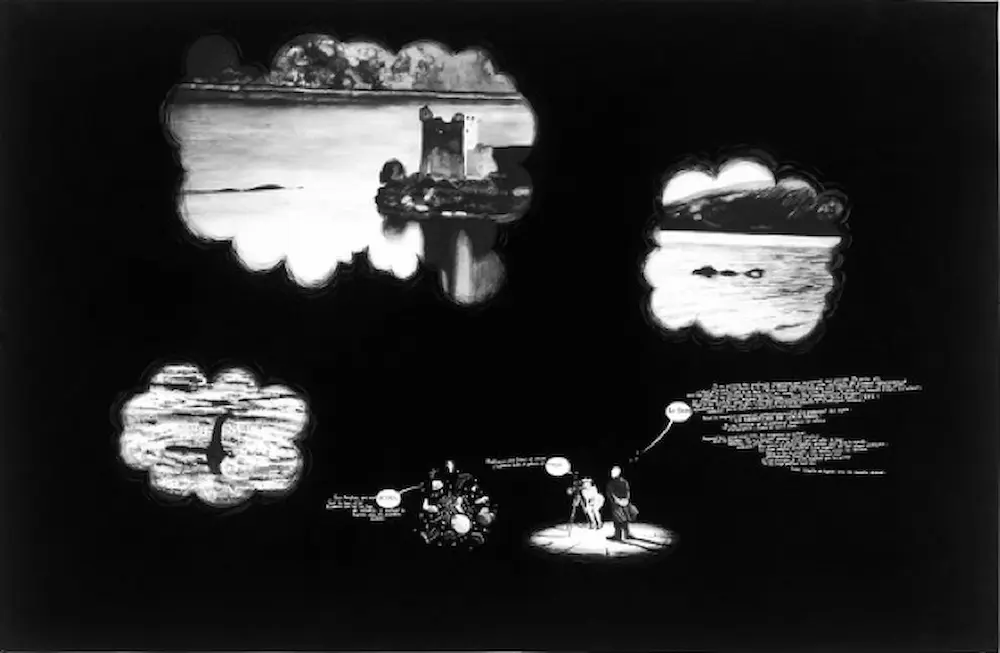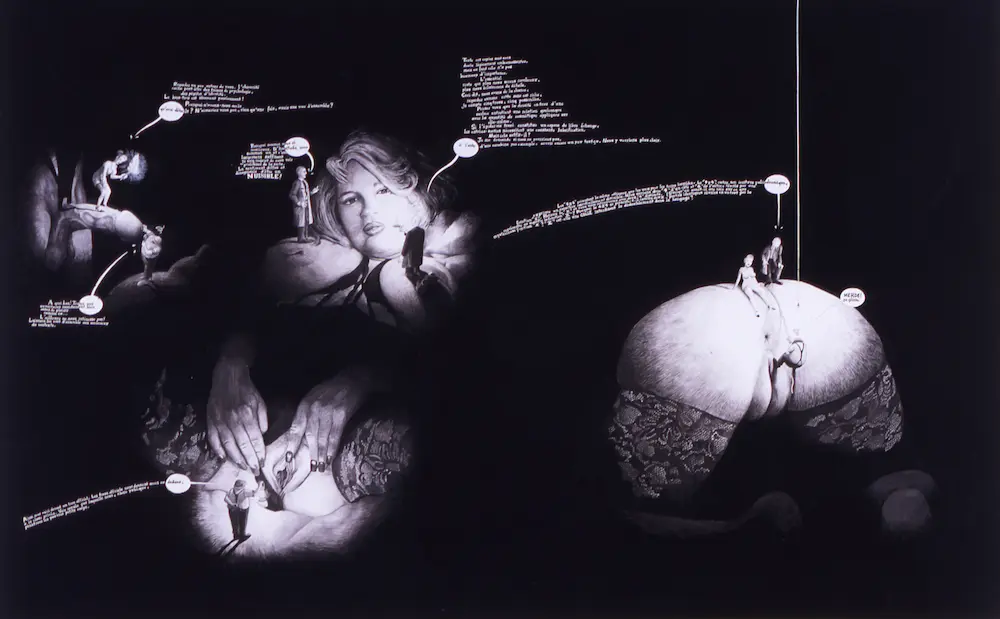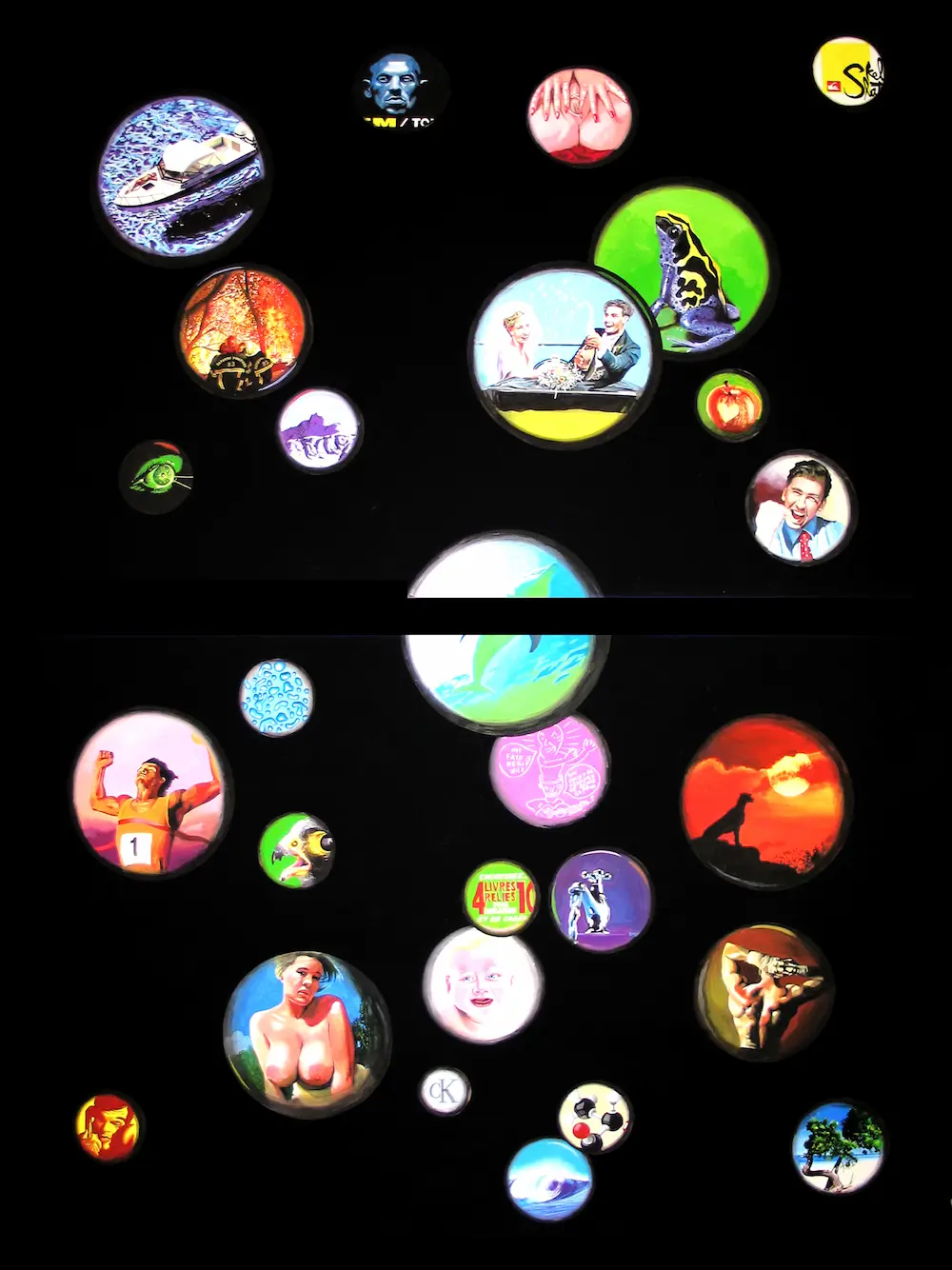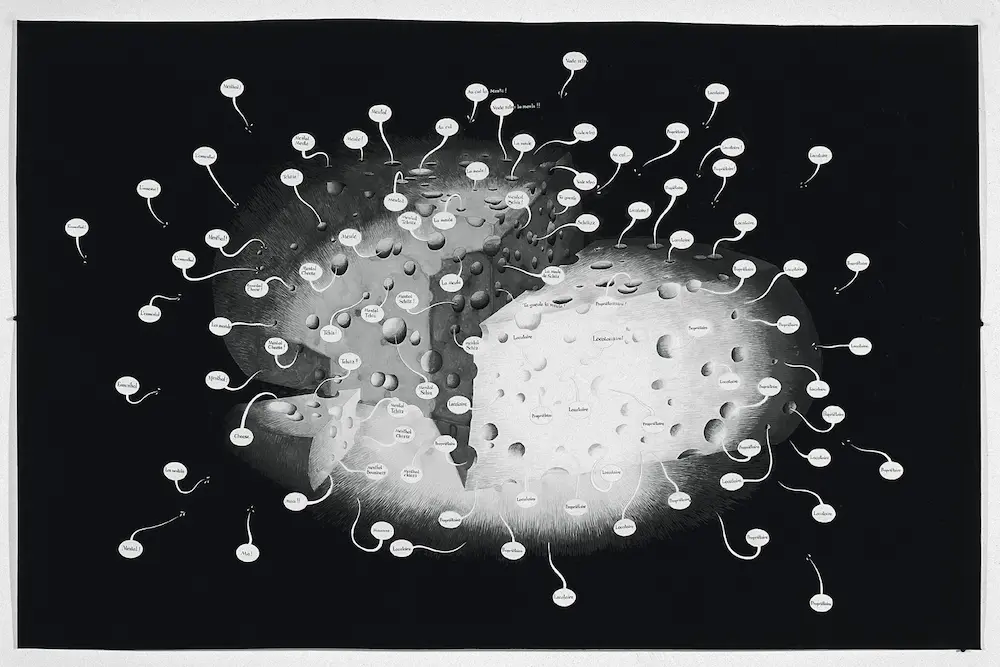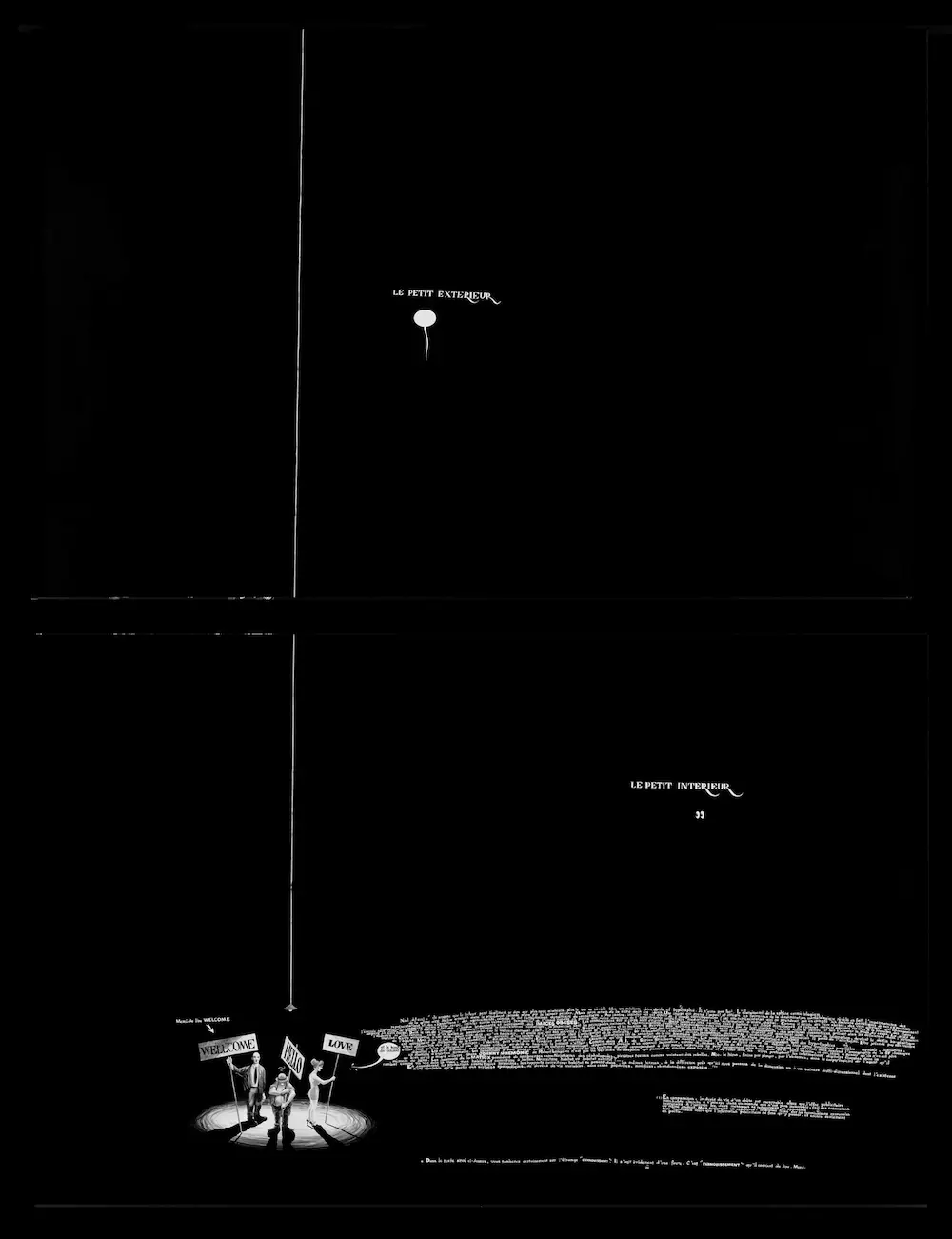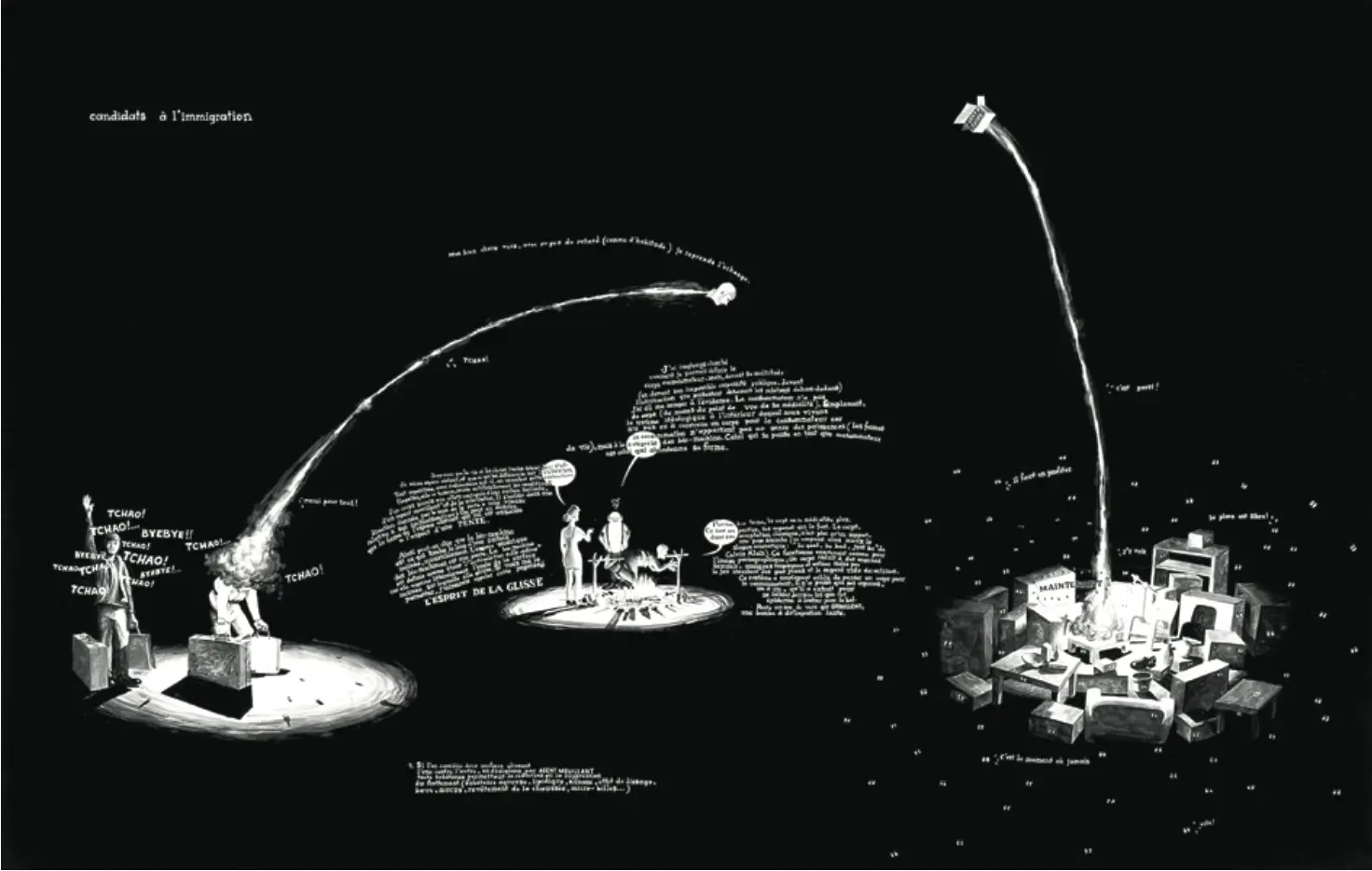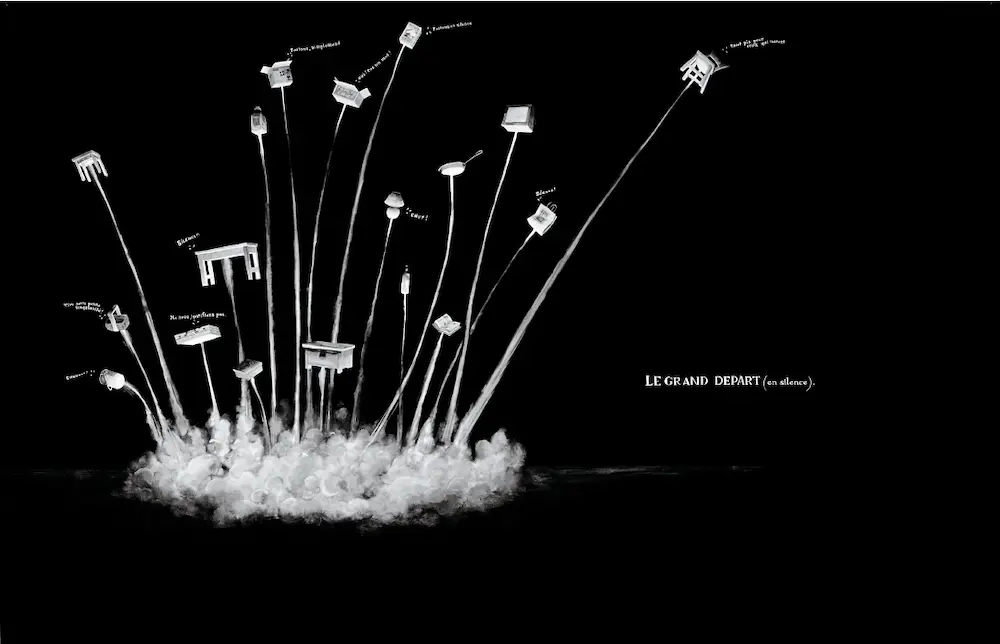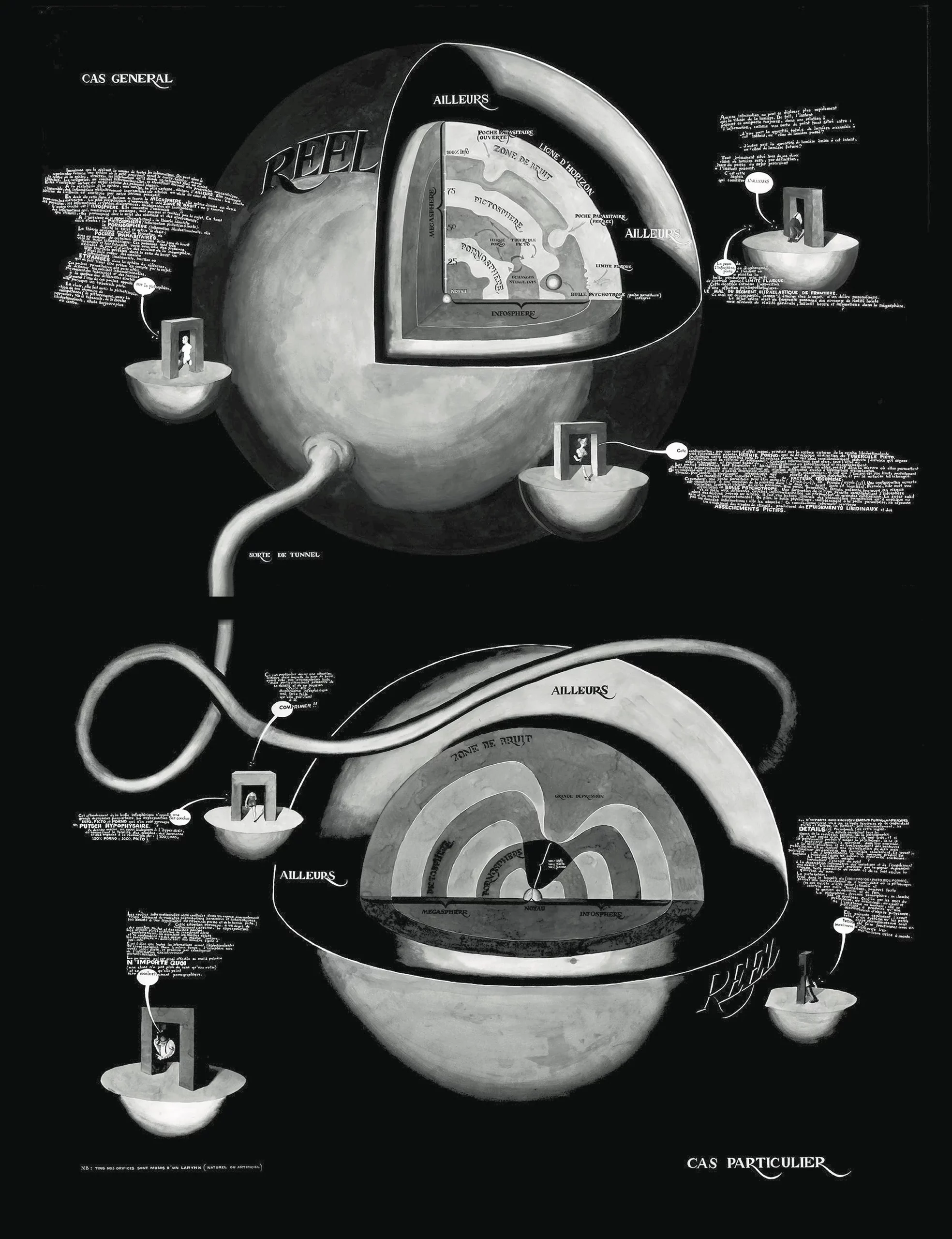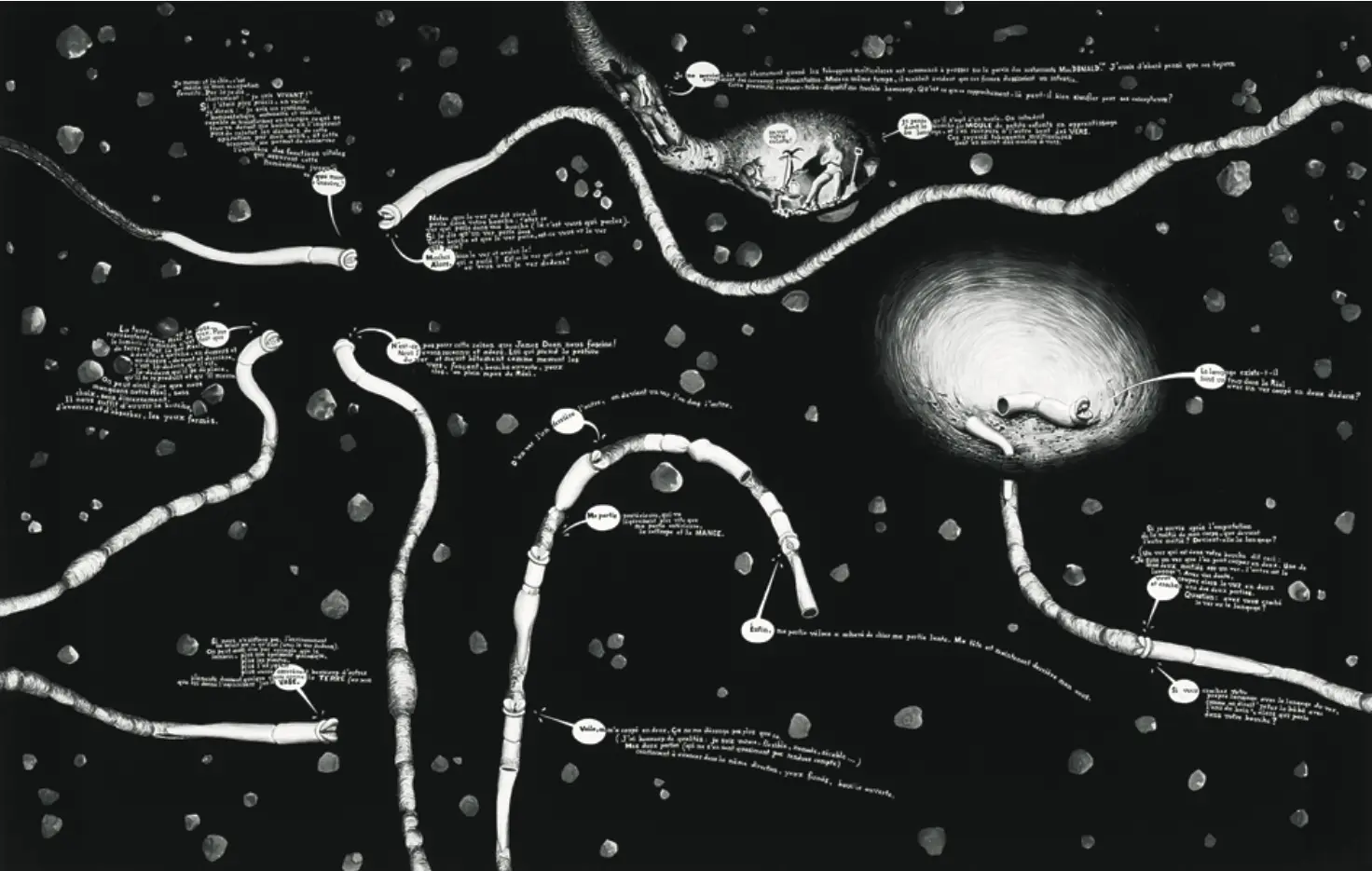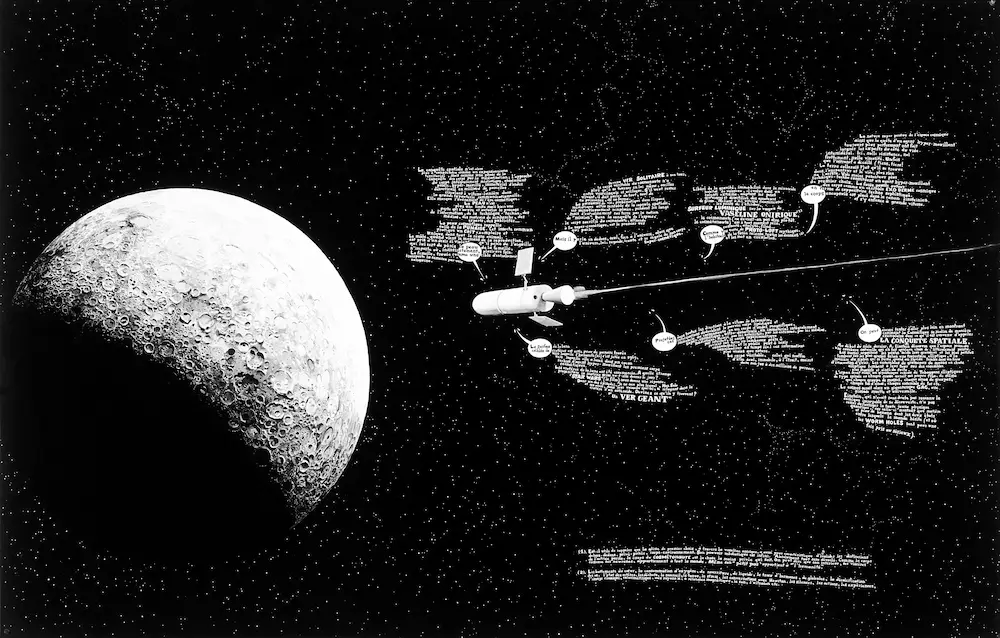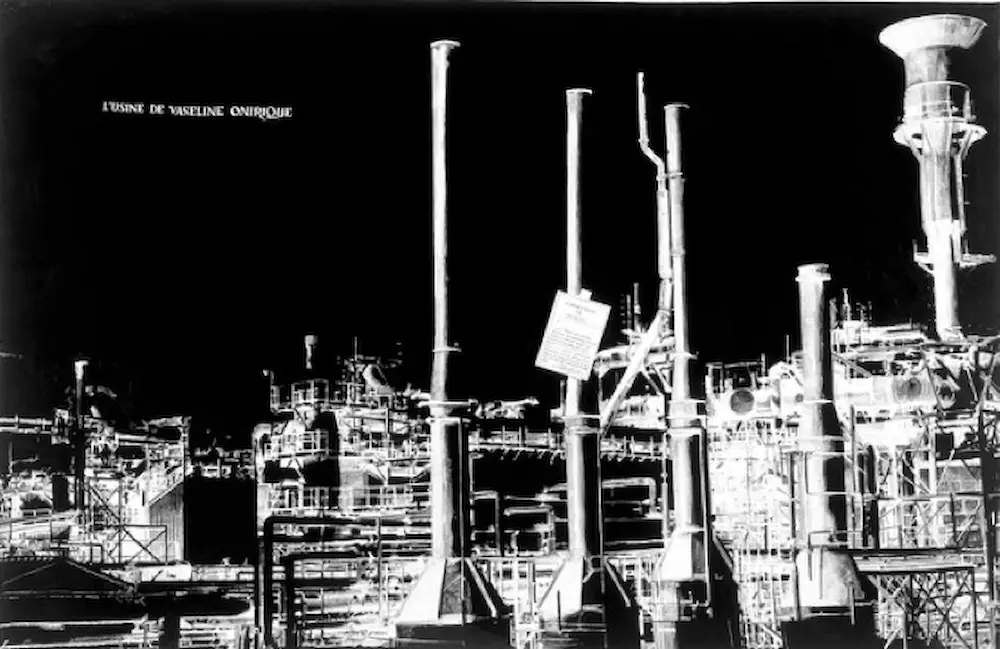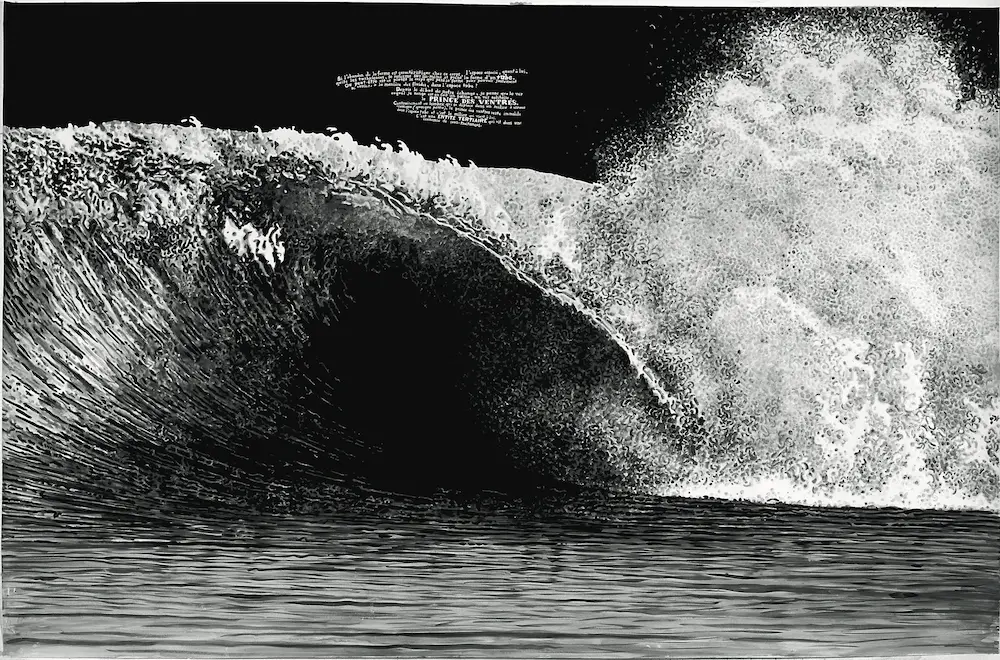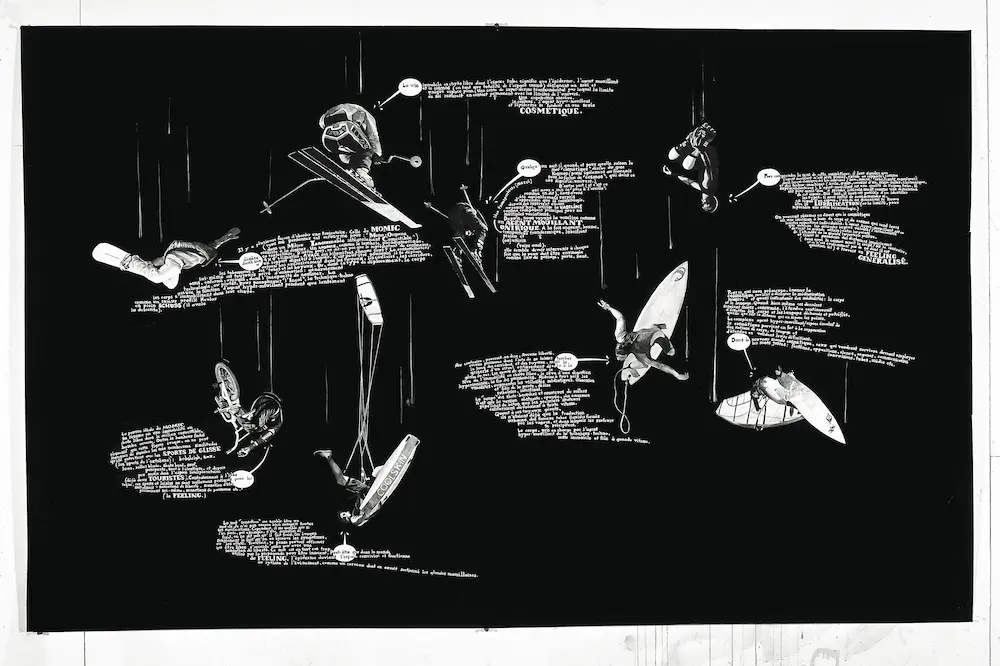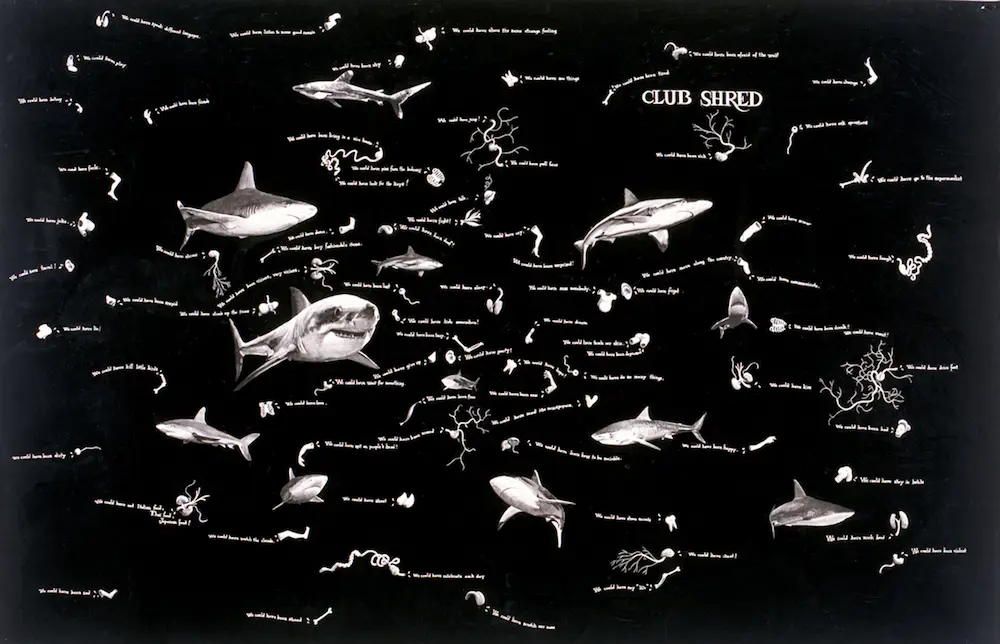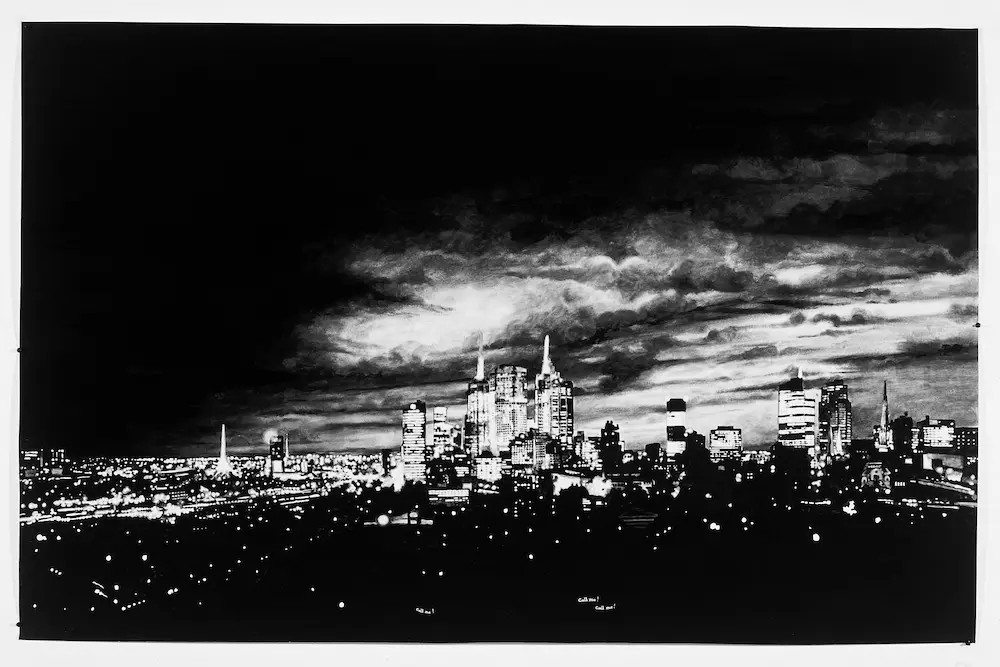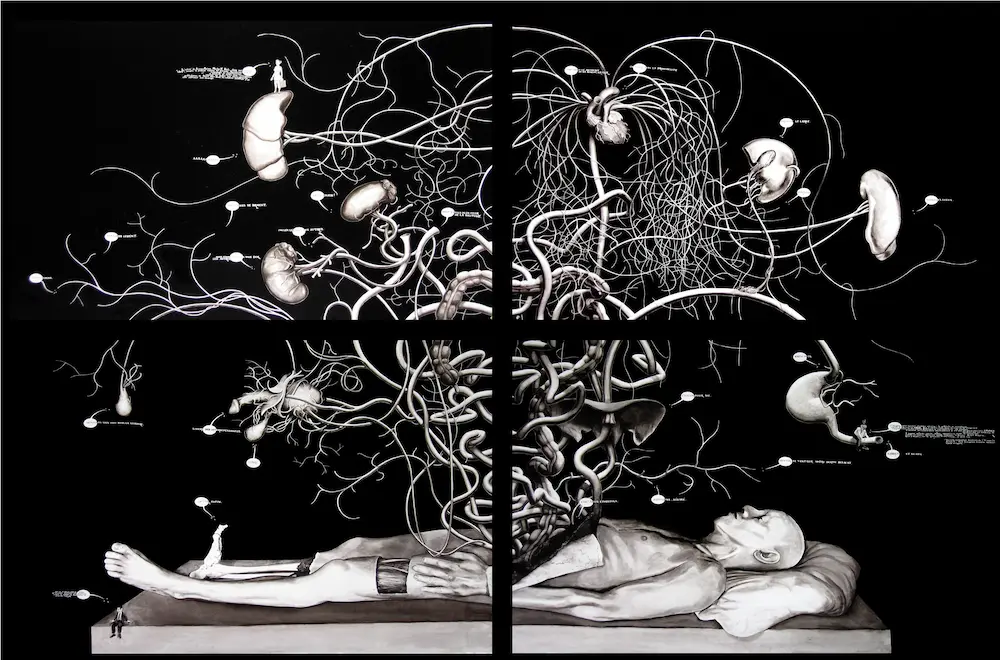Black drawings (selection)
(…) I also see the program as a challenge to time. It allows me to satisfy both my bulimia and my need for rumination. For example, the black drawings I’ve been doing for so long come out of a precise program. Their format is defined, as is their technique. They can be assembled in groups, never more than 6, on a 3 by 2 or 2 by 3 grid, like thumbnails on a comic page.
Their subject: anything that impacts my sensitivity: the memory of a drunken evening, a phrase, an image, a vision, a piece of music, a key word, a memory… Collectively, they can be seen as the data recorded in the black box of my trajectory. They are then grouped in groups of six on four large, four-pronged turnstiles which, turning on themselves, open and close this black box emulsifying these impacts.
To sum up, I have a few elementary algorithms, some data, an application space and some time. In this space, I feel immense freedom. I call this protocol a “Production Machine.” I don’t have to work anymore, things just happen, so to speak. Then I can get on with my daydreams. (…).
From the interview “Le Jeu de la Vie”, with Gaël Charbau (Echo System, 2015).
Read more
(…) The Black Drawings are painted in gouache using a reserve technique. In other words, anything that appears white is not the result of adding white paint, but of a “reserve” that leaves the paper blank. Shades of gray are obtained by diluting black with more or less water. In this way, the construction of the image is thought of in negative, comparable to silver photography, but also to the casting technique, which projects the reverse side of the forms to be obtained. This process involves thinking ahead about “reserves” and protecting them with caches: paper or latex protections! Over time, these inversion gymnastics have enabled me to integrate the three gestural registers of painting with great precision: the body, the arm and the hand. The domain and amplitude of these three gestures are always to be defined in advance. My practice and my immersion in the constraints they impose have enabled me to develop a layered approach to the pictorial surface. This is particularly true of my work on polyester, which allows me to use the support from the front to the back. It’s vertiginous and fascinating to produce! It disconnects to better connect, with new conductors, new jacks. (…)
Extract from the interview “Les Pas de Côté”, with H. L. (2021).
“The Black Box (general view). 96 “Black Drawings” arranged on 4 revolving turnstiles.
“The Black Box (general view). 96 “Black Drawings” arranged on 4 revolving turnstiles.
“Shōichi Yokoi’s Memory Hole”, 2021. Gouache on paper. 123 x 190 cm.
“Choisi Yokoi’s Memory Hole”, 2021. Gouache on paper. 123 x 190 cm.
“Neptune Class HMS Hawking”, 2020. Gouache on paper. 123 x 190 cm.
“Neptune Class HMS Hawking”, 2020. Gouache on paper. 123 x 190 cm.
“Neptune Class HMS Hawking” (detail), 2020. Gouache on paper. 123 x 190 cm.
“Neptune Class HMS Hawking” (detail), 2020. Gouache on paper. 123 x 190 cm.
“IWSS Vision, 2019. Gouache on paper. 123 x 190 cm.
“IWSS Vision, 2019. Gouache on paper. 123 x 190 cm.
“ISS Colossus”, 2019. Gouache on paper. 123 x 190 cm.
“ISS Colossus”, 2019. Gouache on paper. 123 x 190 cm.
” Still Room to Go (a Tribute to Varian Fry)”, 2019. Gouache on paper. 123 x 190 cm
” Still Room to Go (a Tribute to Varian Fry)”, 2019. Gouache on paper. 123 x 190 cm
“Eternal Love”, 2018. Gouache on paper. 123 x 190 cm.
“Eternal Love”, 2018. Gouache on paper. 123 x 190 cm.
” What the Ruin Says “, 2017. Gouache on paper. 123 x 190 cm.
” What the Ruin Says “, 2017. Gouache on paper. 123 x 190 cm.
“Position is Important”, 2016. Gouache on paper. 123 x 190 cm.
“Position is Important”, 2016. Gouache on paper. 123 x 190 cm.
“Statements”, 2015. Gouache on paper. 250 x 190 cm (two panels, 123 x 190 cm each).
“Statements”, 2015. Gouache on paper. 250 x 190 cm (two panels, 123 x 190 cm each).
“Pure Expenditure”, 2014. Gouache on paper. 250 x 190 cm
“Pure Expenditure”, 2014. Gouache on paper. 250 x 190 cm
“I Miss You Mister M. “, 2013. Gouache on paper. 250 x 190 cm
“I Miss You Mister M. “, 2013. Gouache on paper. 250 x 190 cm
“I miss you Mister M.” (detail), 2014. Gouache on paper. 123 x 190 cm.
“Momo” (detail), 2014. Gouache on paper. 123 x 190 cm.
” In the Forest ” #2 2013. Gouache on paper. 123 x 190 cm.
” In the Forest ” #2 2013. Gouache on paper. 123 x 190 cm.
” In the Forest ” #1 2013. Gouache on paper. 123 x 190 cm.
” In the Forest ” #1 2013. Gouache on paper. 123 x 190 cm.
” In the Forest” #1 (detail), 2013. Gouache on paper. 123 x 190 cm.
” In the Forest” #1 (detail), 2013. Gouache on paper. 123 x 190 cm.
“Tits”, 2013. Gouache on paper. 375 x 380 cm (Six panels, 123 x 190 cm each).
“Tits”, 2013. Gouache on paper. 375 x 380 cm (Six panels, 123 x 190 cm each).
“From Below”, 2013. Gouache on paper. 123 x 190 cm.
“From Below”, 2013. Gouache on paper. 123 x 190 cm.
“Some of the most popular wetting agents”, 2011. Gouache on paper. 125 x 190 cm.
“Some of the most popular wetting agents”, 2011. Gouache on paper. 125 x 190 cm.
“One of These Wetting Agents is not a Wetting Agent”, 2011. Gouache on paper. 125 x 190 cm.
“One of These Wetting Agents is not a Wetting Agent”, 2011. Gouache on paper. 125 x 190 cm.
“Do You Want Some More? “, 2011. Gouache on paper. 125 x 190 cm.
“Do You Want Some More? “, 2011. Gouache on paper. 125 x 190 cm.
“Do You Want Some More? “(detail), 2011. Gouache on paper. 125 x 190 cm.
“Do You Want Some More? “(detail), 2011. Gouache on paper. 125 x 190 cm.
“Nagol Jumping”, 2011. Gouache on paper. 250 x 190 cm (two panels, 123 x 190 cm each).
“Nagol Jumping”, 2011. Gouache on paper. 250 x 190 cm (two panels, 123 x 190 cm each).
“Game of Life”, 2011. Gouache on paper. 123 x 190 cm.
“Game of Life”, 2011. Gouache on paper. 123 x 190 cm.
“Dark Matter” #3, 2010. Gouache on paper. 123 x 190 cm.
“Dark Matter” #3, 2010. Gouache on paper. 123 x 190 cm.
“The Real Hole”, 2007. Gouache on paper. 125 x 190 cm.
“The Real Hole”, 2007. Gouache on paper. 125 x 190 cm.
serie-dessins-noirs-conway-s-life-and-brian-s-brain-2010-gouache-papier-250-x-190-gilles-barbier
“Brian’s Bain, Conway’s Life”, 2010. Gouache on paper. 250 x 190 cm (two panels, 123 x 190 cm each).
“The Steroid Theory of Work”, 2009. Gouache on paper. 125 x 190 cm.
“The Steroid Theory of Work”, 2009. Gouache on paper. 125 x 190 cm.
serie-dessins-noirs-the-psilocybe-theory-of-perception-2009-gouache-papier-123-x-190-gilles-barbier
“The Psilocybe Theory of Perception”, 2009. Gouache on paper. 125 x 190 cm.
“The Poppy Theory of Pain”, 2009. Gouache on paper. 125 x 190 cm.
“The Poppy Theory of Pain”, 2009. Gouache on paper. 125 x 190 cm.
“The Niagara Falls Theory of Transit”, 2009. Gouache on paper. 125 x 190 cm.
“The Niagara Falls Theory of Transit”, 2009. Gouache on paper. 125 x 190 cm.
“The Eternal Return I Cut Theory of Primary and Secondary Rewards”, 2009. Gouache on paper. 125 x 190 cm.
“The Eternal Return I Cut Theory of Primary and Secondary Rewards”, 2009. Gouache on paper. 125 x 190 cm.
“The Corn Flakes Theory Of Health”, 2009. Gouache on paper. 250 x 380 cm (Four panels, 123 x 190 cm each).
“The Corn Flakes Theory Of Health”, 2009. Gouache on paper. 250 x 380 cm (Four panels, 123 x 190 cm each).
“The Connect I Cut Theory of Communication”, 2009. Gouache on paper. 125 x 190 cm.
“The Connect I Cut Theory of Communication”, 2009. Gouache on paper. 125 x 190 cm.
“The Psilocybe Theory of Perception (detail), 2009. Gouache on paper. 125 x 190 cm.
“The Psilocybe Theory of Perception (detail), 2009. Gouache on paper. 125 x 190 cm.
“The Chocolate Theory of Love”, 2009. Gouache on paper. 125 x 190 cm.
“The Chocolate Theory of Love”, 2009. Gouache on paper. 125 x 190 cm.
“The Earthworms”, 2009. Gouache on paper. 375 x 380 cm (six panels, 123 x 190 cm each).
“The Earthworms”, 2009. Gouache on paper. 375 x 380 cm (six panels, 123 x 190 cm each).
“In the Dark”, 2009. Gouache on paper. 375 x 380 cm (six panels, 123 x 190 cm each).
“In the Dark”, 2009. Gouache on paper. 375 x 380 cm (six panels, 123 x 190 cm each).
“War”, 2008. Gouache on paper. 375 x 380 cm (six panels, 123 x 190 cm each).
“War”, 2008. Gouache on paper. 375 x 380 cm (six panels, 123 x 190 cm each).
” Joy “, 2008. Gouache on paper. 375 x 380 cm (six panels, 123 x 190 cm each).
” Joy “, 2008. Gouache on paper. 375 x 380 cm (six panels, 123 x 190 cm each).
“The Brain Like an Asteroid, Memories Like Impacts”, 2007. Gouache on paper. 125 x 190 cm.
“The Brain Like an Asteroid, Memories Like Impacts”, 2007. Gouache on paper. 125 x 190 cm.
“The Second Ghost”, 2007. Gouache on paper. 250 x 190 cm (two panels, 123 x 190 cm each).
“The Second Ghost”, 2007. Gouache on paper. 250 x 190 cm (two panels, 123 x 190 cm each).
“Axiomatic”, 2007. Gouache on paper. 125 x 190 cm.
“Axiomatic”, 2007. Gouache on paper. 125 x 190 cm.serie-dessins-noirs-le-veritable-trou-2007-gouache-papier-123-x-190-gilles-barbier.webp serie-dessins-noirs-second-ghost-2007-gouache-papier-190-x-380-gilles-barbier.webp serie-dessins-noirs-the-brain-like-an-asteroid-like-impacts-2007-gouache-papier-123-x-190-gilles-barbier.webp
“Chemical Sleep”, 2006. Gouache on paper. 250 x 190 cm (two panels, 123 x 190 cm each).
“Chemical Sleep”, 2006. Gouache on paper. 250 x 190 cm (two panels, 123 x 190 cm each).
” Who’s Afraid of Spermato?”, 2006. Gouache on paper. 125 x 190 cm.
” Who’s Afraid of Spermato?”, 2006. Gouache on paper. 125 x 190 cm.
” The Evenings of Alain Gringerg “, 2006. Gouache on paper. 125 x 190 cm.
” The Evenings of Alain Gringerg “, 2006. Gouache on paper. 125 x 190 cm.
“ Cross-Section of a Pouch of Existence ”, 2006, gouache on paper, 123 x 190 cm.
“ Cross-Section of a Pouch of Existence ”, 2006, gouache on paper, 123 x 190 cm.
” The Making of Foam “, 2004. Gouache on paper. 375 x 190 cm (Three panels, 123 x 190 cm each).
” The Making of Foam “, 2004. Gouache on paper. 375 x 190 cm (Three panels, 123 x 190 cm each).
“The Acid Rain Cloud”, 2019. Gouache on paper. 123 x 380 cm (Two panels of 123 x 190 cm each).
“The Acid Rain Cloud”, 2019. Gouache on paper. 123 x 380 cm (Two panels of 123 x 190 cm each).
“The Burrow”, 2005. Gouache on paper. 375 x 380 cm (six panels, 123 x 190 cm each).
“The Burrow”, 2005. Gouache on paper. 375 x 380 cm (six panels, 123 x 190 cm each).
“The Reserve”, 2005. Gouache on paper. 250 x 570 cm (8 panels, 123 x 190 cm each).
“The Reserve”, 2005. Gouache on paper. 250 x 570 cm (8 panels, 123 x 190 cm each).
“Haus”, 2005. Gouache on paper. 375 x 380 cm (six panels, 123 x 190 cm each).
“Haus”, 2005. Gouache on paper. 375 x 380 cm (six panels, 123 x 190 cm each).
“The Tower of Babel”, 2004. Gouache on paper. 250 x 190 cm (two panels, 123 x 190 cm each).
“The Tower of Babel”, 2004. Gouache on paper. 250 x 190 cm (two panels, 123 x 190 cm each).
“Equilibrium”, 2004. Gouache on paper. 250 x 190 cm (two panels, 123 x 190 cm each).
“Equilibrium”, 2004. Gouache on paper. 250 x 190 cm (two panels, 123 x 190 cm each).
“The Double Hiroshima Syndrome”, 2004. Gouache on paper. 250 x 190 cm (two panels, 123 x 190 cm each).
“The Double Hiroshima Syndrome”, 2004. Gouache on paper. 250 x 190 cm (two panels, 123 x 190 cm each).
“Der Spaziergang”, 2004. Gouache on paper. 250 x 380 cm (four panels, 123 x 190 cm each).
“Der Spaziergang”, 2004. Gouache on paper. 250 x 380 cm (four panels, 123 x 190 cm each).
“Der Spaziergang” (detail), 2021. Gouache on paper. 250 x 380 cm.
“Der Spaziergang” (detail), 2021. Gouache on paper. 250 x 380 cm.
“Der Spaziergang” (detail), 2021. Gouache on paper. 250 x 380 cm.
“Der Spaziergang” (detail), 2021. Gouache on paper. 250 x 380 cm.
” The Cemetery of Words “, 2004. Gouache on paper. 123 x 190 cm.
” The Cemetery of Words “, 2004. Gouache on paper. 123 x 190 cm.
“Bubble Chambre”, 2004. Gouache on paper. 123 x 190 cm.
“Bubble Chambre”, 2004. Gouache on paper. 123 x 190 cm.
“Official Holes”, 2003. Gouache on paper. 123 x 190 cm.
“Official Holes”, 2003. Gouache on paper. 123 x 190 cm.
” Bubble Images “, 2003. Gouache on paper. 250 x 190 cm (Two panels, 123 x 190 cm each).
” Bubble Images “, 2003. Gouache on paper. 250 x 190 cm (Two panels, 123 x 190 cm each).
“Tenant, Owner”, 2003. Gouache on paper. 123 x 190 cm.
“Tenant, Owner”, 2003. Gouache on paper. 123 x 190 cm.
” The Little Interior, the Little Exterior “, 2003. Gouache on paper. 250 x 190 cm (two panels, 123 x 190 cm each).
” The Little Interior, the Little Exterior “, 2003. Gouache on paper. 250 x 190 cm (two panels, 123 x 190 cm each).
“Immigration Candidates”, 2003. Gouache on papier. 123 x 190 cm.
“Immigration Candidates”, 2003. Gouache on papier. 123 x 190 cm.
“The Great Departure”, 2003. Gouache on paper. 123 x 190 cm.
“The Great Departure”, 2003. Gouache on paper. 123 x 190 cm.
“Pornosphere Theory”, 2003. Gouache on paper. 250 x 190 cm (two panels, 123 x 190 cm each).
“Pornosphere Theory”, 2003. Gouache on paper. 250 x 190 cm (two panels, 123 x 190 cm each).
“The Earthworms”, 2003. Gouache on paper. 123 x 190 cm.
“The Earthworms”, 2003. Gouache on paper. 123 x 190 cm.
“The Conquest of Space”, 2003. Gouache on paper. 123 x 190 cm.
“The Conquest of Space”, 2003. Gouache on paper. 123 x 190 cm.
” Onirique Vaseline Factory “, 2003. Gouache on paper. 123 x 190 cm.
” Onirique Vaseline Factory “, 2003. Gouache on paper. 123 x 190 cm.
“tube space”, 2003. Gouache on paper. 123 x 190 cm.
“tube space”, 2003. Gouache on paper. 123 x 190 cm.
” the Spirit of Gliding “, 2003. Gouache on paper. 123 x 190 cm.
” the Spirit of Gliding “, 2003. Gouache on paper. 123 x 190 cm.
“Club Shred!”, 2002. Gouache on paper. 123 x 190 cm.
“Club Shred!”, 2002. Gouache on paper. 123 x 190 cm.
